#so SO many themes in that story could be discussed in feminist perspectives so I do not mind or see it as wrong for people to call him
Explore tagged Tumblr posts
Text
Okay actually I. I yearn to yap about my previous reblog.
Pop culture depictions of Ares and adaptions have taken the concept of his godhood (god of war: specifically the battle and bloodlust) and have decided to associate modern-day personality traits that adhere to that theme. One of the most common being piece of shits, Ares being god of battle thus meaning he must be god of toxic masculinity, anger issues gruff buff old man dickwad behaviour. However this is far, FAR from how the mythos depicted him.
Also the turn-around is in online spaces outside of pop culture - Spaces that like to discuss Greek mythology itself there's this pseudo-fanonized concept he's the precise opposite, a feminist human rights activist have you or whatever and the most progressive god which... isn't fully a tap on the correct button either.
Ares is not an old hardened man, nor wise, he is youthful and boyish - He represents the warriors and is their muse in ancient Greece, just like the then soldiers; young men, young boys. He's passionate as they were to their cause and loyal and dedicated, and this does not just show by Ares' dedication to battle or his warrior-hood.
He did not view or treat Aphrodite as just a body and beauty to bed, he genuinely wanted her as a partner and loved her fully. This is why so many view the affair and love of the two as one of Aphrodite's few legitimate lovers. He respected her independent person hood because he loved her so intensely because he is intensity personified.
Yes many of the gods were protective and loved their children (mortal or/and God kids either), but Ares was of the most notable because of how out-of-the-way he went for them. On numerous occasions he defies his own father and king Zues himself for the sake of his children. He attends his children's weddings and cheers for them, seats himself amongst mortals to be with them. He mourned and grieved his children's deaths. He intervened and avenged them directly where the other gods simply sent monsters or omens as vengeance to those who killed their children. He would defy gods stronger and nobler than him and the law of Olympus itself for daring to defile his singular one daughter. He would come to and train even his far descendants the Amazonians be with them, aid them directly, they were his daughters. he was VERY dedicated and passionate as a parent.
Ares is very much the wrath of war, the loyalty of the Greek warriors, the brawn and never the brains (that status is handed to Athena and Zeus), but this isn't because he represents.. the bad or evil that wrath and bloodlust indicates into our modern society like misogyny and the such, neither does it implicate "Female rage" or whatever the fuck. This, wrath this brawns this warrior spirit was passion at its basis and unfiltered love. Ares was not a cold hardened embodiment of violence, he believed and cared so much his loyalty and love was an unstoppable bloody force the way the then warriors of Greece were to their nations and cause. His children, his lover (Aphrodite) and his beliefs.
#A somewhat long mythology rant below cut btw#tw rape mentions in tags#I don't poke at people calling Ares a feminist icon because I do still think it applies to him in many myths about him & his daughters#he himself might've not encapsulated what feminism is about nor ever been about women's rights directly...#and often the reason is that despite those stories of him and his daughters not being more in number than those of him and his sons#it's just the ones with his daughters are often more popular and well known then the ones of his sons#but those popular myths of him and his daughters definitely could be read in feminist lights#the famous story of his daughter being nearly raped by Poseidon's son and Ares killing Poseidon's son.#So many feminist discussions could be derived from that story definitely#that 1. the rape did not even occur it was only an attempt yet nonetheless Ares felt the same rage towards Halirrhothios for even attemptin#And slew him with no difference upon catching him during his attempt at raping her - Very relevant detail#Ares saw no reason to hold Halirrhothios in court - which later caused him to be on trial - he saw his daughter (a woman)#in danger and acted on personalized justice alone and killed him#yet he was held in court afterwards - he had killed the god and ruler of the oceans son - gone against Zeus#the whole of Olympus held him in contempt that day for his crime#yet he held his ground#so SO many themes in that story could be discussed in feminist perspectives so I do not mind or see it as wrong for people to call him#a feminist icon tbh#even if people claiming Ares was a god 'for women' or the such isn't actually accurate to . yeah .#okay good night I need to. Sleep.
6 notes
·
View notes
Text
TerraMythos 2021 Reading Challenge - Book 15 of 26
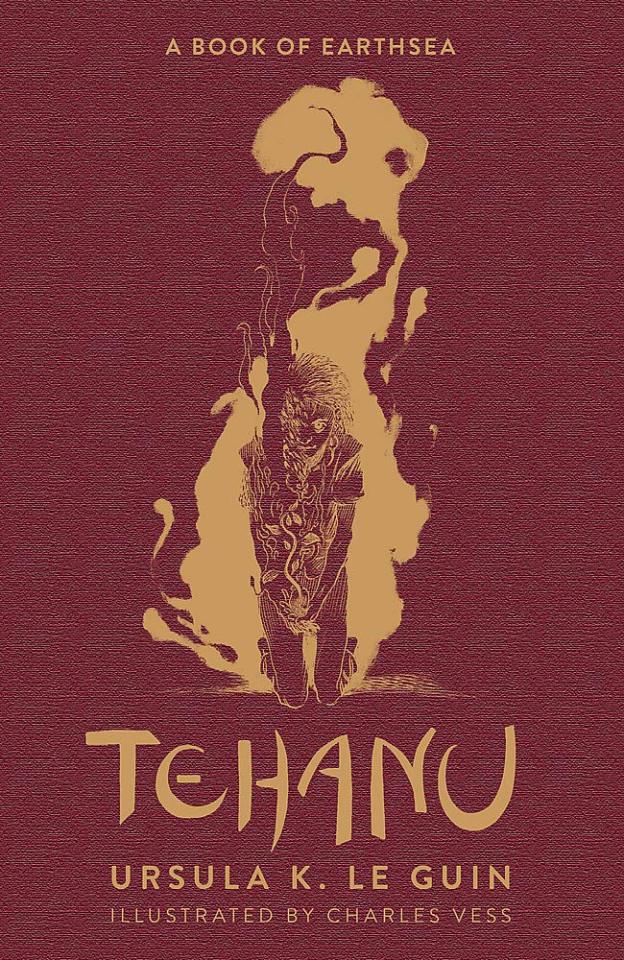
Title: Tehanu (Earthsea Cycle #4) (1990)
Author: Ursula K. Le Guin
Genre/Tags: Fantasy, Fiction, Third-Person, Female Protagonist
Rating: 8/10
Date Began: 6/24/2021
Date Finished: 6/30/2021
Decades after The Tombs of Atuan, Tenar decided to settle down and live an ordinary life on the shepherding Isle of Gont. Now a farmer’s widow, she adopts a disfigured and horrifically abused child, who she names Therru. When a giant dragon deposits a grief-stricken Ged at her doorstep, Tenar finds herself in a strange situation as she cares for her old friend and her adopted daughter. But threats from Therru’s past and a malevolent force on the island soon threaten Tenar’s small family.
Despair speaks evenly, in a quiet voice.
Content warnings and spoilers below the cut.
Content warnings for the book: Violence and death. Mentioned murder. Severe child abuse. Descriptions of traumatic injury and disfigurement. Mentions of r*pe, including of children. Trauma, sexism, and ableism are explored in depth.
Tehanu is a much different book than the trilogy that precedes it. Perhaps this is unsurprising, considering the 17-year gap between this book and The Farthest Shore. I’d describe the Earthsea series as “grounded fantasy”. While all of them take place in a magical world, the thesis of each book is universal; the fantasy always comes second. Tehanu takes this idea to an extreme. The story is about everyday life as a common woman in the Earthsea world, with fantasy barely factoring in. The pacing is intentionally slow and introspective, which is something I normally don’t like, but Le Guin is a consistent exception.
Key characters from the previous books make an appearance. Obviously Tenar is the biggest return, absent since The Tombs of Atuan. The Tenar in this book is older and much more mature, having decided to live a simple life in spite of her adventures and accomplishments. Ged returns, but he’s a shell of his former self, as he mourns the loss of his magic and the man he used to be. Even King Lebannen (formerly Arren, the main character of The Farthest Shore) makes a brief appearance, and is quite a palate cleanser after the horrible men throughout the rest of the book.
Probably my favorite aspect of the novel is the fact that these characters stand well on their own without magic to prop them up. Tenar explored the terrifying freedom she won in The Tombs of Atuan; got married, settled down, had kids — but still finds herself at a loss on what to do with her life after her husband dies. Ged is in a similar boat; he’s gone from an almost mythic character to an ordinary man, and like Tenar finds himself at a crossroads in life. Other characters embody this idea of transformation and uncertainty; Therru’s escaped her abusers and now has a loving mother, but what does the future hold for someone with her appearance? Stuff like that.
The idea of metamorphosis and new beginnings is well-trodden. But what makes Tehanu interesting is Le Guin primarily examines this with the middle-aged characters. Tenar and Ged are legendary figures in the world of Earthsea, but life has taken them to an uncertain future. The thrust of the novel lies in finding a purpose and becoming someone new. I also like that Tenar/Ged is endgame; I got Vibes from The Tombs of Atuan, but neither character was in a position where it would work. Seeing them form a romantic relationship much later in life is touching and cute. But it’s not the reason that either of them grow as people; finding one’s purpose is something one has to do on their own. Their relationship only develops once both parties have done so.
My main complaint about A Wizard of Earthsea, the first book, is the sexism inherent in the setting, which is never examined below the surface level. Perhaps Le Guin’s outlook changed, or perhaps the publishing environment did, because often Tehanu reads like a response to this criticism. The central theme of the book is misogyny, the patriarchy, and its debilitating effects on women. Le Guin examines everything from micro-aggressions (“common wisdom” that happens to paint women as inferior) to domestic issues (“women’s work” and how much that actually is) to outright sexual assault (both in threats and actual acts; it is heavily implied this is part of the abuse Therru endured). She even goes into how powerful women are only considered as such because a man gave them that power.
While I appreciate the fact she addresses these issues in such a frank, blatant way, at times reading Tehanu felt like reading a basic feminism primer. These subjects are all things I’m familiar with, and I feel like anyone who’s studied key feminist ideas would be aware of them also. Maybe 1990 was different? Le Guin doesn’t add any insights to the bleak reality of patriarchy and sexism, which is a little disappointing compared to previous books. That being said, this book is aimed at young adults despite its dark subject matter. Tehanu could be the first exposure to these ideas that many children receive; looking at it that way, it makes sense that the analysis comes off as basic.
I also found the book’s examination of gender to be very cishet-normative. That’s definitely not surprising, considering the book was published in 1990, but to a 2021 reader this hasn’t aged super well. There’s a lot of discussion about the relationships and differences between men and women--whether there are any or not, how magic differs between them, the ability to bear children, and so on. There’s a weird sexual component to this, like how wizards (who are exclusively men) have to remain celibate in order to… keep being wizards? But women who are witches don’t have to do that, and that’s an advantage women have? (There’s mentions of male witches too, iirc, but it’s not expanded upon— do they have to remain celibate? Who knows.). I found this whole bit pretty odd and unnecessary, although I realize a lot of my perspective on the matter comes from a modern view of sex and gender (and, y’know, being trans). Not all the gender takes in the book are bad, but they are limited.
I found Le Guin’s exploration of trauma and ableism through Therru to be more interesting. There’s a lot of examination about how society treats Therru, a survivor of unspeakable abuse. Her trauma is visible due to severe burns along part of her body, leaving her with a missing eye and disfigured hand. Tenar spends much of the novel wondering what future Therru has; no matter how capable she is and how much she acts like any other little girl, strangers gawk at her, or assume she “deserved” what happened to her. Therru becomes happier and more independent over the course of the novel, but relapses into a traumatized state when she encounters one of her abusers. As a survivor, it’s heartbreaking and distressingly realistic. As much as I like Tenar, I almost wish the novel was from Therru’s perspective (other than the brief jump at the end), but I realize it would spoil the ending.
I’m torn on the ending because, while I thought it was cool and had some interesting revelations, it’s a jarring tonal shift. As I mentioned, Tehanu is a slow novel with a heavy focus on everyday life, and the trials and tribulations both Tenar and Therru experience. There’s even a climactic event a few chapters before the end; the only thing left is a persistent loose thread from earlier in the novel. That subplot explodes to the forefront a bare chapter and a half before the end of the book, and a lot of action-y fantasy stuff happens. It doesn’t come out of nowhere; it’s set up throughout the novel, but it is sudden.
That being said, I do like that the subplot with dragons vs humans is hinted at as early as The Tombs of Atuan. When Tenar tells the legend about the origin of dragons early in the story, my mind immediately went to that one room from the Labyrinth with the sad winged humanoids painted on its walls. I’m curious if there are hints elsewhere in the series. I also figured out Therru’s true name and how she relates to that subplot based on context clues. While it’s not a shocking twist, it is a satisfying one. Though parts of it gave me a “magical destiny” vibe which is counter to much of the series so far; I do wonder how the last two books will address this. (Also… did Le Guin imply Kalessin is Segoy? AKA God? What did she mean by this. So Ged literally like… hitched a ride from God, who promptly yeeted out of the story until the end? That’s kind of funny. Maybe I misinterpreted something.)
I probably sound critical of this book, but I did genuinely enjoy it. It just didn’t speak to me the way the previous two did. The next book is a short story collection before the conclusion to the series, so we’ll see where it goes! Tehanu set some stuff up that I expect will be expanded upon in these volumes.
14 notes
·
View notes
Text
Fantasies, dreams and desires, ideas of normalcy and fears of difference. A slightly queer reading of 15x14
Mrs Butters is a delightful character who is built to parallel so many things in the show. She occupies perfectly the semantic sphere that the narrative has crafted around Dean’s desires; also, you know, cake.
We could talk for days about the significance of food and drink in Supernatural. One of the biggest themes that run through the entire show is hunger (or thirst) and food is very often a symbol for an emotional need of sorts. Supernatural draws a lot folklore, and human stories have always used symbologies that put together food, desire, love, sex, family, goodness and darkness and all those human experiences.
We have discussed the shit out of every instance of food in the show, analyzed parallels to other stories and fairytales, scrutinized queer-codings and subtexts, got called nasty names by impolite people accusing us of saying that a slice of baked good means Dean likes sitting on dicks. So, yeah, I’m not gonna start explaining everything from the beginning. Let’s jump to the parallels.
- The comfort food. Motherhood, hugs, and the past that can never return: the ideal of childhood and the 50s fantasy
We’ve already talked about how Mrs Butters functions as a parallel to Mary and a symbol of the ideal motherhood that both Mary and Dean struggled with. In Dark Side Of The Moon, we see a memory from Dean’s childhood, where we learn that Mary would cut off the crusts off his sandwiches. Mrs Butters also says that she cut the crusts off, establishing a direct parallel to Dean’s ideal of childhood and child-parent relationship. Or, we should say, as both Mary’s and Dean’s ideals of a child-parent relationship, because we know that Mary set up her life with John and the kids as an elaborate “scene” according to her idea-slash-fantasy of the perfect safe life.
She strugged with that, because her ideal life could never match with reality - she had loose ends from hunting to deal with, she at some level liked having those loose ends to deal with because as much as she hated the hunting life and craved for safety and “normalcy” that was still something she was in her element doing, probably more than the perfect housewife role. Of course when she came back she attempted to recreate the scene but quickly discovered that it was impossible and dropped all attempts to do so, embracing the opposite, or at least what she perceived as the opposite (having a pretty dualistic view of hunting life-domestic life where they cannot be reconciled).
Dean, on the other hand, started out with a similar dualistic view, figuring that he’d always belong to the hunting world and could never have the domestic, “normal” thing at all, embracing his “freakness” as opposed to the concept of normalcy represented by civilians, by the middle class, by the suburbs, by the apple pie, white fence life (insert heavy queer subtext here). And yet there was always an ambiguity with him (again, he’s never one-or-the-other, he’s always both), because, while on the surface he embraces this rebellious, devil-may-care persona, that’s not quite what he is as a full individual. He grew up essentially a housewife from a very early age, has a very caregiving personality, and thrives in taking care of others.
Dean is both Mrs Butters and Mary, where the difference between him and Mary is that Mary couldn’t (didn’t have the time, support, resources?) reconcile parts of her that Dean instead was able to (and in fact recently helped her with: before dying, she’d reached a pretty healthy balance of living her own life as a hunter and having a warm relationship with her sons, at least as healthy as it can get in that kind of circumstances).
Another important parallel to Dark Side Of The Moon, borrowed by Scoobynatural, is the nightgown that feels like being wrapped in hugs: we are reminded of Dean’s “I wuv hugz” from when he was a kid, a symbol for his early life of affection and safety that he lost with his mother. Childhood hugs, comfort food, loving gestures like cutting off the crusts are all symbols of a past that cannot return.
On a level, from a “coming-of-age story” perspective, childhood, with its innocence and perception that adults will always keep us safe, is obviously something that everyone needs to accept as something that belongs to the past and cannot return, to embrace instead the responsibilities and risks of adulthood in a healthy way. In a sense, Dean needs to go through all these steps - acknowledging that his mother was a flawed person, that in fact both of his parents were flawed people who made mistakes but he can forgive them for his own sake in order to be able to let go of trauma and carry on... - to become a healthy adult able to be a good parent to his own child.
(There’s also the cholesterol thing - Mrs Butters chastizes Dean for his diet, but we know that there’s a depth to Dean’s diet, not only his extreme appreciation of food due to experiencing food scarcity and insecurity as a child, but also the memory of his mother’s comfort food, such as the “Winchester surprise”, a monstrosity of meat and cheese. While the “meat man” persona would appear on the surface as a sterotypical masculinity thing, it has layers, in a typical Dean fashion... not coincidentally, in the latest episode he calls himself the meat man while wearing an apron that we’re told he’s very fond of, painting him, again, in a mixture of different meanings, masculinity and femininity, fatherhood and motherhood, devil-may-care attitude and caregiver attitude.)
On another level, a more political level, there’s the 50s fantasy element. We all know the significance of the idealization of the post-war period as the “good ol’ times” in American culture, and it’s an ideal that Mary definitely drew from when she built her perfect life with her family. Mrs Butters represents this in a very literal way, being literally from 1958 when she “froze” herself, and acts as a very stereotyped governess for a bunch of men that feel like they are above housework, what is considered women’s work. Dean initially comments “how progressive”, knowing exactly how bullshit these conversative ideals are, but then appreciates the comforts of the perfect caretaker.
In fact, Dean’s “giving in” to the comforts of a governess makes me think of that famous feminist manifesto “I want a wife” by Judy Syfers... because housework is very much Dean’s work in the bunker. It’s interesting that Mrs Butters immediately comments negatively on the cleanness of the bunker and their clothes: we know that Dean cleans and washes, and, while it’s likely that he cannot keep everything super perfect like a governess would because he’s busy doing many other things, it’s a way Mrs Butters uses to establish roles that she knows and is comfortable with. She is used to being the one who does “feminine” work while the Men of Letters have absolutely zero skills in that regard, and doesn’t really even stop to question if that’s the case with the men in front of her.
Anyway, let’s go back to the 50s fantasy. The show has repeatedly made commentaries on the vacuity of it. Peace Of Mind is the most obvious instance, but there’s plenty of subtext in the show that deals with that typically American aspect. Just like the childhood aspect, the narrative tells us that the “good ol’ times” are also an idealized thing that cannot return (if it ever existed, because Dean’s childhood was built on a fantasy, and the “good ol’ times” are also a fantasy, because the real 50s were horrible for anyone who didn’t swim in privilege). Mrs Butters cannot stay, the 50s fantasy-slash-childhood fantasy cannot last, and Dean embraces his role as an adult-slash-modern housemaker. Blah blah gender, blah blah cake. (Yeah, sorry, but you can fill in the blanks.)
- The contaminated drink. Poison and weakness from the forbidden sexual desire to the forbidden family domesticity
Aaaand now the second branch of parallels that Mrs Butters pinged on my radar, which sends us in an even more queer-subtext-heavy territory. We’re going to talk about the smoothies and the tomato juice. Yes, I know, the smoothies are given to Jack, not Dean, but symbolically Dean and Jack share the same semantic area; both are given a magically conjured drink, and both end up locked away waiting to be killed. For this analysis, they basically overlap.
Let’s start with the tomato juice. I don’t think that it’s a coincidence that Dean is given something that visually reminds of the blood the vampires drink. The tomato juice is a stand-in for blood, and blood in relation to vampirism has a long history of subtext in the show that connects to sexuality, sex, sexual fears and contamination. While vampires are not necessarily always invested of those meanings every single time they appear in the three-hundred-whatever episodes of the show, their main symbology is connected to sex and sexual fears, as vampires do in modern western literature, after all.
You’re probably going to think, wait, what? What has Mrs Butters got to do with sexual fears? Yeah, I know, it sounds weird, but hear me out.
The tomato juice - a stand-in for blood, with a vampire reference - parallels Mrs Butters (who represents trauma, remember) to 6x05 Live Free Or TwiHard. Sexual assault, blood, contamination via the poisoning liquid.
Next to the tomato juice there’s the smoothie. It’s a poison in disguise, a contaminated drink that makes Jack weak. We have, in fact, a pattern of Dean being given contaminated drinks that place him under another’s power. Not just the vampire’s blood, but also Jeremy from 3x10 Dream A Little Dream Of Me, who offers Dean a beer through which he connects him to his dreams. There’s Nick the siren from 4x14 Sex And Violence, who contaminates Dean through the flask. The venom in the siren’s saliva parallels straight to the gorgon Noah in 14x14 Ouroboros, and I don’t have to start explaining what all those things represent, right? (I have written posts about these things, it would be nice if tumblr didn’t suck and showed them to me when I go look for them.)
(Oh, there’s also Crowley’s human blood addiction, which is not, as one might expect, a parallel to Sam’s demon blood addition, but Dean’s First Blade/Mark Of Cain issue, and the First Blade/Mark Of Cain arc is all imbued by the queer subtext of the Dean-Crowley-Castiel triangle.)
Basically, Mrs Butters is inserted in a history of queer subtext, although it appears as obvious that Mrs Butters hardly represents homosexual desire, unless we go a pretty stretchy route of her occupying Cas’ space in the Dean-Sam-Cas-Jack family (I mean, that’s true, but it’s not simply that). It is also true that Mrs Butters represents Cuthbert Sinclair, and here the radar pings, because Cuthbert Sinclair is totally inside the pattern! He wanted to make Dean part of his collection just like the vampire in 6x05 wanted to make Dean part of his pack, with supernatural means of exorting control over Dean and heavy heavy rapey tones. (I know we don’t like to talk about this, but the show does play with incest subtext, John mirrors are often rapey.)
So, we have all this semantic area of poison, weakness and submission to external control painted in overtones of sexual assault and sexual fears especially in relation to homosexual desire. (I am NOT linking homosexual desire to sexual assult, nor the show is, it’s a wide and volatile semantic area where the common denominator is fear, fear of being hurt FOR being different sexually, it’s about vulnerability because of being different. It’s a horror narrative, guys, remember, queer fear is a recurrent theme in the genre. Dracula was about the horror of what happened to Oscar Wilde, we’re running in circles.)
Now, what kind of fear is explored in 15x14? Well, the episode is about the fear of losing family. The plot is about Dean’s feelings towards Jack after he killed Mary. Dean doesn’t know it yet, but he’s going to lose Cas soon also because of Jack. Mary and Cas are both very noisy absences in the episode, and we know that Dean is going to suffer something horrific again that will shatter his family again. This goes past the fears regarding forbidden sexual desire: we’re in the territory of forbidden familial desire, so to speak, Dean’s craving for a domestic peace with his family.
Jack is both the culmination of Dean’s process of family-building, as the son figure of the family, and the element of destruction of that family-building. Not a coincidence Jack’s birthday was referenced, as Jack’s birth coincided with Cas’ death and Mary’s supposed death or at least separation. Now Jack has supposedly killed Mary (or is it a inter-universe separation again? @drsilverfish’s theory always pops up, and we keep getting reminded of other universes - the telescope is broken...) and we know that Cas’ ultimate death hangs above us.
We’re always running in a spiral, Dean’s relationship with Mary, Dean’s relationship with Cas, Dean’s relationship with motherhood and gender roles, Dean’s relationship with sexuality. There’s a big picture of mirrors in the semantic area of fantasies, idealizations, desires and dreams. I hope I managed to make this post make sense, but I’m always open to requests of clarification or elaboration. Thanks for reading!
#my spn thoughts#spn meta#spn 15x14#queer subtext#dean and femininity#dean and masculinity#dean and food#dean and mary#dean and childhood#dean and sexuality#dean and family#spn
87 notes
·
View notes
Text
Kindred Words are Key
Week 3: Black Women of the Past By Keyyatta Bonds
To better organize my thoughts, I am going to layout my discussion points first (just so there’s a through-line): 1) Afrofuturism vs. Speculative Fiction 2) Reflection on BodyMinds, specifically how language choices and definitions guide a narrative 3) Hot Take about Kindred
After reading about Afrofuturism, (Black) speculative literature seems to be underneath its umbrella. The category itself doesn’t have many rules, as Schalk describes speculative literature as “allow[ing] us to imagine otherwise.” However, even though it seems boundless, in comparison to the realms described within Afrofuturism, it seems smaller and more compact to me. If you ask me for a particular point to make that distinction, I sadly could not tell you; but Afrofuturism seems to be a more complete encompassing of stories centered in Blackness. It may be the terms themselves as Afrofuturism’s name lends itself to its identity as a genre and (Black) speculative is very generic.
----
Schalk does a great job in the Introduction of BodyMinds in clearly defining her terms. Schalk, inadvertently, illuminated for me the faults of current literary evaluations and reviews. Not to get very English-majory, but a lot of descriptions used in storytelling and describing the stories thereafter are very static or fluff-filled. I would expect literary-minded folks to be more deliberate in how they relay, and especially, critique stories; but I have noticed that stories exploring ‘deep’ topics in fiction are often watered down to 2D descriptions OR overexplained and picked apart to the point that real messages get lost in the wordiness of it all. Moreover, if evaluations of a text go beyond the typical -isms, the relationships are explained very shallowly. To give a short example, Kindred could be described as a story about race and gender and racism – all of which are correct observations but provide no depth or intimacy within the story or its characters, which in my eyes, is doing it a grand disservice.
In this evaluation of the text, even though those topics can be seen as themes, it gives no clue to what characters are participating in these systems and the effects of these systems on the characters. Literary evaluations are meant to go that extra mile and provide a greater analysis of the text – but many people are attempting to discuss these topics without having (access to) the language to adequately support their ideas. [This line of thinking – in my mind – also greatly aligns with Schalk’s mention abut Barbara Christian’s approach to theory in that it does not have to be done in a certain way to “produce knowledge” and new idea do not need to be created but just looked at through a Black feminist lens.] I could get into my academia rant but I’ll save that for another day.
So, moving into Schalk’s definitions, I loved how she used and described bodymind. In lieu of Kindred, the word ‘bodymind’ perfectly gives way to what we already discuss as we analyze Black people and their relationship to slavery without the wordiness of it all. Schalk fills in that language gap and gives us the vocabulary to more adequately navigate the conversation without losing its sincerity. The word bodymind – alone – provides an intimacy and depth in relation to whatever character may be referenced. It more successfully explains how the two are connected and constantly interacting, even when we may think that an action – let’s take whippings for example – may only affect the body. It provides nuance to conversations and concepts we have likely discussed before, especially when talking about literature centered around the Black experience.
Traditionally, talking about slavery is already a large task, so to add psychological effects then generational trauma and so many other layers leads to an ever weaving web of conversations. The experiences are all connected but there’s a better way to describe the interconnectedness, which can lead into Schlack view on intersectionality. Her takes on these fairly new, but truly old, ideas is very refreshing – as I am finding a new and more effective way to discuss such heavy topics.
----
I am running out of words – but I had to touch on this. I absolutely despise, hate, cannot stand the white man saving Black woman narrative. I fully realize Kindred is much deeper than that and the focus is on Dana’s journey as a free Black woman now experiencing life as a slave – I get it and there’s a lot to unpack there. I am not trying to reduce the story to this one narrative at all. However comma, I could not focus on Dana because this white man is just taking over the story.
This is interesting to read because my friends and I have been recently trying to analyze why outspoken, “revolutionary,” smart Black women always end up in relationships with white men. Here’s my mini-theory: White men are the first, in that Black woman’s life, to acknowledge their words and talents over their looks; and for a Black woman, who is discouraged by her community like Dana, it is an overwhelmingly validating experience. The white man compliments their intellect from the very beginning, along with their initial attraction of course, but the white man is willing to listen to the Black woman’s story because they have no experience with it and appreciate a new perspective. (And we can see this in Kindred when Dana is trying to explain to Kevin the plantation dynamics and Kevin is not getting it until he arrives there with her.) The Black woman is over the moon that someone is listening to her thoughts and ideas and BOOM – they’re in a damn relationship just because they were appreciated. I need someone to do a case study because the correlation has got to be there.
Again, I have better takes on Kindred but that is something I wanted some outside perspective on.
10 notes
·
View notes
Text
Artist feature: Helena Baka
Artist Helena Baka shares with LFF about her inspiration as an artist through trauma, experiences, identity, femininity and more. All images and text (c) Helena Baka, helenabaka.com.
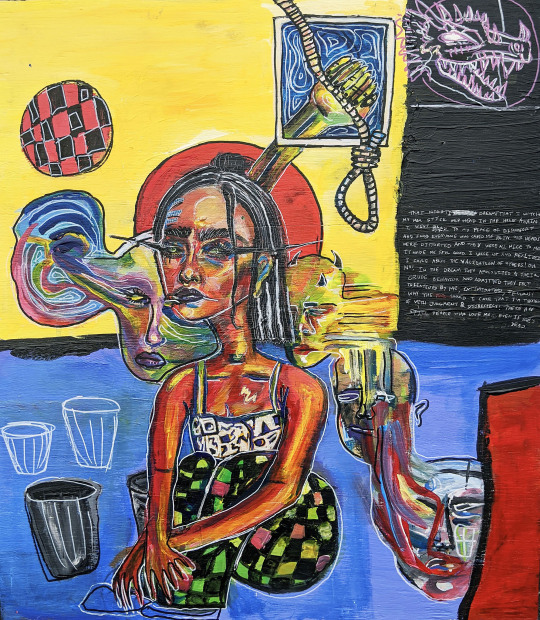
Where are you from and how did you get into art?
I’m from Elmwood Park, Illinois, but I’m currently living in Milwaukee, Wisconsin. Both of my parents were born and raised in Albania and immigrated from there before I was born, a few years after the collapse of communism. I’ve loved art since I was a child – I used to draw princesses, my favorite television show characters, Sanrio characters, and self-portraits. This was probably because both of my parents were artists - my father is a painter, and my mom used to make little angel Christmas ornaments and draw mermaids for my sister and me (although she stopped doing that very early on once she became a paralegal). All my life I had been surrounded by my dad’s oil painting landscapes of Albania hanging on the walls of our home, so I think I wanted to be just as good as him.
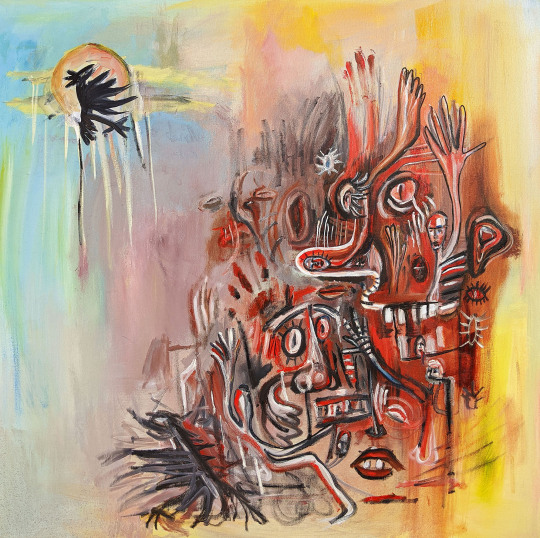
It’s been hard to be upfront about this, but my mom committed suicide when I was only 16 years old, and that was really the beginning of my painting practice because I started to draw inspiration from my traumas, dreams and experiences after that. Now, my work is motivated by my cultural identity and the distance I’ve experienced with my Albanian culture while growing up American. Lots of my current work shines on aspects of my identity, both relating to culture and femininity. I also have been exploring the relationship between sculpture and painting in my work because I’m fascinated with how bending the rules of traditional sculpture and/or painting can possibly make either of those fall into either category.
I have a few impetuses for creating; much of it derives from the need to tell my story, to use my practice as a form of therapy, to take risks and experiment with both familiar and unfamiliar mediums, and to educate my audience on whatever topic evokes strong emotions from me.
Tell me about your most recent exhibit.
4th Midwest Open at Woman Made Gallery in Chicago is the upcoming show I’m featured in, and I’m really excited for it because it’s going to be filled with so many different types of work featuring many artists of diverse backgrounds. It’s a chance to showcase the voices of women and nonbinary people in a space that is not male-dominated, which I think is so important because spaces like these are rare to find in the art world.
I hope when people see my work, it can spark some curiosity and self-education of what and where Albania is, and that it’s not just some impoverished Eastern European country that never made it into the footnotes of western history textbooks. My work touches on themes of loss, displacement, and frustration with one’s identity, as well as learning to accept and embrace who you are; that it’s okay not to fit into the mold of who or what you’re “supposed” to be. So, I hope at the end of the day, anyone who views my work can see a little bit of themselves in it, too. Most importantly, I want to be the Albanian woman artist role model that I never got to see growing up.
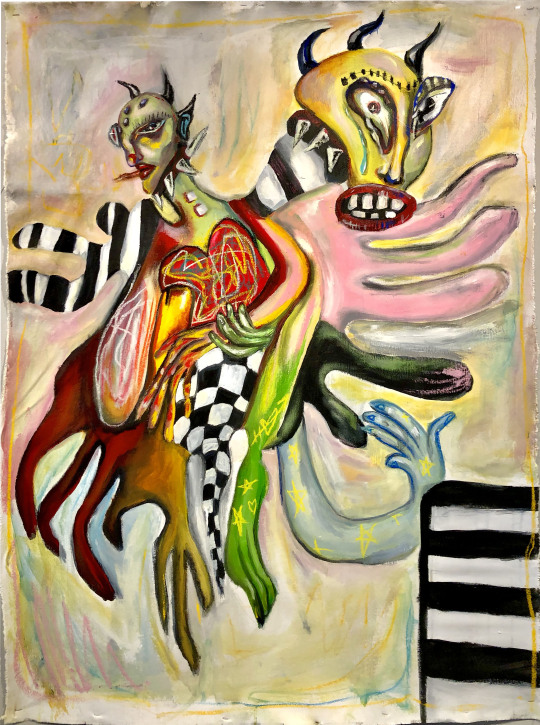
Does collaboration play a role in your work?
Although I have always worked independently in the studio, I’ve found collaboration beneficial to my practice through exposure of others’ ideas and methods of production. Being in my last year of art school toward my BFA, I have grown used to surrounding myself in an environment of plenty of working artists, and that alone inspires me to create, too. I think the act of critiques and even showing in-progress work has been a collaboration between me and whoever is critiquing my work, because most of the time I’ll come out of it with fresh ideas handed to me by another person. It works the same way vice-versa.
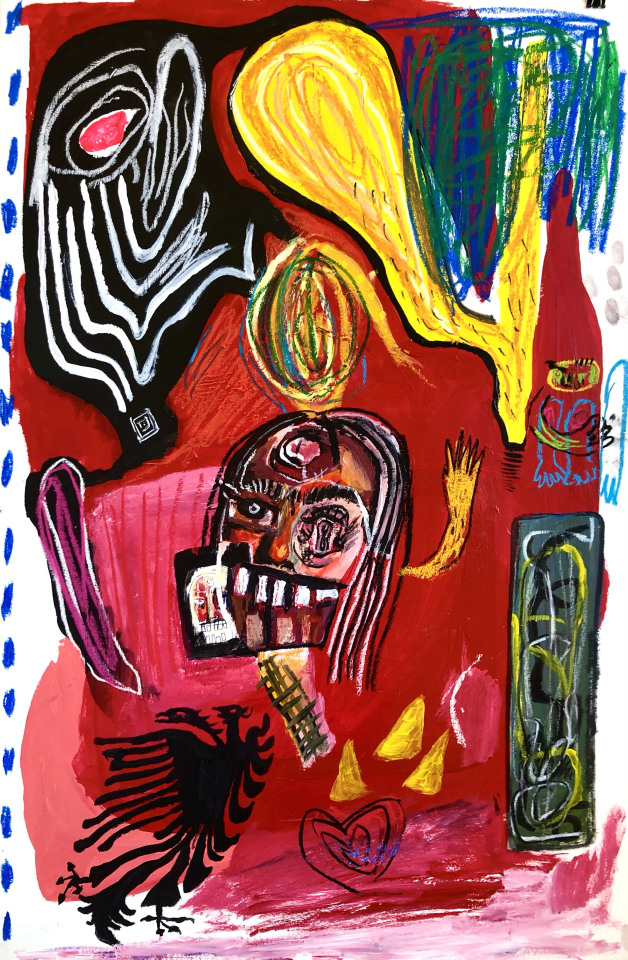
I once had my first ceramic sculpture fall apart in the kiln, and through a collaborative effort of mending it with my friend who was very familiar with working with plaster, my sculpture was repaired and I gained new insight toward this specific material and potential future uses in my practice. My work could never have progressed the way it has without the exposure of different ideas, methods and materials that other artists use.

What do you think about making work right now with the current political climate?
The political climate we’re living in right now has brought on so much outstanding work that has been made by BIPOC creators. Through the darkness of the pandemic, a corrupt, unfitting president in office, systemic racism, police brutality, and all of the tragic deaths we’ve experienced in 2020 from these events, one of the few instances of light the world gained out of these tragedies was the art made by black folx and BIPOC. From music to writing to visual art, BIPOC’s voices have been uplifted and encouraged on every accessible platform, and I continue to see more and more spaces made exclusively for these communities in the art world. Art really makes a difference in impacting our ways of thinking and beliefs, and I believe that if we continue to make BIPOC creators and voices a priority after Black Lives Matter is no longer a trending topic, there could be huge changes in the art world that provide even bigger opportunities for BIPOC creators, such as solo/group exhibitions, publications, grants and rewards, and leadership positions, if not more.
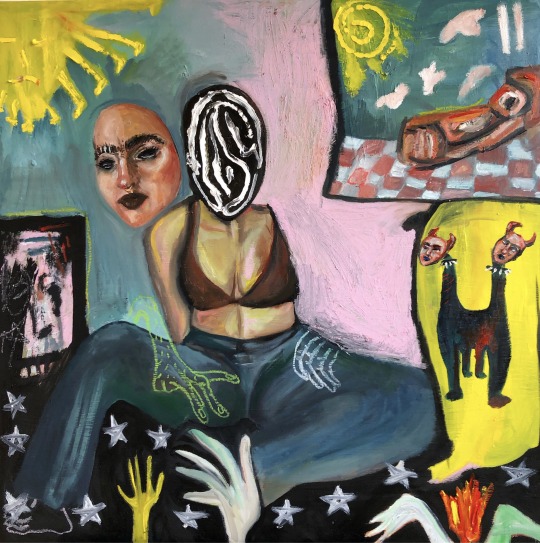
Is feminism relevant to your work?
Absolutely! I would categorize much of my work as feminist pieces because it discuss the contrasting distance and pride not only between myself and my cultural identity, but with my female identity as well that has been challenged and taken advantage of throughout all my life by others. Sexism, misogyny perpetuated by both men and women, double standards, and body image dysphoria as a consequence of these things have all been themes I’ve had to work through in my life and practice.
I can’t speak for every womxn or nonbinary person, but most who are or have once been feminine presenting in their lives have experienced a hypersexualization of themselves and their bodies through the media, culture, and the overall tainted perspective of the patriarchy we’ve been trained to look through. Instead, my work inevitably sees through the lens of the female gaze, where there is no objectification or negativity associated with the female/feminine body or experience, and instead the viewer is presented with this sort of chaotic, distortion of the faces and bodies of my characters, who are often abstract depictions of self-portraits.
What’s the best advice you have received about being an artist?
Strive to make work better than the last and only compete with yourself. Never measure your talents and successes to someone else's.
helenabaka.com
instagram: @artbug666.
~

Les Femmes Folles is a volunteer organization founded in 2011 with the mission to support and promote women in all forms, styles and levels of art from around the world with the online journal, print annuals, exhibitions and events; originally inspired by artist Wanda Ewing and her curated exhibit by the name Les Femmes Folles (Wild Women). LFF was created and is curated by Sally Brown Deskins. LFF Books is a micro-feminist press that publishes 1-2 books per year by the creators of Les Femmes Folles including the award-winning Intimates & Fools (Laura Madeline Wiseman, 2014) , The Hunger of the Cheeky Sisters: Ten Tales (Laura Madeline Wiseman/Lauren Rinaldi, 2015 and Mes Predices (catalog of art/writing by Marie Peter Toltz, 2017). Other titles include Les Femmes Folles: The Women 2011, 2012, 2013, 2014, 2015 and 2016 available on blurb.com, including art, poetry and interview excerpts from women artists. A portion of the proceeds from LFF books and products benefit the University of Nebraska-Omaha’s Wanda Ewing Scholarship Fund.
Submissions always open! - Check out the 10th anniversary call here:
https://femmesfollesnebraska.tumblr.com/callforart-writing
5 notes
·
View notes
Link
Dawn had only just broken over the mountains. While most of the women and children on the camping grounds were still asleep, others were already wide awake, huddling together in the first rays of sunlight and drinking coffee.
To a casual observer, this place might have seemed similar to any mainstream festival campsite. A distinguishing factor, however, was that there wasn’t a single man in sight. The sign on the main entrance left no one in doubt that only women and children were welcome at this event: “Men not permitted to enter.”
Women’s participation in Mexico’s 25-year-old Zapatista National Liberation Army, or EZLN movement, has represented an incredible organizational achievement since its original uprising in 1994. On International Women’s Day, the female militants of the EZLN did not fail to meet expectations when welcoming 7,000 people to the “First International Political, Artistic, Sports, and Cultural Encounter for Women who Struggle.”
Two thousand indigenous Zapatista women from various parts of Chiapas state and 5,000 visitors from all over the world came to Caracol Morelia, near the northeastern town of Altamirano, to hear what they had to say.
Uniting women
The event was entirely initiated by women of the EZLN. They planned it from beginning to end, and made sure everyone who attended was allocated a sleeping place, had access to drinking water and was cared for in the case they fell sick during the three days the event took place. Zapatista events such as these have commonly been accessible via invitation only. This event differed from most of the EZLN’s previous “Escuelitas,” or “Little Schools,” summoning all women and children who were interested in the struggle to overcome misogynistic culture.
“What we wanted was to meet many women,” said Commander Jenny, who coordinated the event. “We thought that only a few women were going to come, so we are very happy to see how many of you have joined us here.” Although only her eyes were visible, a smile was detectable behind her black balaclava. “It has been hard work, but we are very pleased to see that there are many other women who are fighting patriarchy.”
The event was not only an opportunity to create educational or professional networks, but also a space to consider one’s health and well-being as a woman in the fight for justice. There were activities ranging from workshops, discussion panels and movie screenings to theater performances, art exhibitions and sports events, including basketball and soccer matches. Themes included gender violence, self-defense, self-care, sexism in the media, sexual rights, health and education, misogyny and childhood, discrimination against indigenous LGBTQ communities, women environmental rights defenders, and decolonization. All of the activities were led and held by women, and all of them were aimed at generating consciousness of gender inequality or the restoration of women’s self-confidence and autonomy.
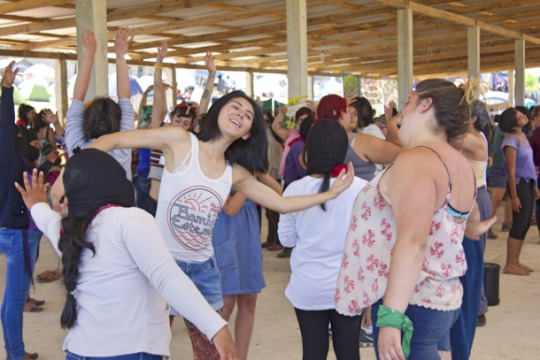
“Capitalism is not only colonial, it is also patriarchal and racist,” said Fernanda Esquivel, a 20-year-old student from Guadalajara. “To come here and see that the Zapatistas are still resisting and have resisted for so many years is a huge inspiration for me. Being with so many women and feeling united also makes me feel hopeful about really creating a change. In academia there is nothing that can show you what it is like to come here, and to feel and share these experiences in practice.”
Young women like Esquivel have grown up watching the Zapatistas evolve and followed their fight through media reports, the Zapatista’s own communication channel, “Zapatista Connection,” and more recently a Facebook page and YouTube account. Women from a total of 42 different countries, some of whom were already familiar with women’s movements or other social, political or environmental activism, attended the event in hopes that they would gain skills and inspiration from the women’s Zapatista struggle.
“Apart from wanting to amplify my vision of how different fights against the extractive industries are developing,” said Katherin Cruz from the National Network of Women Human Rights Defenders in Honduras, which accompanies women human rights defenders involved in territorial conflicts. “I came here so I could recharge my batteries and take home experiences that strengthen me individually and prepare me for the work that I do, and for my political activism within the feminist movement in Honduras.”
The birth of the EZLN
In 1983, a group of indigenous peasants in Chiapas organized in secret, educating themselves politically and creating an entirely unique philosophy that insisted that “another world is possible,” one that focuses on collectivity, serving the Zapatista community and creating an autonomous social and economical environment for themselves within neoliberal and capitalist Mexico. Finally on January 1, 1994 the group went public, calling themselves the Zapatista National Liberation Army, named after the hero of the 1910 Mexican Revolution, Emiliano Zapata. That day, the EZLN launched an armed uprising, occupied seven towns in Chiapas, including San Cristóbal, and declared war on the Mexican government.
During their brief occupation, followed by a 12-day battle, the EZLN criticized the effects of global capitalism on local farmers and indigenous land. They drew attention in particular to the North American Free Trade Agreement, or NAFTA, calling it a death sentence for the indigenous peasants of Mexico. NAFTA would be responsible for dismantling collective land rights secured by the Mexican constitution and prioritizing export manufacturing. The Zapatistas fought for a fairer distribution of wealth, as well as the right to political participation for indigenous people in Mexico.
After their initial uprising, in 1996 the Zapatista organization gained constitutional recognition from the state through the San Andres Accords and formed the National Indigenous Council. The Mexican government did not comply with the agreements and the Zapatistas continued to suffer from violent attacks, such as the Acteal Massacre in 1997, where 45 Zapatista sympathizers were killed in Chiapas. Since then, they have peacefully organized mass marches and protests, created their “caracoles,” or administrative headquarters, formed autonomous governance, justice, health and education systems and launched public campaigns drawing attention to continued racism and discrimination in Mexico. According to the Mexican newspaper El Universal, the EZLN now governs over 250,000 indigenous people living in the Autonomous Rebellious Zapatista Municipalities in Chiapas.
Today, the image of the Zapatista soldiers, clad in red scarves and balaclavas, has reached some of the most remote corners of the world. Their movement is now well known for its transition from armed struggle to nonviolent resistance to advance their demands for indigenous land rights and autonomy, which has triggered tremendous support and solidarity from anti-capitalist activists globally. However, many of the major issues for indigenous communities addressed by the Zapatistas, such as abandonment and marginalization, continue to exist in Chiapas and other parts of impoverished Mexico.
Women’s involvement and participation
During the gathering, Commander Marina took the stage to tell the story of the first female Zapatistas, their struggle for recognition in a male-dominated space and their experience of clandestine meetings prior to their public appearance in 1994. “We took our safety very seriously so that no one would realize where we were going. We had meetings in the mountains, these were very important. We had talks on politics, read books and watched films. We studied the situation of poverty our community was submerged in,” she said. “There was nothing to gain trying to demand things from our bad government.”
The backdrop of the women’s movement within the Zapatista struggle reveals extreme levels of violence against women, poverty and abandonment from any sort of federal health or educational institutions. Intersectional discrimination for being poor, indigenous and women was commonplace, and girls were often forced into marriages or sold by their fathers or families. During the opening ceremony of the encounter, the Zapatistas made it clear that women were sidelined and perceived by the community as second-class citizens. According to Commander Flor, even “midwives would charge less when girls were born.”
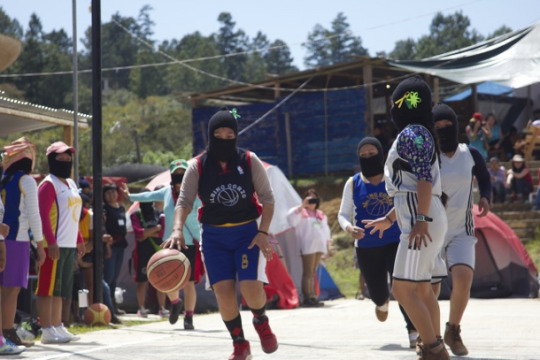
Their struggle has led the women in the ranks of the EZLN — which comprise about a third of the organization’s participants — to see themselves from a different perspective and shed light on the problematic behaviour caused by gender inequality. “At the beginning, we were not used to saying our opinions, or having discussions. We would all agree to everything and nod our heads,” Marina said. “We had to fight among our own compañeros, since it took a lot for them to understand the rights we have as women. There is a lot left to achieve but we are convinced that we will accomplish our ideals because we are organized, and we are strong as a collective. We have put fear and doubt aside.”
Many followers of the Zapatista revolution were not aware of the key elements that formed the movement before going public in 1994. Undeniably, one of the key characteristics that shaped the movement was the “Women’s Revolutionary Law,” passed by the Zapatista committees in 1992.
For Sylvia Marcos, a sociologist and expert on indigenous movements across the Americas, the emphasis on women’s rights is a defining factor for the organization. Furthermore, she indicates that these rights were claimed not solely for women as individuals, but were “fully linked and interwoven with collective rights.”
The unique transformations achieved by the Zapatista indigenous movement are manifest in its attempt to re-imagine gender and decolonize oppressive discourse for the sake of personal empowerment.
Enduring inspiration
Over the last three decades, the revolution continues to abide by laws made by the autonomous Zapatista government. With military strategist and spokesperson Subcomandante Marcos “resigning” from his activities, the Zapatistas have moved out of the media spotlight. However, the successful turnouts for their events prove that the Zapatistas are still an important source of inspiration for social mobilizations and women’s movements today.
Not simply an iconic reminder of what indigenous communities were up against in the past, the Zapatistas are engaging in great efforts to revise their strategies and continue to create networks of people who resist, especially among women. Though alternative visions of gender relations have flourished among the Zapatistas, women in the movement continue to suffer gender violence and are battling other issues not uncommon in Chiapas, such as malnutrition, and lack of access to health care and education.
The Zapatistas are addressing some of these issues through their own internal initiatives. Part of their collective work towards independence and sustainability relies on their agroecological farming projects, coffee sales, cooperative shops, community kitchens, traditional medicine and tortilla businesses. However, the fundamental purpose of the Zapatista movement is to promote their way of life and organize collective resistance to resource appropriation, historically-determined economic and social disadvantages and institutional neglect, which exacerbate poverty, sustain the governmental elite and destroy local traditions. Much of their work revolves around inspiring new generations to begin their own journey towards deconstructing norms in their respective societies.
The Zapatista movement currently functions like an organization that promotes constructive dialogue, communication and continued reflection on problems that affect their communities, as well as a support network for other national movements, including the water conflict affecting the indigenous Yaqui community, the 43 Ayotzinapa students missing since 2014 and the recent presidential campaign by the indigenous activist Maria de Jesus Patricio Martinez.
Women’s participation within the EZLN has played a key role in their success and ideology. They have made it clear that there will be no democracy without them. What the event last month demonstrated to many of those who were present, was the need to create safe spaces for all women, which allow them to heal and inspire them to continue fighting their own battles in their own ways. “We made an agreement, and that agreement was to live!” Commander Marina said. “And since, for us, living is fighting, we agreed to fight — each of us according to our means, our place and our time.”
2 notes
·
View notes
Text
Whenever I discuss Sleeping Beauty with someone who doesn’t share my enthusiasm for Disney, they have an irksome tendency to get it muddled with Snow White; their excuse being “it has the same plot”. I’ll admit, there are some surface similarities that even the most casual viewer can pick up on: a fairytale where a princess is forced into unconsciousness and wakes up with some necking, the comic relief and villain being the most beloved characters, a little frolic in the forest with animals, the antagonist plunging off a cliff, you get the idea. In fact, Sleeping Beauty even reuses some discarded story beats from Snow White, mainly our couple dancing on a cloud and the villain capturing the prince to prevent him from waking his princess. Yet despite that, Snow White and Sleeping Beauty are two wholly different movies shaped by the era and talents of the time.
I’ve discussed how Walt Disney was never one to stick to a repeated formula, no matter how successful it was. He must have noticed the parallels between his first movie and this one, but decided to make one crucial change for Sleeping Beauty that would forever differentiate the two: the look. We all know the traditional Disney house style: round, soft shapes, big eyes; charming as it was and still is, Walt was sick of it after several decades. Meanwhile, artists like Mary Blair and Eyvind Earle were producing gorgeous concept art that rarely made a perfect translation into the Disney house style.

Walt wanted to make a feature that took the pop artistry of their designs and made the animation work for it instead of the other way around – which brings us to another animation studio that was doing well at the time, United Pictures Animation, or UPA.
UPA didn’t have the kind of budget Disney normally had for their animated projects, but what they lacked in fluidity they made up for in style. Watch The Tell-Tale Heart, Gerald McBoing-Boing and Rooty-Toot-Toot to see what I mean. UPA were pioneers of limited animation, taking their scant resources and creating some striking visuals with bold geometric designs. Through this, they defined the look of 50’s animation. Though perhaps unintentional, Sleeping Beauty comes across as Disney’s response to UPA, or what would happen if UPA had the funds they deserved. The characters’ contours are angular but effortlessly graceful, defining their inherent dignity and royalty. And the colors, ohhh the colors…
Because of the immense amount of work required to animate in this difficult new style (and in the Cinemascope ratio, no less) as well as story troubles and Walt barely supervising the animation studio now that he had his hands full with live-action films, television, and a theme park, Sleeping Beauty had a turbulent production that lasted the entirety of the 1950s. For a time, Chuck Jones of Looney Tunes fame was set to direct. Director Wilfred Jackson suffered a heart attack partway through production and Eric Larson, one of the Nine Old Men, took the mantle from there before Walt Disney replaced him Clyde Geronimi. And even after that, Wolfgang Reitherman teamed up with Geronimi as co-director to get the film finished after no less than three delays. Also, Don Bluth got his foot in the door as an assistant animator for this feature, beginning his short-lived but impactful tenure at Disney. Did all this hamper the movie, or did they succeed in what they set out to accomplish?
Well, one of the reasons why this review took so long was because I had a hard time not repeating “MOVIE PRETTY” and “MALEFICENT AWESOME” over and over. Make what you will of that.
The story begins as most fairy tales do with your typical king, Stefan, and his queen suddenly blessed with a baby girl after years of wishing for a child. They christen their daughter Aurora (middle name Borealis, localized entirely within their castle) and throw a huge celebration in her honor. People come from all over the kingdom to pay homage to the princess and OSMKFKSBFHFGILWBHBFC…
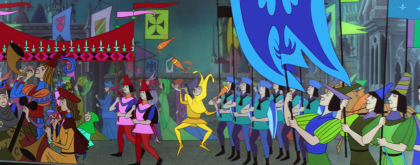
Movie pretty…
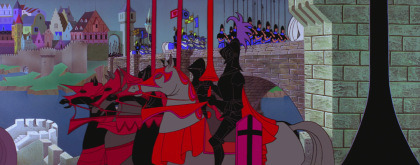
Movie pretty…
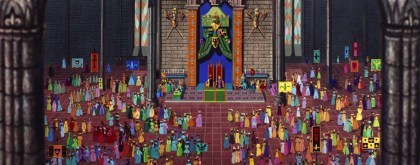
MOVIE PRETTIEEEEEE…
John Hench, Academy Award-winning special effects man and art director, turned Walt on to the idea of basing the look of Sleeping Beauty on classic medieval artwork. Thanks to him and Eyvind Earle’s insanely detailed designs and backgrounds, this is one of Disney’s most visually distinct and beautiful films. A single still from this feature wouldn’t feel out of place up in The Cloisters.
Among the party guests is King Stefan’s old friend King Hubert (Bill Thompson) bringing his young son Prince Philip. Stefan and Hubert wish to unite their two kingdoms and formally announce Philip’s betrothal to the infant Aurora.
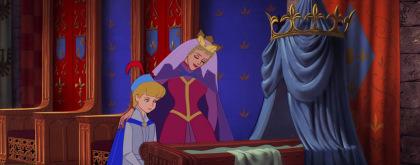
“We were going to do it during the second trimester, but we decided to wait until she was more mature.”
By the way, your eyes are not deceiving you. That is Aurora’s mother, Queen Leah, alive and well and named. And frabjous day calloo callay, she even gets some lines! The most common joke about Disney princesses is that they don’t have moms (even Ralph Breaks The Internet went out of its way to highlight that), so as a hardcore Disney fan who often has to put up with this generalization, Leah’s existence leaves me feeling vindicated.
Once that happy revelation is out of the way, we’re introduced to our main protagonists.
Oh, you thought I was referring to Philip and Aurora? Nonononono, my friends. THESE are the true heroes of Sleeping Beauty, the Three Good Fairies.
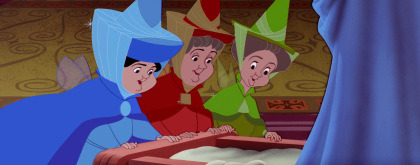
The fairies started off as one-note side characters sharing the same personality. Think pre-Ducktales-reboot Huey, Dewey, and Louie in dresses. But the studio had a difficult time giving Aurora more depth and was having a lot more fun developing the fairies. Naturally, they became so fascinating and appealing that more screentime was given over to them. Now the story’s carried by three wonderfully fleshed out ladies who are distinct in both looks and personality: Flora’s the pragmatic tradition-adhering leader, Fauna’s the sweet scatterbrain who mediates, and Merryweather’s the feisty young upstart.
With the plot now focused on characters who held a traditionally minor role, it’s easy to read this as a perspective-flipped version of the fairytale, but there’s more to it than that. Remember in my Clash of the Titans review how I mentioned the gods literally play chess using the heroes as pieces? I tend to view the main conflict of Sleeping Beauty in the same way. The Three Fairies and Maleficent are in a constant game of good vs. evil, moving Aurora, Philip, and the rest of the royals as pawns in their plans. There’s plenty of plotting and intrigue, with both sides constantly guessing and second-guessing the other’s next maneuver, and even if you’re already familiar with the story’s trajectory you’re still left on the edge of your seat as it inches towards the fiery climax.
And dare I say it but…the fairies and their power dynamic make this Disney’s most feminist film. Yes, really. You could argue that some of the other animated movies from the Renaissance and Revival period have more notable, stronger female protagonists, and many of the live-action remakes try to be woke without really grasping the concept, but consider this: The cast of Sleeping Beauty is mostly female, the leads aren’t objectified in any manner (that is if you count Aurora as a supporting character), nor does their gender factor into their competency, each one differs in age and body type, and most of them are working together towards a common goal as opposed to against each other. Name a movie in the past decade that does the same and still manages to be entertaining (no, really, I’d love to see it). There’s even one scene that unintentionally provides great commentary on the divides in the feminist movement, but more on that later.
Flora and Fauna bless the baby with beauty and song respectively which are accompanied by a short chorus and some sumptuous graphics. I don’t think I need to reiterate that when this movie goes extra with the visuals, it GOES EXTRA with the visuals. Next comes Merryweather with her gift. To this day, no one knows what Merryweather intended to give Aurora. Flora’s the most traditionally feminine of the three so her giving Aurora beauty comes as no surprise. By comparison, Merryweather is the most forward (or unconventional, depending on your point of view). I wouldn’t put it past her to favor Aurora with intelligence, or humor, or passion, or creativity or humility or confidence or decisiveness or physical fitness or great swordsmanship or telekinesis or ice powers or one million YouTube subscribers or comfort in her female sexuality.
Me personally, I think I’ve got the best gift of all:
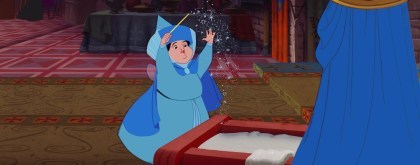
“O Princess, my gift shall be…getting all reviews posted on time for once!”
Alas, before Merryweather can bestow such a wondrous quality upon the child, she’s interrupted by a horny party crasher.
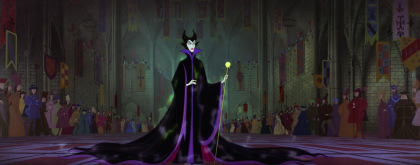
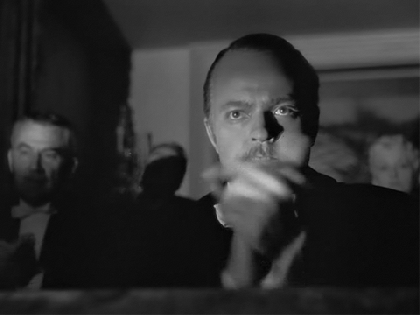
Maleficent. The Mistress of All Evil. Chernabog’s right-hand witch. The Disney villain all Disney villains strive to be. She has it all – the looks, the poise, the power, the laugh, the cunning, the ruthlessness! She doesn’t even need to sing a song because she’s already awesome enough without one. Marc Davis’ gothic design cuts a fine figure and Eleanor Audley’s subtle icy voicework is trés magnifique. As much as I enjoy Audley as Cinderella’s evil stepmother, Lady Tremaine was but an appetizer in comparison to the four-course banquet of pure villainy that is Maleficent.
This leads to a small point of contention some viewers have with Maleficent in spite of hitting top marks elsewhere: her motivation. Putting a hit out on a child for not getting invited to a measly party? Not exactly compelling, is it? And yes, it isn’t a deep motive…is what I would say if I wasn’t well-versed in folkloric tradition. In the original fairy tale and the movie (though it isn’t outright stated in the latter), the party for Aurora isn’t just your average royal kegger, it’s a christening. Back in ye olden days, christenings were very big deals. To not receive an invitation to one was a grave insult, so not extending an invite to your semi-omnipotent magical neighbor is just asking for trouble. In the fairy tale’s defense, no one had seen the evil fairy for years and assumed she was dead, though I can’t imagine how nobody thought Maleficent wouldn’t find about it eventually.
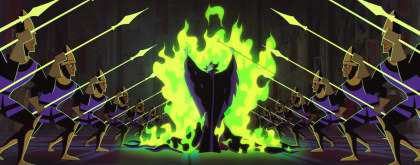
“You dare to deny me, foolish mortals? Very well, then! I shall have my own christening! With blackjack! And strumpets!”
Maleficent is proof that sometimes you don’t have to have an elaborate backstory, a god complex, a tragic past or the unfortunate luck to be on the wrong side of a conflict. Sometimes all you need is some magic, brains, class, and a whole lot of flair to be a perfect, intimidating, and unquestionably iconic villain.
Basically what I’m saying is these movies never happened. Got it?
Maleficent is disarmingly polite over being snubbed, even after Merryweather bluntly tells her nobody wanted her to come. She even brought her own gift for the baby – sixteen years of life cut short by the prick of a spinning wheel spindle, because why change into a dragon and destroy everyone all at once when you can draw the torture out over an agonizingly long time and deliver the coup de grace in the prime of a young woman’s life? That’s how Maleficent rolls, baby. She could dole out capital punishment when she has to without batting an eyelid, but causing human suffering is her bread and butter.
Stefan begs the fairies to undo Maleficent’s curse, but it’s too strong for them. Flora and Fauna insist, however, that Merryweather can use her gift to lessen the spell’s potency. Now instead of dying from that fatal prick, Aurora will sleep until she receives True Love’s Kiss™. Stefan’s not one to throw caution to the wind though, so he orders all of the kingdom’s spinning wheels to be burned in the meantime.
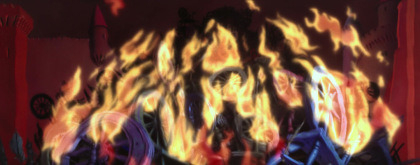
I just pray his kingdom’s economy wasn’t based on textiles otherwise they’re screwed.
As the peasantry celebrates Guy Fawkes Day several centuries early, the fairies ponder their next move. They’ve been around long enough to know that removing spinning wheels from the equation won’t put a damper on Maleficent’s scheme. This scene is incredibly effective in establishing two things:
Maleficent’s near-omniscient presence in the film
How well the fairies’ differing personalities play off each other
Maleficent rarely miscalculates her opponents, and that guile puts her one step ahead of the heroes, making her one of the few Disney villains to nearly reach their goal. The only mistake she makes in the entire movie is trusting her henchmen to do their jobs when she isn’t directly supervising them, though that’s more on them than her. The different methods the fairies propose to deal with Maleficent fantastically illustrate what kind of people they are. Fauna believes she’s just a miserable soul who could be reasoned with if they talk things over. Merryweather would rather take the fight to Maleficent and turn her into a toad. Flora, however, is wise enough to know Maleficent’s too wicked to plead to, too clever to bargain with and too strong to face head-on, so their best course of action is to focus on protecting Aurora through any means necessary. Her initial idea is to enchant the princess into a flower (her namesake is her specialty, after all), but Merryweather reminds her that Maleficent enjoys creating bitter frosts just to kill her flowers.
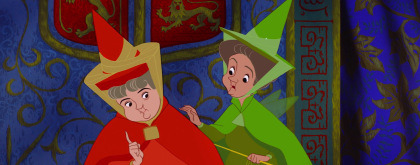
“Well we could try that but stick her in a castle with a beast for a while…nah, that’ll never work.”
Yet never one to give up, Flora alters the plan so they’ll raise Aurora as a peasant girl out in the woods. This means disguising themselves as humans and giving up magic for sixteen years so as to not attract Maleficent, but that amount of time is like twenty minutes to the fair folk. Stefan and Leah reluctantly agree to the plan, and the fairies spirit little Aurora away from the castle that very night.
Sixteen years later, Maleficent is infuriated that her minions have failed to locate Aurora, even more so when one reveals that they’ve spent the whole time looking for a baby instead of a maturing woman. In an interview with the Rotoscopers podcast, Don Bluth called Maleficent a very flat antagonist because she surrounds lackeys dumber than her so she could be the smart one among them and, again, her supposed lack of motivation. But come on, let’s not entirely condemn the bad guys for having too much faith in their underlings. It’s difficult to find minions smart enough to carry out orders but dumb enough to stay unquestioningly loyal. Usually you have to register as Republican in order to get some.
Maleficent gets her anger out in the most therapeutic way – throwing lightning bolts at her orcs, awesome – then leaves the job of finding Aurora up to her trusty raven Diablo. We then finally see the grown-up Aurora herself, whom the fairies renamed Briar Rose as a nod to the Brothers Grimm version of this tale.
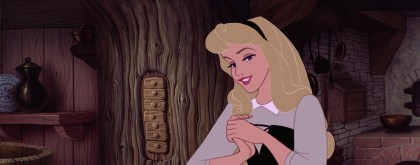
I know I’ve made the occasional case for the princesses from Walt’s era compared to the present day, and yet I have a hard time defending how…I don’t want to say bland. Bland would mean there’s nothing interesting about Aurora, and that’s a lie. She’s gorgeously designed and drawn, and even in her peasant dress she has an air of elegance and sophistication. She carries herself like a queen; her innate royalty reveals itself in her graceful movements. Mary Costa also gifts her with an excellent set of pipes. Hearing her song echoing through the forest is nothing short of magical. She’s a flower child who can talk to animals. She has dreams of escaping her adopted aunts’ loving but stifling care and being allowed to grow up, see the world, actually talk to people, and even find a life partner. She has some strong potential. It’s not that Aurora’s boring, she’s just not quite as developed as we’ve come to expect our animated female protagonists to be. I’m grateful for what we’ve got, but I only wish we could have more. What was her childhood like? How did she learn to communicate with animals? When did the fairies trust her enough to let her spend time out on her own? Did the fairies ever subtly teach her lessons in royalty through lessons and games? Heck, nobody bothers to keep her informed about Maleficent or her curse, and they act surprised when she’s shocked to learn she was a princess the whole time. I want to see what Aurora could have been like if she had known the truth already and what kind of steps she would take to defend herself. Blame the source material for this; it’s difficult to write a compelling main character when she’s supposed to sleep through most of her story.
The fairies send Aurora on a fetch quest so they can plan a surprise birthday party for her. Merryweather wants to bring their magic wands back out for the job, but Flora insists on taking no chances now that they’re in the home stretch. Fauna gets to live her dream of baking an elaborate cake (it’s thanks to her referring to a teaspoon as a “tsp” that I do it too), and Flora insists on making Aurora a gown fit for a princess using Merryweather as a dummy. And we also get one of the best burns in the Disney canon:
Merryweather: It looks awful! Flora: That’s because it’s on you, dear.
youtube
The fairies fall into reminiscing over raising Aurora and get teary over having to let her go soon. I see where they’re coming from, they’re the ones who raised her for sixteen years. They must have so many fond memories, not to mention they put all that work into learning to properly raise a child let alone live like normal human beings seeing how two of them still can’t sew or cook without magic. I wonder what that was like –
No, NO, you CGI abominations DO NOT exist! Go back to the fires from whence you came!!
“Ugh, I’m gonna need something strong to expunge that from my eyes.”
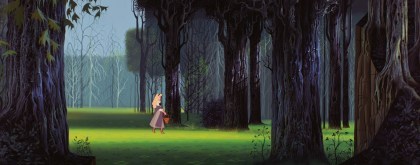
There we go.
Aurora wanders through the forest, drawing out the usual bevy of cute woodland critters with her singing. She also catches the attention of a grown-up Prince Philip (Billy Shirley) who’s more dashing and considerably less blonde than he was sixteen years ago.
By this point, the Disney animators were far more confident in their ability to draw realistic but expressive leading men, hence Philip’s expanded role from the story. He’s also the first Disney prince to have a personality; not a terribly deep or defined one, but it’s a step up from his nameless plot-device predecessors. There are some signs of him being a hopeless romantic, he gets a few funny lines here and there, has a sturdy friendship with his horse Samson, and is fiercely determined when it’s time to kick some ass. He does have the same problem as Aurora in he randomly decides to stop talking for the rest of the movie once he reaches the midway mark (at least Aurora has the excuse that she’s sleeping for that remainder), but I suppose you could chalk this up as to him wanting to spite Maleficent with his silence.
The animals steal some of Philip’s clothes so they can pretend to be Aurora’s dream prince. Aurora plays along as she sings the movie’s standout song, “Once Upon a Dream”. Philip and Samson watch until he smooths his way into the dance. Once Aurora discovers the switch, Philip gets a little too up in her personal space for my liking, constantly grabbing her hand so she doesn’t run off and pulling her closer to him. Not as horrible as what the prince does to the sleeping princess in the original story (a questionably consensual kiss is a trifle compared to how the scumbag of a prince treats her there), but still a bit iffy.
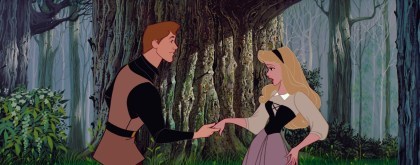
“It’s a good thing my aunts taught me to never go anywhere without a loaded pistol taped to my back.”
But once Philip backs off a little and joins in her song, they both dance together and OEHSGBJSGBLL…

I think I’m going to need surgery to get my jaw off the floor back into its proper place thanks to this movie.
As per Disney tradition, Aurora and Philip’s waltz means the two are head over heels in love with each other. But when it comes time to finally exchange names, Aurora panics and runs away, though she sticks around long enough to tell Philip to meet her family at the cottage that evening.
Back at home, the party preparations aren’t proceeding as planned. Flora’s dress looks as good as my attempts at dressmaking, and Fauna’s dessert wouldn’t feel out of place on Cake Wrecks.
A fed-up Merryweather reads Flora and Fauna the riot act and convinces them to finally take up their wands again. This produces more desirable results, though Merryweather still gets stuck with cleanup duty.
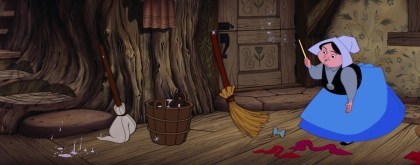
Enchanting a broom to come to life and do your dirty work? I don’t see this going wrong in any possible way.
Things start to go south when Flora and Merryweather argue over the dress color and it escalates into a full-blown wizard’s duel. This gag was supposedly based on the animators’ arguments over what was Aurora’s proper dress color. I think they should have compromised and combined both colors to make purple, which would go lovely with Aurora’s violet eyes, but what do I know. I’m just the illustration major writing a blog. Unfortunately, while the fairies remembered to cover every door, window, and crack that could expose their magic, they overlooked the fireplace. The sparkly residue of Flora and Merryweather’s fight fly up the chimney, alerting Diablo to their hideaway.
Going back to what I said earlier about this movie providing some commentary on feminism, consider this: Flora is obsessed with pink, a traditionally female color, and she gives Aurora an attribute that is oft preferred in a woman but not the most important quality, beauty. Merryweather, on the other hand, is all about blue, a color usually geared towards boys, and she has much more common sense and practicality about her. Though Merryweather and Flora are able to put aside their differences in personalities and approaches for a common goal, it’s when they refuse to compromise and begin prioritizing which color – ie. which ideology and extension of themselves – that they want Aurora to step into that they lose sight of what’s important, and allow everything they worked for to collapse on itself. It’s played for laughs very well, sure, but if not’s symbolic of the dichotomy between traditional femininity and modern sensibility that tears apart the feminist movement then I don’t know what is.
The fairies manage to fix their messes in time for Aurora’s return. She’s thrilled with their gifts but shocks them all when she announces her new boyfriend is coming over for dinner. They come clean about her heritage and betrothal to Prince Philip, and Aurora runs up to her room in tears over the fact that she’ll never see her one true love again. That and her entire life has been a lie and she’s being carted off to meet parents she knows nothing about to marry a man she’s never met and rule an entire kingdom with no prior experience or knowledge. But mostly the true love thing.
Meanwhile, Stefan and Hubert are making wedding plans over wine with “Skumps”, the preferred toast between me and my friends. Also adding to the humor is a minstrel who keeps stealing sips until he literally drinks himself under the table.
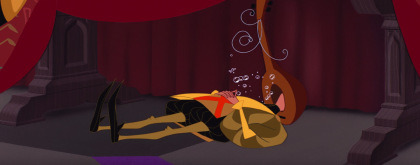
This was also his way of getting through the Black Plague, co-opted by the rest of the world six hundred years later.
Philip returns and Hubert goes to greet him. He thinks his son is thrilled at the prospect of marrying Aurora but is disappointed to learn that he’s fallen for an anonymous peasant.
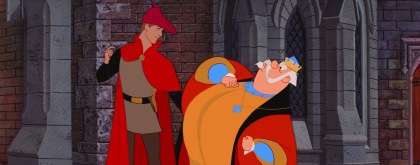
“At least tell me if she’s royalty in disguise so you don’t elope to Sicily!”
Philip rides back into the woods for his big date, leaving Hubert with the unenviable task of breaking the bad news to Stefan. As for Aurora, the fairies smuggle her into the castle and prep her for her homecoming. She’s still blue over having to ghost her forest hubby though, so the fairies give her some time to herself.
Biiiiiiiiig mistake.
So imagine you’re me, growing up watching this movie on tape on a television set with a very standard but not spectacular sound system. Then years later you download the remastered soundtrack and give it a listen while you’re falling asleep. You’ve got the whole score memorized, the volume is nice and low, it’s all good.
And then, just as you’re drifting off, you hear a ghostly voice singing in your ear “Auroraaa…Auroraaaaa…”

That reminds me, I haven’t had a chance to talk about the music yet, haven’t I? Forgive me for waiting so long to do so but my reaction to it is equivalent to the visuals. The score is taken straight from the Sleeping Beauty ballet by Tchaikovsky, the same composer as The Nutcracker, and it is lush, sweeping, sumptuous, just…

While George Bruns was mostly faithful with how the score was represented within the context of the ballet, at certain points he took the same approach as The Nutcracker Prince and rearranged the music order to underscore totally different scenes to staggering effect. The beautifully ominous music where Maleficent appears as a ball of green flame and leads the hypnotized Aurora to her doom? It’s from one of the ballet’s divertissements where Puss in Boots dances with his girlfriend. But tell me which is more fitting for a musical composition such as this – two cats pirouetting around each other in a crowded ballroom, or eerie pitch-black spiral staircases illuminated by green fire as a cursed princess inches closer to her dark destiny against her will?
youtube
The fairies realize their error and frantically search the maze of secret passages for Aurora. Though the princess resists Maleficent’s commands for only a moment, they are still too late to save her from fulfilling the curse. Maleficent gloats and leaves the fairies to wallow in their failure. It’s made even worse as the merrymaking from the oblivious revelers below ring out while they put Aurora to bed in a tower and mourn over her. It’s heartbreaking: they raised and loved her as if she were their own daughter, and they still couldn’t protect her. Everyone talks about “Baby Mine” and Bambi’s mom as huge tearjerkers, but why is this scene constantly forgotten?
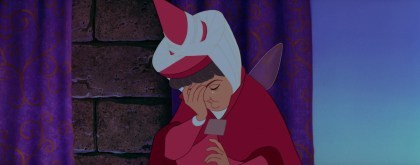
Stupid onions, stupid stupid onions…
Fauna and Merryweather can’t even begin to imagine how heartbroken Stefan and Leah will be, but Flora has a solution: put the kingdom to sleep along with Aurora until she is woken up. I understand her wanting to spare Aurora’s family some pain, but conking out an entire principality for god knows how long to cover up their failure? AND at a time when Europe was all about invading and conquering itself? Are we sure this isn’t just part of Maleficent’s overarching plan for revenge? This sounds more like something she would come up with instead of the leader of the good guys.
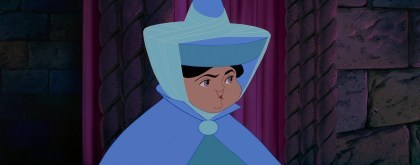
“So what happens if one of the neighboring kingdoms decides to attack while everyone’s sleeping?”

“Then we’ll put them and their armies to sleep, too.”

“And once Aurora is saved, both kingdoms will immediately wake up to find themselves thrust into a war they’re barely prepared for, is that correct?”

“Oh, you’re right, that’s a terrible idea.”

“Finally, thank you.”

“I’ll just turn them all into flowers.”

“THAT’S NOT AN OPTION!!!”
The fairies flitter about the castle grounds spreading their spell over the unwitting royal court, even putting the candles and sconces out. We have another reprise of the “Gifts of Beauty and Song” chorus now altered to sound like a lullaby, providing an interesting bit of symmetry between it and its earlier use in the film. Whereas it first underscored their blessings upon Aurora, now it plays as the fairies are giving the “gift” of sleep to the entire castle.
While Flora knocks out the throne room, she overhears Hubert muttering about Philip eloping with a peasant girl and she makes the connection. The fairies speed to the cottage just as Philip arrives there. But once again Maleficent beats them to the punch. Her goons ambush Philip and she watches them wrestle and bond him with fiendish glee.
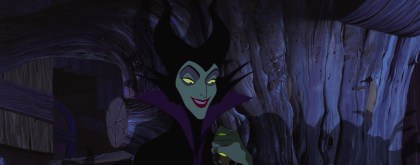
You magnificent, kinky bitch.
Maleficent was only out to capture the one man who could break Aurora’s curse; the fact that he’s really the son of her nemesis’ allies is just icing on the cake. Flora, Fauna, and Merryweather resolve to rescue him from Maleficent’s fortress in the Forbidden Mountain.
Some movies reach the brink of greatness only to falter when it comes to the final act. Sleeping Beauty is not one of them. Everything that happens from the moment we slowly zoom in through the purple mist on to the Forbidden Mountain itself up until the storybook closes is perfection. The perfectly paced action, the animation, the music, Maleficent’s hideaway in all its decaying glory (I swear it’s like Jean Cocteau meets Frank Frazetta meets Giotto) all make for the climax of climaxes.
The fairies shrink to insect size and silently sneak through Maleficent’s creepy domain, narrowly running into guards and gargoyles at every turn. They traverse the stronghold until they find her overseeing a hellish bacchanalia in honor of her supposed victory.
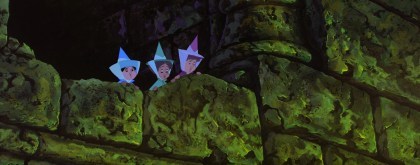
“My old gaffer would have a thing or two to say if he could see us now.”
Soon Maleficent gets bored and goes to “cheer up” her captive. Then we have it: The Moment.
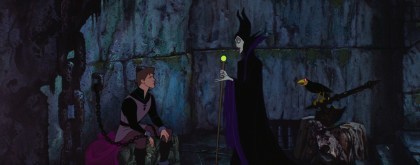
I’ve talked about this before, that one small, devious step further the villain takes to make themselves more heinous in our eyes. It’s the Wicked Witch taunting Dorothy with visions of Aunt Em. It’s the Beldam hanging Other Wybie’s remains. It’s virtually everything Heath Ledger’s Joker does. And it is this simple scene where Maleficent details what she plans to do with Philip. She spins “a charming fairy tale come true” of Aurora sleeping without aging, waiting for her prince to come to wake her. And Philip will escape the dungeon, ride to her rescue and prove true love conquers all – in one hundred years, when he’s a broken old husk of a man on the brink of death. DAMN. If you want to know why Maleficent is considered the best of all the Disney villains, it’s not just all her previously praised qualities, it’s her sheer sadism and the pleasure she takes in it.
The fairies enter and free Philip once Maleficent departs. The course of true love never runs smoothly though, so they arm him with the Shield of Virtue (licensed by Carefree Maxi-Pads), and the Sword of Truth to aid in his escape.
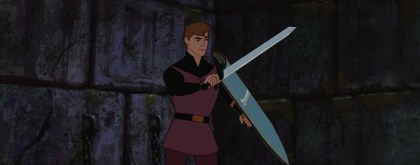
“So, why’s it called the Sword of Truth?”
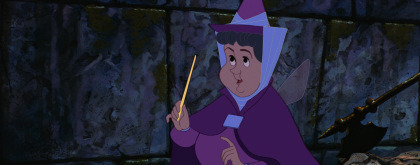
“Anyone who’s subjected to it speaks only the truth…as they bleed out and die, of course.”

“Cool, cool. On an unrelated note, I think I’m gonna go to DC for my honeymoon.”
Diablo sounds the alarm and the Battle With the Forces of Evil kicks off with Philip slashing his Sword of Truth through Maleficent’s goons.
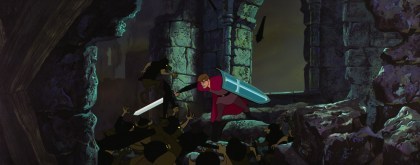
“I steal lunches from the break room fridge!” “I broke wind last Tuesday and blamed it on the dog!” “I cried like a little girl during The Good Place finale!” “I only wash my hands for NINETEEN seconds at a time!”
Philip makes his getaway on Samson and the music reaches truly operatic levels as Maleficent does everything in her power to end him. Yet Philip soldiers through it like a boss. Crumbling mountainsides, Maleficent hurling lightning from the sky and summoning a forest of thorns to block the way? Fuck that shit, he’s gotta go save his girl.
Then, as Philip cuts his way through the briars, Maleficent looks at her watch, realizes it’s No More Fucking Around O’Clock, zooms over to the castle, throws down the most intimidating challenge ever –

“Now you shall deal with me, O Prince, and all the powers of HELL!!”
– and with that, she takes her final form: a massive fire-breathing dragon.
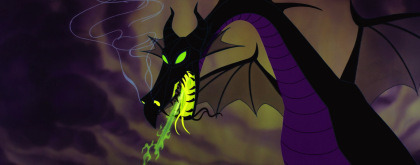
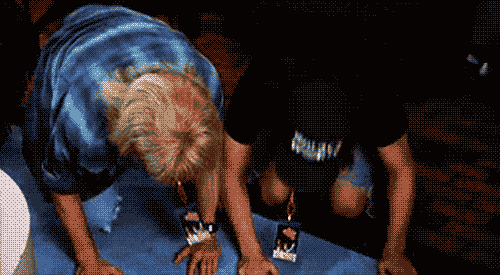
Every Disney villain who’s gone kaiju in the final act owes everything to this gorgeous terrifying beast. The dragon is an awe-inspiring unholy fusion of style, power and darkness. There’s a reason why she’s the final boss in Fantasmic; the chance to watch a live dragon battle is too cool to pass up.
Speaking of battles, Maleficent’s dragon form was animated by Woolie Reitherman, who previously brought us such gargantuan monster clashes as the T-rex brawl in Fantasia and the escape from Monstro The Whale in Pinocchio. And when you have a dragon confronting a fairytale prince, well, you know what’s coming.

Maleficent backs Philip on to a cliff surrounded by flames, leaving him only one desperate shot. With a little extra magic from the fairies, he throws his Sword of Truth at Maleficent and it plunges right into her heart.
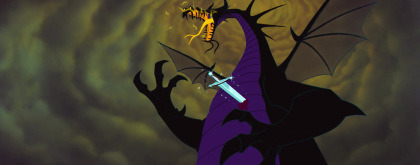
“I liked…Frozen 2…more than the first one…”
Maleficent’s spells die with her, clearing the way for Philip. He gives Aurora that wake-up smooch and everyone in the castle slowly rouses, owing their inexplicable simultaneous twenty-minute blackout to the unusually strong wine.
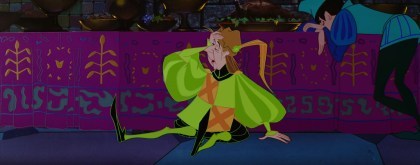
He can attest to that fact.
The royal families are happily reunited, and the film ends on Flora and Merryweather fighting over Aurora’s dress color yet again as she and Philip waltz together on the clouds using animation Beauty and the Beast would borrow thirty-two years later.
Sleeping Beauty is a movie I can never have on in the background because the moment I look up from my work I am spellbound by it. Do I need to elaborate on how this is one of the most beautiful looking and sounding movies Disney’s ever produced? Sleeping Beauty is the swan song of Disney’s first golden age of animation. For better or for worse, their animation process would switch to the rough, cost-cutting Xerox process starting with their next feature, 101 Dalmatians, and few films would reach Sleeping Beauty’s level of gorgeousness ever since.
Though a massive financial and critical hit on release, it wasn’t enough to make up for the monstrous production costs, not unlike Fantasia. Thankfully, home video sales revived interest and made it Sleeping Beauty of the top-selling VHS tapes of the decade, cementing it as a bonafide classic. It’s one of my favorites from Disney for its stunning visuals, gorgeous music, phenomenal villain and overlooked but great cast characters. Revisit it if you haven’t already.
Thank you for reading! If you enjoyed this review, please consider supporting this misfit on Patreon. Patreon supporters receive great perks such as extra votes for movie reviews, movie requests, early sneak-peeks and more! Special thanks to Amelia Jones, Gordhan Rajani and Sam Minden for their contributions!
Artwork by Charles Moss.
Screencaps from animationscreencaps.com
March Review: Sleeping Beauty (1959) Whenever I discuss Sleeping Beauty with someone who doesn't share my enthusiasm for Disney, they have an irksome tendency to get it muddled with Snow White; their excuse being "it has the same plot".
#2D animation#angelina jolie#animated#animated feature#animated movie#animated movie review#animated musical#animation#animator#animators#anthropomorphic animal#aurora#ballet#barbara luddy#battle#battle to end all battles#battle with the forces of evil#bill shirley#bill thompson#blue#briar rose#cake#charles perrault#classic disney#curse#diablo#Disney#disney animated#disney animated feature#disney animated movie
29 notes
·
View notes
Text
THE PERMANENT RAIN PRESS INTERVIEW WITH MADELEINE SIMS-FEWER AND DUSTY MANCINELLI
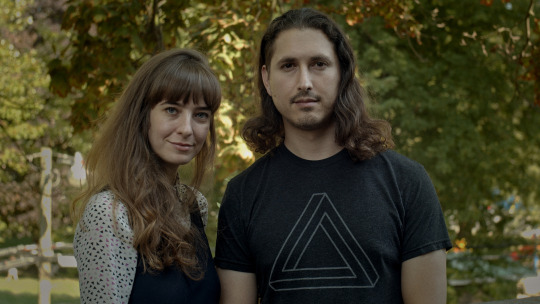
Violation is one of the most stirring films we’ve seen over the past year. Since making its world premiere at Toronto International Film Festival last year, the Canadian flick has been busy on the film festival circuit; now available through digital-cinema on TIFF Bell Lightbox, with Vancouver International Film Festival (VIFF) Connect to follow beginning March 26th.
What inspired the story behind Violation?
We were both dealing with our own personal experiences of trauma at the time, and wanted to make an anti-revenge film that deals with female rage, and emotional and psychological unravelling that trauma gives rise to.
We really wanted to make a revenge film that pushed the boundaries of the genre, challenging the tropes of the scantily clad woman becoming empowered by violent revenge against a menacing stranger, and that revenge is the cathartic climax we are all seeking at the end of the movie. Yes, it is a film about seeking retribution, but also about the cost of that retribution. It is a film about violation, but also about lack of empathy and selfishness, and how both can erode your morality and the relationships around you.
It’s been described as “twisted,” “feminist-minded,” and a “hypnotic horror.” At its core, how would you describe the film’s genre(s)?
Those three descriptors fit perfectly, actually! We weren’t thinking too much about genre when we wrote the script, mostly about the story and about how we portrayed Miriam’s journey. We were inspired by films that don’t sit comfortably in a genre box, like Caché, Fat Girl, Don’t Look Now. Films that are dramas with elements of horror.
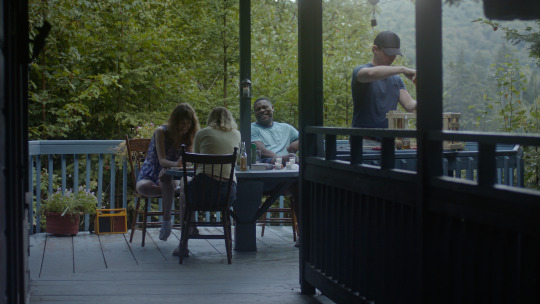
When you were writing the script, can you elaborate on the dynamics between the two couples that you wanted to portray – Miriam and Caleb, and Greta and Dylan?
Miriam and Caleb are very much at an impasse in their relationship. The spark has gone out and they don’t know how to reignite it. Instead of doing the work it might take to get through a rough patch Miriam is very much running away. There is a real transience to modern relationships that we wanted to capture in their dynamic - this idea that when the romance is gone the relationship has run its course. Miriam wants to fix it, but doesn’t know how - she clumsily tries to fix it with sex (on her sister’s advice), and this echoes how she tries to fix her trauma too.
Greta and Dylan have a seemingly healthy relationship. But when you look a little deeper their outward affection and codependence masks a deep distrust. Dylan is having his ‘grass is greener’ moment, and he’s totally selfish to the impact this has on those around him. Greta can sense this, but she’s too enamoured by him to risk rocking the boat. It’s all a recipe for tragedy really.
Miriam and Greta have a complex relationship, to say the least. It’s natural to have distance between siblings as they grow older, did you always intend to have a sibling relationship be a centre of your story?
Yes, we always wanted to make a film about a person who suffers sexual assault and is not believed by their sibling. That was one of the first parts of the story that came together. There is so much to unpack in a sibling relationship like theirs. A rich history of mutual failures and resentments as well as so much camaraderie and love. The more painful betrayal in the story comes from Greta, not Dylan.
We wanted to explore the idea of trauma within families, and how abuse and violence affects everyone in the family, not just the person who suffers it. Everything else orbits around these two sisters — Miriam and Greta — as Violation mines the little resentments, commonalities, shared joys and sorrows that weave together a truthful portrait of these women.
A lot of the horror and dread in Violation comes from the way the sisters interact, and in the ways they react to each other from a place of fear. There is no filter in these close sibling relationships (we know this as we both come from big families!) which can be wonderful, but can also lead you to hurt and be hurt in ways that leave permanent emotional scars.
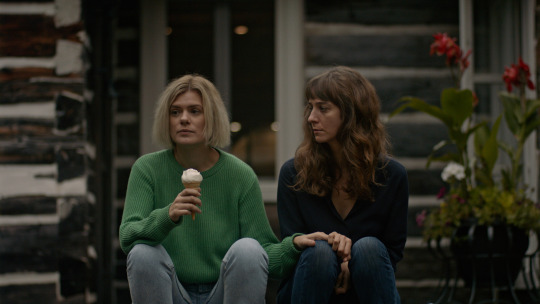
The non-linear editing engages viewers into the story, as do the jarring intercuts with imagery of nature, animals and insects. Tell us about the editing and post-production phase, and what you hoped to accomplish with the progression and symbolism.
The way we have edited Violation is very deliberate. We are forcing you to experience things you might not want to in a very specific way, guiding you through this post traumatic landscape where the past and present are constantly speaking to each other.
We chose to weave two timelines together — the 48 hours leading up to the betrayal and the 48 hours surrounding the act of revenge. This forces the audience to re-contextualize what they have seen, challenging their own opinions of the characters based on what information we choose to reveal and when.
Violation is told completely from Miriam’s perspective — we watch her emotional and psychological unravelling as she struggles desperately to do the right thing. There is a sequence in the middle of the film where we see this act of revenge. There is no dialogue for a long time, we just follow Miriam as she goes through these meticulous actions. And what we realize is that her plan, though well thought-out, is unbelievably emotionally and physically taxing. She’s not prepared, and we watch the real horror of her actions play out through her visceral emotional responses. It was important for us to really force the audience to experience things as Miriam does. The editing is focused and relentless; never letting you stray from her experiences and emotions.
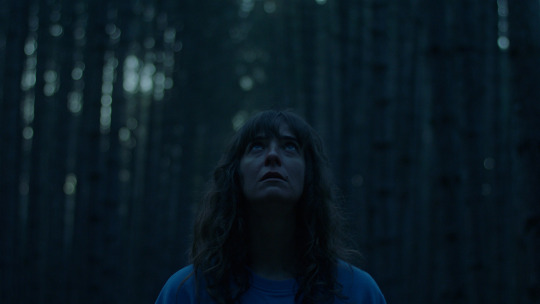
Madeleine, for you, getting to play Miriam and connect with her pain and turbulent emotions through the course of the film, can you share your thoughts on that experience. How did committing to this character challenge you as an actor?
It was the most challenging role I have ever played, and in many ways was absolutely terrifying. I wanted to push myself as far as I could go as an actor and challenge myself to really find the truth of who this woman is, and reveal that to the audience. There are so many quiet moments where Miriam’s journey is so internal, so the challenge there was in truly living each moment as if I was her — getting lost in the role — so that I was not indicating what she was feeling, but living it.
What was it like having Anna, Jesse and Obi as screen partners?
Very liberating. They are all extremely dedicated, layered, engaging performers. They elevated me and challenged me every step of the way. Jesse and I have worked together before, and we have an ease that makes scenes with him very fun. The comfort level we share allows us to really experiment. It was my first time working with Anna and Obi, but it won’t be the last. They are both so open and sensitive that I felt our work was incredibly nuanced.
An overarching question is whether revenge is ever justified. Tell me about Miriam’s mindset, and the struggle between morals, motives and her actions. For you as individuals, is this something that you have had conflict with in your own lives?
In a way we wanted to make a sort of revenge fairy-tale. Fairy tales provide ways for children to think through moral problems, and to wrestle with life’s complexities. They aren’t depictions of reality, but reflect ideas about morality and humanity. We wanted the audience to think about consent, the rippling effects of trauma, how we judge women vs how we judge men, and perhaps consider those things more deeply.
In the end Miriam’s desire to punish those who have wronged her hopefully leaves the audience with a compelling ambiguity to be unpacked as they scrutinize her actions.

Tell us about the trust built between the cast and crew on-set, especially during the more intimate and grim scenes and tense conversations. How do you build that comfort level?
It’s really just about having open, honest conversations. We spent a lot of time with the actors during prep and rehearsals just talking, and building friendships. We are dedicated to creating a comfort level where actors can be completely transparent and open with us, so that when we ask them to go somewhere they know we are there guiding the process and aren’t afraid to take big risks.
To survivors of trauma, what do you hope this movie provides in its story?
We hope to provide a new take on the revenge genre - one that explores rape from a different angle and context - with the focus of the narrative much more on the psychological ramifications of trauma. We aren’t looking to tell anyone what to take away from the film, and we made Violation as much for people with no experience with trauma as for people who understand these murky waters. Really we hope the film sparks thought, discussion, and empathy.
You met at the 2015 TIFF Talent Lab; what drew you together as a filmmaking team? What advice do you have for artists/filmmakers looking for their own collaborators?
It’s hard to pinpoint exactly what drew us together - it’s sort of an intangible thing. We developed a very candid friendship that we thought might translate well to a working relationship. Luckily it did!
Shortly after the Talent Lab we decided to work together on two short films, Slap Happy and Woman in Stall. Until directing these shorts neither of us had really had ‘fun ’making a film. Filmmaking was a drive, but it wasn’t a joy. These shorts gave us a totally new perspective, where we actually had a good time workshopping the script, creating a visual style, and just challenging each other. By the time we were making our third short, Chubby, we had decided to officially form a creative partnership.
We definitely approach filmmaking from different perspectives and with complementary strengths, but we don’t say ‘this is your thing and this is mine.’ We work collaboratively on every part of the process, and we built this unique way of working through our shorts, so that when we got the funding to make Violation (through Telefilm’s Talent to Watch program) we already had a solid method that works for us.
In terms of advice it really helps to know how you like to work before looking for a collaborator. Then it’s just about experimenting. It is very much trial and error. Don’t try to force a collaboration that isn’t working for you. There is no shame in a creative relationship not working out. But also it is important to be flexible and open to compromise - that’s how ideas flourish and grow. If you are too rigid then maybe collaboration is not right for you.

Going from short films to your debut feature with Violation, what new challenges did you face and how did you overcome them?
The endurance required to make a feature was something we weren’t prepared for. At about day 3 we turned to each other, totally exhausted, and were like: “there’s 30 more days of this.” It was brutally draining. Honestly every day brought its own unique challenges and problems to overcome, but we had such a strong, supportive team that it made each mountain a little easier to climb.
Aside from yourselves, who are some other up and coming Canadian filmmakers viewers should keep their eyes on?
Grace Glowicki and Ben Petrie are both doing really interesting work. Grace’s film Tito is a disturbingly good character study that builds a terrifying sense of dread. Ben’s short Her Friend Adam is one of our favourites, and he’s about to make his first feature.
Is there anything further you’d like to add or share, perhaps what you are currently working on?
Right now we are writing a slow burning mystery thriller and a twisted dark comedy. That’s about all we can reveal at the moment!
Thank you to Madeleine Sims-Fewer and Dusty Mancinelli for providing us with further insight into Violation! Visit their official website for more information on their projects.
#entertainment#Interview#feature#Violation#Madeleine Sims-Fewer#Dusty Mancinelli#Movie#film#Canadian Film#horror movie#thriller movie#VIFF#GAT PR#Canadian Movie#Jesse LaVercombe#Anna Maguire#Obi Abili#Pacific Northwest Pictures#TIFF#Toronto International Film Festival#TIFF Talent Lab
1 note
·
View note
Text
folklore - a reading
If you’re a swiftie (officially not capitalized now), like me, you’ve probably been experiencing the mystical reverb and spiritual reckoning that is folklore. You’ve also probably been reading plenty of reviews and analysis articles--there are some stellar articles out there already.
Listening to the album is like lying in a meadow over the course of a summer day, afternoon thunderstorm, and the harsh sunset that comes afterwards, spiraling through memories and contemplation. It’s the best of the worst feelings you’ll ever have, and you can’t stop.
So, compulsively, I had to share my own interpretations and thoughts as I listen to the album again for the 7th time.
the 1 - Starting out with just piano, and then turning into what feels like a casual bop, the attitude of this song starts out very ‘I Forgot That You Existed’. And we hold onto that cavalier, ‘oh well’ attitude until... UNTIL. “If my wishes came true, it would’ve been you.” That line starts the slow ache that builds through the end of the track and makes this song much more more layered and complex than the first song of Lover. Perhaps this is a more honest version of the same feeling. Swift digs deep into that nostalgic feeling, letting us vibe to the wistful wishing at the same time. And of course, there is foreshadowing in the lyrics--film, graves, rose, chosen-family, painting. All of these reappear later on in various songs on the album, and some have been themes from earlier albums, too (especially graves).
Highlight lyric: “In my defense I have none // for digging up the grave another time.”
cardigan - We start with a beat that sounds reminiscent of “high heels on cobblestones,” and it emphasizes this early imagery. Being young is one of the major themes of this song, even though it’s also part of the triptych of songs about a love triangle. The nostalgia feels more specific to young love generally than to the specific lover, asking us to wonder why we judge the young perspective so harshly. The song is an anthem to how much she knew about love, including the pain of it, despite what people say. Swift has shown a special appreciation for the wisdom and raw experience of youth, and this song is another classic defense of the teenage experience. The metaphors in this song are classic Swift, and the structure of this song is reminiscent of ‘All Too Well’--the chorus lyrics change just a bit each time, and we get a powerful, gut-punch verse at the end.
Highlight lyric: “I knew you’d haunt all of my what-ifs // the smoke would hang around this long // cause I knew everything when I was young.”
the last great american dynasty - ‘The Man’ was probably Swift’s first real feminist anthem, directly stating how sexism affects her career and the perception people have of her. But this song gets at feminism from another perspective. First of all, she’s telling the story of Rebekah Harkness, who was the heiress that lived in her Rhode Island mansion before her. She was a trouble-maker in her town, blamed for her husband’s death and for ruining the calm status quo of the old money neighborhood. It’s completely apparent that Swift relates to this experience, and she likely knew some of this story before she purchased her home. In telling the story of a powerful, interesting woman, Taylor is rebelling against the patriarchy in a slightly subtler way than her previous songs--though she still makes her point pretty clear. Swift cares about the herstory of her home, and she’s made this story iconic by including it on her album. It’s like she took the idea of ‘Starlight,’ but instead of retelling a happy love story, she used her powers for an even more important tale. Now, there are also two potential connections to note: Rebekah also went by Betty, and her maiden name was West. Just remember that. And of course, the theme of the mad woman returns later as well.
Highlight lyric: “who knows if I never showed up what would have been // there goes the most shameless woman this town has ever seen // she had a marvelous time ruining everything.”
exile - I like to imagine this song as the follow up to ‘The Last Time,’ from Red. Both are duets, and they both have relatively simple, but strong chords as the primary musical backdrop. Where ‘The Last Time’ depicts a relationship at the cusp, moments before their final conversation, ‘exile’ is post break-up. She’s out with someone new, and we understand this is an unspoken conversation across a room. And the vibe of the songs fit with this progression perfectly. ‘The Last Time’ feels like anxious desperation, but exile feels heavy and depressingly final. We revisit the film motif, and there’s some potential connection to the archived ‘If This Was A Movie’. Now, is that intentional, or does Swift just really like movie imagery? Does it matter? The build in this song is arguably the best on the album, which I think is partly due to the style of the musicality, and partly because it’s helpful to have a lower voice to mix it up. This song sounds the least ‘Swift-esque’ to me--reminds me of Damien Rice most of all--but it still fits beautifully into the album. Also, lots of callbacks in here--town and crown are used a LOT in her prior albums. A few examples: “You traded your baseball cap for a crown” in ‘Long Live’, “They took the crown but it's alright” in ‘Call it What You Want,’ “Staring out the window like I’m not your favorite town” in ‘False God.’ Now, again, these could just be words that she loves to use (they also rhyme with a lot), or there could be some deeper connections. I’m guessing it’s somewhere in the middle.
highlight lyric: “second, third, and hundredth chances // balancin' on breaking branches // those eyes add insult to injury”
my tears ricochet - I’ll admit this song had to grow on me a little bit. Why? Well, I don’t love revenge-ballads. But, this is much more complex than LWYMMD, and like the rest of the album, it centers the more vulnerable side of her anger. This song is 100% about Big Machine Records and Scooter Braun. The funeral is for her--or the version of herself that died just before Reputation--and she is back as a ghost (or another version of herself) to haunt those who caused her death. It’s slow, moody, haunted... Everything you want from a bitter funeral march. The best part of this song is that she doesn’t solely pass blame. She shows off her self-awareness, which has become more common in all her music since 1989, but still very clearly places responsibility on Scooter for her ‘stolen lullabies’ (i.e. her masters). Swift claims this song is about young love gone wrong--but, death is a pretty intense metaphor, and given that she blatantly used it (for the first, and maybe only time?) to talk about her career, I don’t think anyone is buying it.
highlight lyric: “I didn’t have it in myself to go with grace // and you’re the hero flying around saving face”
mirrorball - Maybe I’m just a biased toward romantic and nostalgic songs, because I don’t love this one either. (I’m sorry!) But, here’s what I’ll say: this song is still exquisite. It reminds me of the reverb-radio-vibe of the late 80s songs, but with the astral, saccharine flavor of the rest of the album. If you condensed the Miss Americana documentary into a song, this would be it. A reflection (get it?) of fame and her desire to be everything to everyone--to be well liked, to be the center of attention. The coolest thing about ‘mirrorball,’ to me, is that she hasn’t written a song quite like this before. It’s sort of a manic-pixie-dream-girl version of herself. Swift is telling us that she knows who she is, and that comes with seeing the less ‘pretty’ side.
highlight lyric: “I’m still a believer, but I don’t know why // I’ve never been a natural, all I do is try, try try.”
seven - Can you say haunting innocence? This is a great song for half-attentive listening in the sun, and it could almost be a lullaby. In Swift-lore, the theme of childhood shows up every so often, like in ‘Mary’s Song,’ ‘The Best Day,’ ‘It’s Nice to Have a Friend,’ and ‘Christmas Tree Farm.’ This one is definitely the most dreamy, and it is also tinged with that darkness that consistently underlies all the tracks on this album--“Are there still beautiful things?” Imagine a sepia filter, and that’s kind of what this song embodies. Some fans have wondered about this song as a possible hint to bisexuality and/or relationships with women in general. (See Kaylor fan theories if you want to dive deep.) I can see this--the childhood friend has braids, which could imply she’s a little girl, and they ‘hide in the closet’. However, it seems more likely to me that this is coincidence. Lots of kids play in their closets, and if the song is about the friend’s father being angry all the time (and maybe abusive?) hiding in the closet also makes literal sense. I think the imagery in this song is some of my favorite on this album.
Another interesting point that I haven’t seen discussed so far is that Swift names this song ‘seven’ spelled out, yet uses the number ‘1′ in the first track title. The only other track she uses numbers in the name is ‘22′, which is about being 22. So, she could be trying to push past the idea that ‘seven’ is just about being 7 years old--though I do think it’s about that, too. She could also be intentionally connecting ‘the 1′ to ‘22′ in some way. They are both a similar vibe, and perhaps they even refer to the same time period in her life. If we go with that theory, who was T dating at 22? The most likely candidate for that timeframe is Conor Kennedy, which was sort of short-lived, and didn’t seem to end with as much fire as many of her break-ups. So, it’s possible that it’s about him. Or, maybe she just wanted to make sure we knew that ‘the 1′ was a concept she doesn’t really believe in anyway, and didn’t want to grant it the full word ‘one’. Will we ever know?
highlight lyric: “Before I learned civility // I used to scream // Ferociously // Any time I wanted”
august - It seems clear to me that this is the second song in the love-triangle narrative. I’ve heard people claim this is ‘illicit affairs’, but those people obviously haven’t looked at the lyrics. The narrator says ‘James, get in the car,’ which is directly connected to the lyrics in ‘betty.’ But, even without that obvious link, the style of august fits in with the stylistic choices of ‘cardigan’ and ‘betty’. All three have strong instrumental tracks complementing the vocals, soft harmonies, and lots of wistful lyrics. ‘illicit affairs’ cuts much sharper and deeper, but more on that later. Combining the dreamy vibes of ‘seven’ with the slight bop of ‘the 1′, this track is sticky--easy to get stuck in your head. The only thing I wonder about this song is how old this narrator is meant to be. They’re drinking wine, and she references going ‘back to school,’ which sort of feels like a reference to the college experience. But, the betty and james characters make numerous references that feel like high school. So, maybe this affair took place in another city with a college girl? I have to wonder if this is Swift referencing some of the age-gap relationships she’s been in. Again, with Conor Kennedy, she was 22, and he was 18. She also supposedly crashed his sister’s wedding in August, and that was the start of the end of their short romance. I’m just saying...
highlight lyric: “Wanting was enough, for me it was enough // to live for the hope of it all.”
this is me trying - If ‘The Archer’ was Swift confessing to her bad habits after a couple early relationship fights, ‘this is me trying’ is a desperate reminder a few months into the relationship. The two songs are sonically very similar, and I didn’t love the vibe (sorry, again!) the first time. But, I do love the artistic continuation. ‘this is me trying’ slows us down even more than ‘The Archer’ did, with a drum line that is almost like a heart beat, and it feels much less hopeful as a result. The lyrics are also some of the darkest I’ve heard from Swift--”I got wasted like all my potential” and “could’ve followed my fears all the way down.” My heart almost can’t handle this song, to be honest. She also references films again, but my favorite imagery connection is her standing over the lookout, which calls back to Rebekah looking out over the sea in LGAD.
highlight lyric: “and maybe I don't quite know what to say // but I'm here in your doorway”
illicit affairs - This song has that ‘All Too Well’ ache with a hint of ‘Death by A Thousand Cuts’ energy, and personally, I love it. You’ve got the busy instrumental strings underneath a simple, yet haunting melody line, and it’s that light, anxious tension that fits beautifully with the theme of the song. The lyrics depict the simple, small heartbreaking things that remind you of the pain you’re putting yourself through, which is reflected in the slightly surprising, soaring note at the end of the line in the verses. Whether you’ve actually been involved in an affair, these feelings show up in plenty of toxic relationships, and that universality is part of what makes the song powerful. The lyrics aren’t about pretty images, but that’s sort of the point. It’s prime Swift conversational lyricism, and you could pick out any number of lines that make a painful short poem all by themselves.
highlight lyric: “and you wanna scream // don’t call me “kid,” don’t call me “baby” // look at this godforsaken mess that you made me // you showed me colors you know I can’t see with anyone else”
invisible string - The primary love song on the album, this feels like a follow up to ‘Lover,’ maybe something she’d sing after being married a year or two. It’s sort of like ‘Mine,’ but much more mature, partly indicated by the pace of the song, which is steady and sure of itself. It’s also lovely to me that she’s returned to a bit of her country vibes--I ask you, would it feel like true end-game love for Swift if she couldn’t write a country love song about it? Back when she wrote country, all her happy ending songs were merely aspirational, and now they feel true. This is also 100% about Joe Alwyn, and to me, this is proof they have not broken up like some early reviews speculated. We also need to acknowledge that she’s past the Joe Jonas break up (um, good, that was ages ago) and is sending him and Sophie presents for their baby. I read a review that basically said this song seems a little too ‘all tied up’ for Swift, and that it doesn’t feel as genuine as a result. I sort of agree, but if we can take a sad song and accept that it isn’t how she feels 100% of the time, can’t we also do that with happy songs? Plus, she technically does say that it would be ‘pretty to think,’ which sort of implies it’s more a thought experiment than an actual belief. So, there’s that little twinge of sadness we needed to appease the folklore goddess. Oh, and of course, there’s a reference to Lover’s color scheme, saying time “gave me the blues and then purple-pink skies.” Which, many Kaylor hopefuls read as a reference to the Bi pride flag. To that, I just say... Maybe?
highlight lyric: “time, mystical time // cutting me open, then healing me fine”
Mad woman - My favorite thing about this song is the piano melody that happens in the background the whole song, working in concert with the main melody, but also completely independent (and haunting). It reminds me of one concept of madness--having multiple voices or thoughts going on simultaneously. But of course, it’s artfully and perfectly put together, which is the whole point. What could be perceived as madness is, in this case, what makes her able to create a masterful work of art. Now, this is also certainly a song about her masters, Scooter Braun, and Scott Borchetta. But it is also another feminist anthem. Women are taught not to be angry, not to yell, not to react with any emotionality otherwise we are discredited entirely. Swift directly calls this to attention by explaining that we’re angry for a reason--often antagonized intentionally until ‘you find something to wrap your noose around.’ She also makes the important point that women can also ‘hunt witches,’ and can be complicit in treating one another poorly. This is a reference to Scooter Braun’s wife defending him publicly against Taylor. Probably the most savage line is about the ‘master of spin’ having affairs, which she implies his wife knows about and seems to passively accept. But Swift doesn’t go too hard on her, reminding us that ‘no one likes a mad woman’, and that pressure is real. Could this ‘master of spin’ also be Scooter? I think probably. But I did read that some people are connecting this song to Hillary Clinton (she’s a scorpio, and the song references a scorpion sting), and that maybe Trump is the adulterer here... I feel like that’s a stretch, but I appreciate the interpretation.
highlight lyric: “What a shame she went mad // You made her like that”
epiphany - I suspect this song is directly related to how Swift is processing the current state of the pandemic. The atmospheric vibe with slow, clock-ticking beat in the background really feels momentous and poignant. Yes, she starts with images conjured from her grandfather’s stories of World War II, but she quickly seems to compare this awful battle to the doctors fighting COVID-19 on the frontlines in hospitals. The lyrics are simple, repetitive, and powerful. With so many ill literally struggling to breathe, the lines about breathing out really do hit especially hard these days. I can’t believe that wasn’t a thoughtful choice. The chorus is just barely hopeful, reminiscent of the numbness we all have to use as a coping mechanism to get through traumatic experiences. But it’s that little sliver of hope that makes the song even sadder--is that possible?
highlight lyric: “only twenty minutes to sleep // but you dream of some epiphany // just one single glimpse of relief // to make some sense of what you've seen”
betty - Give me all that Tim McGraw, Love Story, early Taylor pop-country. This song is definitely enhanced in part because of its connections to ‘cardigan’ and ‘august,’ but it stands strong on its own. It’s old news at this point, but James and Inez are based on the names of Blake Lively and Ryan Reynolds’s daughters, so it’s all-but-confirmed that their third daughter was named Betty. Written from the perspective of James, there is massive speculation out there about whether the narrator is meant to be a boy or a girl. There are reasonable clues on both sides, so I’ll just say this: I love Taylor, but she’s always been a little late to the party when it comes to socialized ideas of male/female. Because of that, I don’t think she’d have a female narrator riding a skateboard. I also feel from the style of narration--“I don’t know anything;” “just a summer thing;” “would you tell me to go fuck myself”--it does sound more like stereotypical teenage boy language than what we know as swiftie teenage girl language. What I do like about this song, though, is that because it’s written from James’s perspective, it does sort of leave a wider opening for personal interpretation than some of her other love-story-like songs. The reason I personally love this song is that it’s mostly about redemption and forgiveness. Everyone has wished someone who broke their heart would write this song about them, and so it offers catharsis. Plus, it’s the only song on the album that truly feels happy at the end--thanks, key change! It’s refreshing and heartening, and it’s good timing, too. After the heaviest song on the album, we needed it. (Oh, and there’s a callback to the broken cobblestones from ‘cardigan’. And then he literally mentions her cardigan. So.)
highlight lyric: “if you kiss me // will it be just like I dreamed it? // will it patch your broken wings?”
peace - The vibe of this song is like laying on your couch in the summer with light coming in through the blinds and the ceiling fan is going around just fast enough to keep the warm air circulating, but not really cool you off. This song has a hint of ‘False God’ style, a little jazzy, but otherwise, it’s a pretty fresh feel for Swift. The message fits this thoughtful, lightly antsy feeling. She’s basically saying she wants to start a family with Joe (no, I don’t think she is literally pregnant yet) and settle down, but there is no real ‘settling down’ with her level of fame. I also think that Swift truly enjoys making music, performing, and engaging with her fans, and she doesn’t want to leave that life behind any time soon. So, she’s asking him if he can make that work. It’s, again, a mature vision of what a long-term relationship can actually look and feel like. Not all of us can truly relate to the burdens of fame, but there are other ways we can be unable to ‘give you peace’. No relationship is idyllic forever in the way romantic love often makes it out to be, and this song gives us a more realistic, consistent example. And just in case we thought this was just a nice song, the whole ‘clowns to the West’ is another potential Easter egg. In the lyric video, east is not capitalized, but West is. Most likely, this is a dig at Kanye. If we want to believe Taylor wasn’t being vengeful, it could potentially be a reference to Rebekah (West was her maiden name). I lean toward theory one, although it’s kind of amazing that it works out such that it connects to both.
highlight lyric: “but I'm a fire and I'll keep your brittle heart warm // if your cascade ocean wave blues come”
hoax - (Phew last one--I don’t have access to ‘the lakes’ yet) Swift can’t end the album without bringing us all back to the raw emotional space she opened up within us. This song brings back similar piano lines from ‘mad woman’ and the image of screaming on the cliffside. Chronologically, ‘hoax’ feels like it takes place after or during the death of her reputation, i.e. the feud with Kim and Kanye, when she was still very vulnerable. Based on timeline, this seems likely to be either Calvin Harris or Tom Hiddleston. It could really be some combination of the two, since many songs aren’t really about just one person. My gut tells me it’s primarily about Calvin, since she’s referenced that they didn’t have a very faithful relationship--”your faithless love’s the only hoax I believe in.” Both relationships travelled a lot--“I left a part of me in new york.” I’m guessing she’s referencing the feud with Harris over her writing credit on ‘This is What You Came For.’ She takes attacks on her career as seriously as hurtful relationships, and since she’s referencing being torn apart by the media when she says that “what you did was just as dark,” I think it’s likely that this also has something to do with hurting her reputation. It’s another hauntingly beautiful song, and you can totally imagine yourself out on that cliff looking at the midnight sea as the piano line ends.
highlight lyric: “you knew the password, so I let you in the door // you knew you won, so what's the point of keeping score?”
---------------------------------------------
Overall, the album is my favorite of Taylor’s so far for two reasons: 1) the continuity in both theme and sound is stellar, and 2) there aren’t any songs that I don’t like. Usually, there are 1-3 songs on Taylor’s albums that are either forgettable or too on-the-nose for my taste. I’m sure that is a product, in part, of having to craft songs for radio-play and for her amazing, cinematic live shows. Having given herself the freedom to make whatever music she wanted without thinking (so much) about whether they’d top the charts or be good for a stadium concert, she made an album without a single ‘pop just because’ track.
Now the real question is... What will she do with the remaining 6 months of quarantine???
#taylor swift#swiftie#folklore#album thoughts#folklore thoughts#ts#ts8#tswift#who else was supposed to go to lover fest?
9 notes
·
View notes
Photo


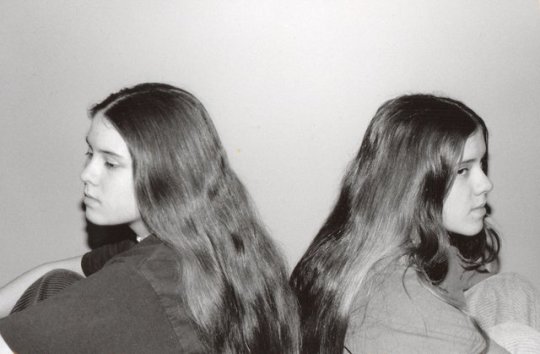
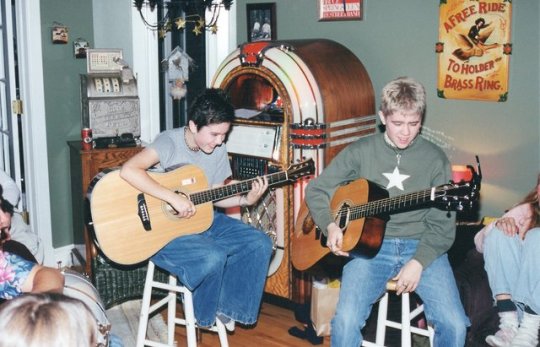
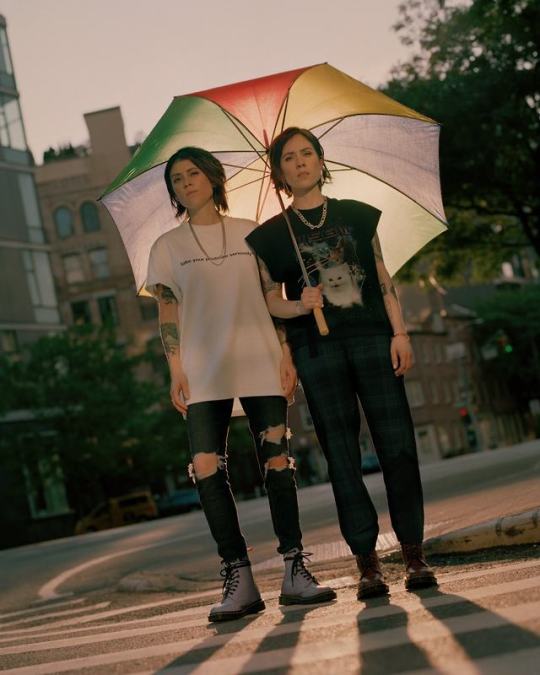
Nine Albums Later, Tegan and Sara Are Finally Ready to Discuss High School
In a new memoir and an album of songs they wrote as teenagers, the feminist pop stars look back at their traumas, triumphs and life as identical twins.
By Jenn Pelly and Liz Pelly Sept. 24, 2019 Updated 6:33 p.m. ET
To be a twin can be a psychological house of mirrors. And so where better to meet up with Tegan and Sara Quin — feminist pop heroes, freshly minted authors, and, like us, identical twins — than at a kaleidoscopic infinity room in Chelsea? As we left the small mirrored room at the kitschy Museum of Illusions, where our likenesses warped and refracted, we encountered a third set of twins. Reality grew ever more psychedelic, and we snapped a photograph of the six of us to commemorate it.
In their new memoir, “High School,” the Quin sisters alternate chapters to detail their teenage years. Growing up in Canada, they worshiped Nirvana, Green Day and the Smashing Pumpkins. They discovered and explored their sexuality. They sneaked out to raves, dropped acid, fought authority. When a classmate spewed homophobic statements during a lesson on STDs, Sara hurled a chair across the room. In the end, the twins competed in a life-changing battle of the bands. “If we don’t win tonight,” Tegan said onstage, “our mom is going to make us go to college.” They won.
While gathering their research for the book, Tegan and Sara found cassettes of some of their earliest songs. And so “High School” is accompanied by a new album, “Hey, I’m Just Like You,” featuring polished-up re-workings of those unearthed demos. Some of the songs evoke the ’90s indie pop of the band’s Lilith Fair era, while others could be the seeds of electronic-dance bangers. The connective thread is the unguarded emotionality of a teenage perspective.
This multimedia set is yet more experimentation from a band that, across nine albums, has moved from folky indie rock into synth-driven dance tracks and mainstream pop. Tegan and Sara sang “Everything Is Awesome” (“The Lego Movie” theme song) at the 2015 Oscars, and have performed with Taylor Swift. In 2016 they launched their Tegan and Sara Foundation, to benefit organizations committed to health, economic justice and representation for L.G.B.T.Q. girls and women.
During a conversation at a downtown cafe, Tegan was forthright and unapologetic, while Sara was analytical, using an app to astrologically survey our twin-by-twin dynamic. They frequently chipped at each other’s memories and perspectives to hone the truth and soon turned the questions on us: Did we feel ever competitive with each another, or encroached upon, as twins with the same career? These are excerpts from the conversation.
JENN PELLY As identical twins, we have strengths and weaknesses that are different but complementary. I often think: If you put us back together, we would be a perfect person. Do you relate?
TEGAN AND SARA QUIN 100 percent.
SARA I wouldn’t be as extreme, if Tegan wasn’t Tegan. I would have balanced myself differently. When Tegan would go through a dark stage, and be a little more chaotic, I would straighten up and be more disciplined. When Tegan went through a punk stage and started getting tattoos everywhere, I was like, I’m going to wear tailored clothing.
LIZ PELLY I think some twins learn early on that collaboration requires compromise and patience.
SARA A lot of people will say, “I have mommy issues” or “daddy issues.” I have Tegan issues. A lot of my hangups or dysfunctions in relationships are based on our primary relationship as children — what worked for us, what didn’t, how difficult it was to share the same face.
Most people sort of break up with their mom or their dad when they go out into the world and become adults. With us, it’s like we broke up, but decided to co-parent our music career.
TEGAN I believe there is a deep desire in Sara to define herself outside of this duo, like she’s cutting off an appendage. It’s not sad for me anymore, but it was at first. We are better together. Our songs are more developed together, and we stand out in a crowd together. It’s very complicated, to want to sever and tether at the same time, this mix of emotions that’s feuding inside of you at all times: We desperately want to be apart, and be our own people, but I need her to thrive and survive.
JENN Explain the mirror on the cover of “High School.”
TEGAN The mirror is distorted, and so is our perception of ourselves, and of the past, and of each other. In writing the book, it was like: That’s what you remember? That’s what you thought was happening? Over the years, I’ve realized there’s this unfair weight put on our shoulders to represent both of us. It’s a psychic burden; you’re responsible for each other.
JENN One passage that shocked me was when you discover you’ve both been playing music alone. Liz and I talk about cryptophasia a lot, a secret language that some twins share. Is that how it felt?
SARA When I discovered the guitar, I didn’t need to know Tegan was also discovering the guitar. When I figured out I was attracted to my best friend, I just assumed Tegan was figuring out she was attracted to her best friend. I assumed there was this parallel experience happening at all times.
TEGAN I was shocked you had been doing the same things.
SARA Discovering the guitar and writing songs felt like an epiphany, like a miracle. I had been so bad at so many things. This was the one time in my life I picked something up, and I knew how to do it. It felt like a gift, like it saved me. I wanted to protect that for a second, in that little tiny moment where I was doing it alone. But playing with Tegan, I knew it was bigger and better and more special and more seductive to people.
JENN You write about not fitting in with the punks, while also offending people in school because of the way you dressed, like outsiders among outsiders. Did you embolden each other?
SARA I felt alienated at punk shows. I walked in with that chip on my shoulder — “I don’t belong” — and Tegan threw her bag on the wall, walked into the pit, banged her head and thrashed.
TEGAN I always felt, if you want to be in that room, go in that room. If you want to be invited there, go. If you want to be a part of things, be a part.
JENN I wonder if some of this confidence comes from having a built in support system — the us against the world type thing.
TEGAN I never needed an external source to inspire me. It’s inside of me. I want to make my own rules. I don’t want to ask permission. There were long stretches of our career where I felt Sara dwelled on meaningless things. But she was finding a way to work through, and I worked my way around.
There were certain criticisms made of us, early on, that felt unfair. They did not feel like musical criticisms. They felt borderline or blatantly misogynist. My reaction was to design a T-shirt with all of the quotes — Spin magazine: “Wicca-folk nightmare.” Pitchfork: “Tampon rock.” I wanted to sell it on our website, and embrace the part of our history that made us as tough as we are now — not hardened, not bitter, but thrilled to be a part of this still. Because we got around it, and she got through it, and we’re still here.
SARA I always had a more institutional perspective. It wasn’t “tampon rock” that bothered me, it was sexism that bothered me. It was homophobia that bothered me.
The only reason I’m still making music, in this band, is because Tegan was championing me and cheering me on and trying to get me past these obstacles. But I didn’t feel sorry for myself. I felt furious at the industry, at the institutions that were inherently flawed and discriminatory. Even as a young person, I thought: If we’re the ones making it, and I feel this bad, Jesus, what does it feel like to be the artist that isn’t breaking through? I appreciated Tegan going around the obstacles, but I was like: I want to put dynamite under the obstacle and blow it up. We really have struggled with that dynamic.
A lot of that was planted early in our lives. Tegan’s coming out story is so different. She didn’t face the same type of homophobia. She didn’t have the same type of trauma as I did. Tegan holds her girlfriend’s hand on the street. I don’t. I’m afraid. I don’t care how big WorldPride is or how many cool new queer artists are on the covers of magazines. My experience informed how I react to the world. And that sometimes is hard to reconcile.
JENN I was thinking about your song “Nineteen” from “The Con,” which also describes your teenage years. Do you feel you’ve been reflecting on this part of your life for a while now?
TEGAN When we started talking about other songs that could be included [on our upcoming tour], the first song I thought of was “Nineteen.” I thought about how much of our music harkens back to that high school period. We’ve been diminished over and over throughout our careers for only writing love songs. But what we were really writing about was relationships, including the ones with ourselves — about family, friends, work. You talk about everything when you’re talking about relationships. There’s something about tethering the old songs to the modern age that becomes very cinematic for me. It starts to tell a bigger story.
LIZ You’ve described “You Go Away and I Don’t Mind,” from the new album, as being about the futility of fame. What is it like to reflect on that now that you are famous?
SARA I think that is the most strangely prophetic song. It was very surreal to read those lyrics all of these years later. Because for me, it’s very coherent. Since we were little, we had drawn undeserved or unearned attention. We would go to the mall as little kids and people would touch us. And that’s very disorienting and destabilizing as a young person. I think we did feel popular but it felt false. And in a lot of ways that echoes what it feels like to be famous or to be a celebrity in some ways. It can feel very empty.
JENN In part of the book, a friend’s brother asks you to jam, and you talk about how badly you wanted to be taken seriously. Was there a point in which you finally felt like you were taken seriously?
TEGAN To this day there’s a part of us that doesn’t feel like we’ve been taken that seriously, and I think all women probably feel that way. But we’ve now spent the majority of our adult life doing the thing we love, and we’re approached every day by people who are like, “I exist because of you.” Things like the Grammys become less important when you have an entire generation of people who are grateful you were bold and open about being gay before it was cool.
SARA We want journalists and fans, and culture at large, to reconcile how we see young women as artists — and when we begin seeing art as valuable. With our new songs, there are going to be people who say, “Oh, isn’t it cute? They released songs from when they were in high school.” But we want this music to be taken seriously. Not because we’re 38 years old and rerecording these songs, but because we were 15, 16 and 17 years old when we wrote them. And as 38-year-old women who have been around the world, who have experienced so much, I still think there is value in what I had to say. I went back and listened to that music and decided it is valuable.
TEGAN Actually I did first and then you did two months later.
SARA We are challenging people to see this work as sophisticated and mature and ahead of its time.
When we were teenagers, our music was written about as “rudimentary, but geez, there is something there.” It wasn’t rudimentary. There was something remarkable about what we were trying to say. There is something so profound about your first experiences. I fell in love multiple times. I was depressed. I was suicidal. I was passionate. I fought with my mother. I broke up with my sister. Those are some of the biggest moments of my life. How am I supposed to just write them off, like, “Oh who cares, I was a teenager.”
LIZ We’re taught that thinking in an emotionally-charged way is something for your teenage years. But actually, that sort of emotional intensity is powerful to carry with you throughout your life.
SARA I have a visceral memory of sitting down to write the song “Hello” at the end of grade 12. I had been devastated by this girl, Zoe, in the book — I loved her, and she was like, “I don’t like girls.” I was grappling with all of these big things. And I remember thinking, “I wish I was older. I wish I knew how to get through this.” I’m 38 years old, and every time I sing that line, I feel that right now. I wish I knew how to do this better. I don’t understand why I’m still suffering. I don’t understand why I’m still not better.
TEGAN It’s powerful to acknowledge that you don’t have all of the answers yet.
SARA When I sat down and listened to the demos, I just thought: I’m so glad little Tegan and Sara wrote all this music. They were better at addressing my feelings than I am right now.
47 notes
·
View notes
Text
50 books read in High School Worth Revisiting
The Great Gatsby by F. Scott Fitzgerald: High school students who go on to college can quite easily nurture a firsthand understanding of the self-serving hedonism found at the center of this beloved classic. And then they’ll either despise it even more or relate all too well.
Beowulf by unknown: Pick up the popular Old English epic after forgetting the seemingly endless lectures and settle in to a thoroughly enjoyable adventure tale.
The Catcher in the Rye by J.D. Salinger: Depending on one’s circumstances when first picking up The Catcher in the Rye, protagonist Holden Caulfield is either a counterculture revelation or a whiny, pretentious brat. Revisiting him later in life will inevitably shift perceptions to some degree, be it major or minor.
Their Eyes Were Watching God by Zora Neale Hurston: Some high school students may scoff at the soapier elements found on Zora Neale Hurston’s Harlem Renaissance essential, but older adults are more likely to see and admire the strength, courage and resolve of heroine Janie Crawford.
Romeo and Juliet by William Shakespeare: The real tragedy of Romeo and Juliet isn’t their mistaken, needless deaths. It’s their staggering myopia and selfishness.
One Flew Over the Cuckoo’s Nest by Ken Kesey: Anyone who has ever personally suffered from a psychiatric disorder — or loves someone who does — might find the marginalization of the mentally ill in this undeniable classic both disturbing and tragically accurate. It may take some time and experience between high school and the next read for such bitter facts to really seize hold.
Les Miserables by Victor Hugo: Les Miserables is huge. When reading it in English class, deadlines might preclude many students from really picking up on the book’s myriad juicy nuances. Revisiting it later offers far more time to sit and ponder everything Hugo wanted audiences to see.
War and Peace by Leo Tolstoy: As with Les Miserables, time constraints and other academic obligations make it difficult to really become absorbed in War and Peace. When picking it up and reading on a more personal schedule, visitors are more likely to forge a far more solid grasp of the material.
Ceremony by Leslie Marmon Silko: More sensitive high school students may find protagonist Tayo’s spiritual, emotional and physical healing process too intense for their tastes. But as they age and gain more life experience, Ceremony could very well prove exactly what they need one day.
Things Fall Apart by Chinua Achebe: As long as there are nations battling it out over land and squashing indigenous cultures beneath their boots, postcolonial literature will always be relevant. Chances are, anyone reading Things Fall Apartas a high school student will probably be able to apply many of its tenets to current events. When they re-read it as adults, they might find themselves sadly noting how little things have changed.
The Jungle by Upton Sinclair: Both at the turn of the 20th Century and on into today, most readers (even teachers) tend to emphasize Upton Sinclair’s visceral descriptions of unsanitary food production — especially since it directly spawned hefty legislation. In reality, though, he wanted it to shed light on the plight of exploited workers. Give his classic another visit later in life and see how the story changes when reading it with this in mind.
Beloved by Toni Morrison: Toni Morrison deliberately left many elements of her celebrated novel ambiguous, so any subsequent readings will inevitably churn up new perspectives, details and interpretations.
The Joy Luck Club by Amy Tan: Because family stands as this classic’s core theme, The Joy Luck Club never goes out of style. Whenever issues with parents arise, refer back to it for solace and insight.
The Color Purple by Alice Walker: When life grows too overwhelming, timeless heroine Celie provides inspiration to press on — no matter what sort of adversity and cruelty stonewalls happiness and stability.
The Adventures of Huckleberry Finn by Mark Twain: The sociopolitical elements driving this famous narrative are incredibly important to understanding it as a whole, but focusing too much on them — as one would in an English class — glosses over the comparatively more lighthearted adventure elements.
Frankenstein by Mary Shelley: Understandably, many first-time Frankensteinreaders dive into the novel expecting a green-skinned simpleton with bolts in his neck — and find themselves shocked when encountering something completely different. Give it a re-read and see what may have been missed when consciously or subconsciously making comparisons with the iconic movie.
The Old Man and the Sea by Ernest Hemingway: High school students sigh over this leisurely-paced classic, but older adults seeking something more philosophical than frenetic might find it exactly what they want.
Death of a Salesman by Arthur Miller: Hopefully, picking up the searing Death of a Salesman at just the right time will prevent many students and adults from falling into the same lifestyle traps as tragic Willy Loman.
The Stranger by Albert Camus: Existentialism probably seems intense and somewhat inaccessible to many high schoolers, but one of the philosophy’s cornerstones warrants further consideration once they pack on more life experiences.
Heart of Darkness by Joseph Conrad: Puncturing through allegory after allegory after allegory grows tiresome after a while, and a fair amount of individuals might enjoy Heart of Darkness far more if they didn’t have to so painstakingly dissect every word.
I Know Why the Caged Bird Sings by Maya Angelou: Maya Angelou’s poetic autobiography is at once heartbreaking and inspiring — an ultimately uplifting tale perfect for anyone needing a dash or two of courage.
Slaughterhouse-Five by Kurt Vonnegut: An American treasure, Kurt Vonnegut may not necessarily appeal to harried high schoolers lacking the time to really sit and think about his statements regarding society, religion and politics. Approaching him with the proper time frame and mindset will make Slaughterhouse-Five and his other works burst with life and lessons.
The Metamorphosis by Franz Kafka: "Monstrous vermin" Gregor Samsa serves as a viable literary outlet for anyone, anywhere feeling as if the world treads all over their stability and happiness. Reading about the horrific abuses his family heaps upon him provides a strange, comforting sense of solidarity.
Wuthering Heights by Emily Bronte-: Though fiction, Wuthering Heights makes for one of the most prominent lessons in how mentally and emotionally abusive relationships operate – something women and men alike absolutely need to know if they hope to keep themselves safe.
Of Mice and Men by John Steinbeck: Most of Steinbeck’s oeuvre deserves multiple reads, but his story of a developmentally disabled man and his devoted caretaker remains one of the most heart-wrenching American novels ever printed. And one whose tragic ending merits a wealth of conversations.
Don Quixote by Miguel de Cervantes Saavedra: Because Don Quixotepossesses such a rich history and left an indelible mark on popular culture, bibliophiles of all ages find themselves coming back again and again to enjoy the adventures of the eponymous dreamer.
The Bell Jar by Sylvia Plath: This semi-autobiographical novel sheds considerable light on a life wracked with mental illness — a somber, realistic lesson every adult must understand. The Bell Jar also serves as a reminder that anyone emotionally struggling doesn’t always do so alone.
A Clockwork Orange by Anthony Burgess: Readers who don’t understand Russian or cockney slang (aka most of them) need to read this warped dystopian novel multiple times to understand what in God’s name the characters are even saying.
A Doll’s House by Henrik Ibsen: Written before the feminist movement rose up and fought for women’s equality, one of Henrik Ibsen’s most popular plays toyed with the scandalous notion that some housewives may pine for a life outside their husbands, homes and kids.
The Awakening by Kate Chopin: Another recommended read for the liberated woman and the men who appreciate them, though many fans of this book find themselves divided over whether or not they fully agree with the central figure’s actions.
Gulliver’s Travels by Jonathan Swift: English classes spend so much time zeroing in on the wealth of social, political and religious commentary found in Gulliver’s Travels, they oftentimes forget to address just how much fun the book actually is.
Invisible Man by Ralph Ellison: Dense and intense, Ralph Ellison’s brutal analysis of pre-Civil Rights race relations is required reading for any students and adults hoping to end bigotry in all its twisted, ugly guises.
Maus by Art Spiegelman: Maus currently holds the honor of being the only Pulitzer-winning graphic novel, a status that rightfully earned it a place on many a syllabus. Despite its grim content — Art Spiegelman’s very real talks with his father about his Holocaust experiences — the valuable lessons about family and history remain timeless.
Inferno by Dante Alighieri: All three portions of Dante Alighieri’s epic poetry trilogy The Divine Comedy are required reading, but his bizarre, highly detailed depiction of hell holds the most influence over the literary world today — not to mention pop culture as a whole.
1984 by George Orwell: No literary history aficionados will argue that George Orwell’s terrifying totalitarian dystopia birthed the entire genre, but it certainly left the biggest impact. Political pundits enjoy trotting out parallels to 1984 when discussing administrations they hate. Citizens familiarizing themselves with the novel’s tenets and context can tell whether or not they have a real point or are just resorting to paranoid fearmongering.
Nectar in a Sieve by Kamala Markandaya: Despite the many hardships heaped upon protagonist Rukmani, hers is a story of strength and perseverance that many students and adults may want to consult when seeking comfort in times of trouble.
Cry, the Beloved Country by Alan Paton: Though apartheid may have ended, its legacy of intolerance and discord provides future generations with the tools to identify and stop such practices before they even have a chance to start.
Catch-22 by Joseph Heller: Readers of all ages with a particular affinity for absurdity and political commentary — especially as it relates to wartime — keep coming back to this novel again and again for laughs and truth bombs.
The House on Mango Street by Sandra Cisneros: Bibliophiles looking for a great bildungsroman to read over and over again have plenty to love about and explore with this compelling story about a young Chicana and her life in an impoverished Chicago neighborhood.
A Good Man is Hard to Find and Other Stories by Flannery O’Connor: Though an obviously subjective statement, many consider Flannery O’Connor one of the best American short story writers of all time. In such a confined space, she thrived with some incredibly provocative, influential narratives well worth reconsideration.
Night by Elie Wiesel: In his autobiography, Elie Wiesel recounts his gruesome experiences in Auschwitz and Buchenwald with the hopes of educating the world about the Holocaust’s horrors. Giving Night more than one look helps drive home its major historical themes, imbuing readers with the knowledge needed to better recognize hate and genocide.
Persepolis by Marjane Satrapi: This new classic is at once hilarious and heartbreaking. Through deceptively simple art, writer and cartoonist Marjane Satrapi recounts her childhood during the Islamic Revolution in Iran and the different set of prejudices faced as an expatriate in Europe.
Gravity’s Rainbow by Thomas Pynchon: Gravity’s Rainbow necessitates multiple reads because it involves over 400 characters embroiled in increasingly absurdist, surreal situations. Anyone who says they understand everything in one read is probably lying just to seem smart. Punch him or her in the face.
A Separate Peace by John Knowles: The comparatively cushy lives of private school students in New England are juxtaposed with young men forced to the front lines of World War II, with a strange and interesting friendship right in the center.
A Confederacy of Dunces by John Kennedy Toole: Not only is it a provocative read — especially when one factors in author John Kennedy Toole’s tragic life — this posthumous Pulitzer winner also happens to be one of the most hilarious novels ever published.
A Tale of Two Cities by Charles Dickens: Charles Dickens attracts such a massive audience, most of his oeuvre could’ve easily made this list. A Tale of Two Cities oftentimes bores high school students, but as they grow older they may come to love its history and memorable characters.
Flatland by Edwin A. Abbott: Aside from the fact that this novel exists as one of the greatest satires ever written in English, it also warrants multiple reads for the sheer originality and imagination.
A Room of One’s Own by Virginia Woolf: In her book-length essay A Room of One’s Own, Virginia Woolf opines on feminism, sexuality (most especially lesbianism) and the importance of financial autonomy and personal space for writers.
Interpreter of Maladies by Jhumpa Lahiri: Short stories of Indians and Indian-Americans intertwine thematically, raising some excellent questions about multiculturalism, family, relationships and plenty of other subjects bibliophiles delight in discussing.
Siddhartha by Hermann Hesse: Both the spiritually-minded and those adhering to no religious credos at all appreciate this reflective classic and turn to it for meditative advice.
7 notes
·
View notes
Text
Annotating All the Stuff We Have that Is About Or Might be Interest To Therians or Otherkin in General...
... is going to be “fun.” Well, nothing to it, but to do it. For any curious, here are three that we’ve done so far:
Bricker, Natalie. Life Stories of Therianthropes: An Analysis of Nonhuman Identity in a Narrative Identity Model, Lake Forest College, April 2016, http://publications.lakeforest.edu/seniortheses/63/ (accessed September 10 2016).
Natalie Bricker's dissertation goes into detail on the therian community. Bricker covers both spiritual and psychological explanations in her article. She begins with defining therianthropy and what it means for the therian to identify as a nonhuman animal while being fully aware they are physically human. Bricker's dissertation deals with exploring the identity of therians using Dan McAdams’ life story model of identity and how identity development might play into the identity of a therianthrope. Talking about the concepts of identity formation by several different psychologists. Bricker than begins to explain the general history of the therian community, how it is distinct yet connected to other nonhuman identified communities, and some of the common terminology the community uses. Bricker than touches upon the researchers who have written about therianthropes previously, talked a bit about their methodologies and disciplines, and some of their conclusions. She also touches upon how two past researchers (Grivell et al. and Gerbasi et al.) brought forth parallels of therianthropy and certain transgender experiences, mostly around the experience of dysphoria. Bricker does criticize the researchers who looked at therianthropy from a strictly spiritual perspective for not exploring the identity itself and ignoring how a large chuck of the therian community views their identity as strictly non-spiritual. From their Bricker moves into her own study with looking at therianthropy as an existing identity. Her participants were selected from within the therianthrope community. She found that all of the participants defined therianthropy in fairly similar ways (many using words like “identity,” “non-physical,” “personal,” and “integral”) as well as stressing the difference between their nonhuman animal identifies and their human bodies. Other common themes include feeling they were nonhuman from a young age, all of them recalling a childhood experience where they felt therianthropic, feeling a kinship with nonhuman animals, their discovery of the therianthope community being because of their own experiences leading them to search for others in their teenage years, having recurring experiences with species dysphoria, and dealing with various social obstacles due to feeling different for fearing how others might react to their identification as nonhuman animals. After going over these similarities in detail she then compares the stages therians go through in their identity development with McAdam’s life story model of identity. She also noted how the results fit well with previous research into therianthropy. Bricker finishes up by noting the future direction of research into therianthropy might take.
Coudray, Chantal Bourgault Du. "The Cycle of the Werewolf: Romantic Ecologies of Selfhood in Popular Fantasy." Austrailia Feminist Studies, Vo.l 18 No. 40 (June 9 2003): pp 57 -72. http://www.tandfonline.com/doi/abs/10.1080/0816464022000056376?journalCode=cafs20 (accessed March 18 2016).
Chantal Bourgault Du Coudray discusses the use of werewolves in fiction as a way of delving into the connection between nature and spirit, human and animal, the physical self vs. inner self, or other dualities that could be seen as existing within the human psyche. He explores how the symbolism of the werewolf has been used to explore transcending humanity, spirituality, and other themes beyond strictly horror in various ways in modern fantasy. Throughout the article, he brings up various novels and role-playing games with werewolf characters and how these different works used werewolves to explore these various non-horror themes. He also brings up the early therian community on pages 67 to page 68 when he goes into the formation of the newsgroup called alt.horror.werewolves in the early 1990s. He describes how the group was created for people to discuss werewolves in media but ended up attracting people who identified as werecreatures based on personal experiences and personal persecutions. From there members who identified as werewolves in a spiritual sense began discussing what it meant to be a werewolf to them, which the author ties back into the symbolism and themes attributed to werewolves in modern times. Suggesting that both the people who actually identify as werewolves as well as those who create modern fiction with werewolves are all exploring the possibility of otherness and ways of being posthuman in today's society. Chantal Bourgault du Coudray specializes in cultural history and fiction, and her work is one of the earliest known references to the online therian community in academic literature.
Kulick, Aaron, Pope HG Jr, & Keck PE Jr. “Lycanthropy and Self-Identification.” The Journal of Nervous and Mental Disease, Vol. 2 (Feb. 1990): pp 134-137, http://www.ncbi.nlm.nih.gov/pubmed/2405100 (October 14 2014).
This paper deals with a case report of a 26-year-old man (at the time of the report) who had identified as a “tiger-like cat” for over 15 years and whose identification as such was not affected by any treatment the man had received over the years. The man was employed as a research scientist and had sought professional help due to depression. The man has stated his identification as a cat since childhood and had experienced various behaviors and instincts which he described as feline since at least the age of 11. The case report stated on page 135 that the man considered “himself as a tiger with a very deformed body” and “lamentes his lack of fur, stripes, and a tail.” Interestingly, throughout the man’s 8 years of psychotherapy to deal with his depression, and despite the long list of medications he received at different points of during those years, his identification as a cat “remained completely refractory to treatment.” [i] While the man was diagnosed with clinical lycanthropy, the case reports never states he ever had the delusion of physically being an animal and unlike other cases of clinical lycanthropy, is experiences were not affected by treatment. Along with the case report, the article also includes some background information on clinical lycanthropy as well as some possible historical accounts. Due to being different from other cases of clinical lycanthropy and similar in some respects to some experiences among therianthropes, the report might be of interest in the scope of therianthropes.
#therianthropy#therians#therianthrope#animalkin#otherkin#otherkind#therian#therian research#otherkin research
53 notes
·
View notes
Text
It's Not Easy Being Green
by Dan H
Tuesday, 17 November 2009
Dan gets his Minority Warrior freak on, big time~
So here's the deal.
Once upon a time, a heterosexual, white man from Oregon wrote a book dealing with complex issues of race, sexuality, imperialism, slavery and Otherness. Then a heterosexual, white man from Oxford read that book and decided that the heterosexual, white man from Oregon was Doing It Wrong and proceeded to complain about it on the internet.
This is one of those iffy things where I'm trying to defuse my own hypocrisy by drawing attention to it but I do genuinely feel that it's a problem when white people use racism as an excuse to score points off of other white people, or when men use sexism as an excuse to score points off other men (this last being one of my major issues with a lot of later Joss Whedon). This of course creates a bit of a paradox (paradox (n): convenient excuse for behaving like an inconsistent jackass) because you can't say “this guy is trying to use sexism to score points off other men” without doing the exact same thing yourself.
So umm ... yeah, that's what this article is going to be about. It's going to be me trying to score points off a guy called Jay Lake by complaining about the fact that he's trying to score points off me, while criticising his work as being skeevy on a variety of levels.
For what it's worth, part of the skeeviness in Green involves a certain amount of discussion of rape so: trigger warning.
Also spoiler warning, but you should expect that by now.
Where to begin:
Reverse Racism
One of the many quite positive things to come out of Racefail '09 were some interesting essays/articles/blogposts on the concept of “reverse racism”. Broadly, as far as I can tell, this was a reaction against a lot of discussions along the lines of, well, of the introductory sequence to Everyone's a Little Bit Racist where the white puppet “exposes” how racist the monster puppet is being for not letting him come so their Monster's Support Group. It's the sort of apologist claptrap you get all the time where somebody “insightfully” points out that having – say – an award for Music of Black Origin is racist because you couldn't have an award for Music of White Origin.
On the other hand there's another side to the whole “reverse-*ism” issue which is just as pernicious as the first.
A little while ago I had a trawl through the archives of
Girls Read Comics (and They're Pissed)
and found a post about a guy who had shown up and complained that they felt that female superheroes didn't make sense. But wait, they weren't being sexist, oh no. Because you see the thing is that they thought that women were too sensible and mature to be superheroes. Because you see superheroes are basically just adolescent power fantasies, and isn't it just us silly, silly men who need to dress up in tights and have fun beating up baddies. Aren't women so much betterthan that, with their caring natures and their ability to listen. Needless to say the girls at Girls Read Comics... were not amused.
Green reads a lot like that guy. All the bad guys are men. Most of them are white men. This wouldn't be a problem in itself, and I most certainly am not suggesting that it's “racist against whites” to have the bad guys all be white people. Rather the problem is that the whole book is shot through with some slightly creepy, faintly Victorian attitudes to women and to non-white cultures. Bad guys all white men? Fine. Bad guys all white men because they're the only people that appear to have volition and agency, while everybody else just kind of sits there quietly starving, not fine.
So anyway, I'm six hundred and something words in, and I'm still ploughing through disclaimers, I should probably start actually talking about the book. As always this isn't really a review, it's a response. The rest of this article is basically going to be in four parts. I'm going to take a look at the overall plot, then at the way the book deals with sexuality, then at how it deals with gender, then how it deals with race and the trappings of Empire.
The Story
The story of Green is as follows. Green lives until the age of three in somewhere that is vaguely like India. It isn't spelled out at the time, but she basically lives a life of grinding poverty and desperation. She is sold by her father (her mother and grandmother have both died – this is the start of a long sequence of Green suffering misfortunes because of Men) to a man named Federo, who carries her across the sea to Copper Downs. There she is raised at fantastic expense as a courtesan on behalf of somebody called “The Factor”, while Federo and a catgirl “dancing mistress” train her up to be a kickass ninja assassin.
At the age of twelve she escapes from whore school amidst much angst (there's a lot of angst in the book) but is still recruited by Federo and the Dancing Mistress to take out the immortal Duke who has ruled over Copper Downs for four centuries. This she duly does, before fleeing over the see to Selistan, her homeland.
She returns to Selistan, and finds her father's farm, only to realise that it's a horrible poverty-stricken wreck and that being a slave was probably the best thing that could possibly have happened to her (the “being enslaved and oppressed was the best thing that could happen to these people” theme is a recurring one, and one of my biggest sources of trouble with the book). Then she hangs out on the streets of a big quasi-Indian city, gets recruited by a temple of all-female death-worshippers wherein she has sadomasochistic lesbian sex. Then she gets sent back to Copper Downs to fight a God, where she has more lesbian sex. Then she has sex with a man and gets pregnant. Then she kills a god, and makes her father's ox into a new God of Patience. Then she settles down to raise her kid. The end.
It's three hundred pages long. It feels longer. Which is odd because not much actually happens in it.
Anyway, on to the things that I want to score points over.
Sexuality
Green has a whole lot of lesbian sex. Like a whole lot of lesbian sex. It starts at the temple in Kalimpura, where she leses up with the other initiates and the older “Mothers.”
Couple of things about this.
First off, at the time she is in fact somewhere between the ages of twelve and fourteen. Again, I know that gender reversal isn't always the best way to judge these things (again it comes down to the reverse-ism problem) but for a book that is so preoccupied with notions of sex, slavery, sex slavery and rape it's a tiny bit problematic that it completely glosses over the fact that it's not okay for forty year olds to shag fourteen year olds, even if both parties are women.
Now I know that Green is set in a pre-industrial society. I know that most fourteen year old girls in such a society would already have been married off but guess what: the text is very, very clear about the fact that this is bad. But apparently all these issues of consent, power, society and duty of care evaporate like spit on a soldering iron the moment it's time for a bit of girl-on-girl.
Ages ago I wrote an article about
Nice Guy Syndrome
and pointed out that Nice Guys and a certain variety of feminist-identified-man go to extraordinary lengths to demonise male sexuality. Green only “lies with” one man in the entire book, and he's a priest who normally takes it up the arse:
“You re my first woman.” Something in his voice grew very shy. “My first entry, in truth. I have only been the vessel, not the seed, within the temple rites.”
You later meet his high priest, and he's obviously evil, and gloats about priest-dude's tight arsehole. It's a theme that's repeated throughout the book: penetration is evil, but being penetrated builds virtue through suffering. Green encounters literally no heterosexual men (okay, tell a lie, there's one one-legged cook) who are not either rapists or would-be rapists. The fear of rape is something that dogs Green from the first page of the book to the last and rears its head every time she talks to somebody with a penis (unless that penis has been rendered safe by a good buggering).
Again (you see now why I put that long disclaimer at the start) I'm not claiming that this is “reverse sexism” or “reverse homophobia”. I'm claiming that it is regular sexism and regular homophobia.
Here is Green on the discovery of a gay man aboard a ship:
Love between women I could understand, but men were such careless brutes that I did not see how two of them could love without someone to dampen the blows and soften the curses. This opinion was a legacy of the Factor's house, I now know but some of those habits of thought were years in the erasing.
Two things. Firstly in the Factor's house, Green met literally no men. She was raised and trained entirely by women, many of whom beat her at the slightest provocation, so how she came to those conclusions I have no idea. Secondly that simply isn't a woman's perspective on gay sex. Not even a gay woman's. It's a heterosexual man's opinion, forced uncomfortably into the mouth of a young girl. It's an attitude grounded in the idea that women are the natural objects of sexual desire and men the natural agents of it.
Green has a lot of sex, but she never really has sexual agency. Yes, most of the time when she has sex it's because she chooses to, but what you never get from Green is the sense that she is, for want of a better term, horny. She never actually gives the impression of experiencing sexual desire, of looking at somebody and just plain wanting to fuck them. Much like Inara in FireflyGreen has sex as a kind of benediction. She has sex with the women in the Temple as part of an all-girls-together bonding ritual. She has sex with priest-dude because he, in essence, proves himself worthy by talking to her about mythology (and what gets fantasy writers hotter than their own mythology).
Lake's demonisation of male sexuality and valorisation of lesbianism reaches its height in the confrontation against the Big Bad. The villain has captured Green and the catgirl Dancing Mistress, and is getting ready to cut them both into pieces so that he can reclaim the last shards of the power he needs to become a full on god. How do Green and the Dancing Mistress get out of this situation? Why they les up! And the truly stupid thing is that it works. It works so well that the Big Bad actually stops torturing the two of them to death and – I shit you not - sits down and starts masturbating. Here's how it plays out:
I crawled back up to nuzzle her face. “Oh please,” I moaned, “kiss my thighs.” My voice would have had the Lily Blades falling out with laughter, but Federo just echoed the moan. He was the rankest of boys. Facing Federo as I sprawled on the floor, I ran my tongue across my lips. Mistress Cherlise had shown me a number of such little bits of playacting that would arrest a man's attention. The Dancing Mistress gripped my thighs hard and kissed me back and forth along the inner line of each leg, working down towards my knees. When she reset her grip to my calves and eased herself further away I nearly shrieked. Instead I rolled slightly to my left so Federo could see my right breast. He wasn't looking any more. His eyes were closed, his back arched in his chair as he stroked himself very hard. Outside, thunder rolled almost continuously.
If this was just stupid, I'd let it go. But it's not just stupid, it's stupid and it's sexist. And just to be very clear, to say for the third time something I am sure I will say again, I don't mean that it's “reverse sexist” or “sexist against men” I mean it's sexist. It's an offensive, patriarchal stereotype which harms women far more than it harms men.
The attitude expressed in the passage above, and repeated throughout the whole of the book, is that male sexuality is intrinsically corrupt, fundamentally violent, and ultimately controlled by women. While men (white men at least) are morally responsible for all of the evils in Green the practical responsibility lies always with women. When Green returns to Copper Downs, it is revealed that after she killed the Duke, the Factor's house where she was trained was destroyed, the remaining Mistresses killed, and the girls who were kept there raped to death. And who was responsible for the girls being raped to death? Why they were of course! Once the Duke was dead, there was nobody to restrain the guards, and so they did what all men will naturally do when faced with beautiful women, they raped them until they died. “Because of their beauty” as Green herself puts it.
This is a world of not okay. Yes, the novel is written in the first person, and Green's perceptions are likely to have been shaped by her extremely fucked up upbringing (although if that was the case, you'd expect her to be more comfortable with the notion of being sold into slavery, since it was all she had known) but the text routinely operates from the assumption that men are Slaves to Their Lusts, that when faced with a hot woman, men will completely lose their reason and cease to be responsible for their actions (if you want an example, scroll back up and read the boss-fight-wanking-scene again, is that the description of a man who is in control of himself?). Green's attitudes are not deconstructed or shown to be false or harmful, quite the opposite. By the end of the book, Green is assumed to be in possession of a true and accurate understanding of the truth about men and women, at least as Lake sees it.
This is wrong. Rape is not some kind of natural disaster, something that just happens like a hurricane or an earthquake. It is not an occupational hazard of having a vagina, and it most certainly is not a fucking compliment (“because of their beauty” my arse). By the same token, lesbian sex is real sex, and lesbian sexual abuse is real sexual abuse. An institution in which forty year old women fuck thirteen year old girls is exactly as abusive as one in which the forty-year-olds are men.
Gender
I've touched on this already, but I'll just go over the basics again.
Men = bad people who have nasty things like ambitions and desires and sexual appetites.
Women = good people who have nice things like patience and wisdom and did I mention patience?
Again, I should come clean here and mention that the reason I'm so profoundly sensitive to this kind of thing is that I really do appreciate the temptation of this line of thinking. It's amazingly comforting as a man to bury your sexist, patronising bullshit under layer upon layer of “well really, I think women are superior to men” but sexist, patronising bullshit it remains.
Green (the novel) is preoccupied with Women. Green (the character) is preoccupied with Women as well. Unfortunately neither the novel nor the character are actually interested in women. For the benefit of those who don't have the patience for my smug games with capitalisation, the distinction I'm alluding to is between “Women” with a capital “W” - a broad impersonal concept chiefly designed to allow men to score points off of other men – versus women with a small w, actual people with names and personalities. Again this is something I've been guilty of myself, allowing my very real concern for the way that Men treat Women to blind me to the way I personally was treating actual people.
Green is obsessed with women, and in a peculiarly self-conscious way. She habitually uses the word “woman” to mean “people in general” (and even more peculiarly, sometimes uses “girl-child” to mean “children in general”). Now in all seriousness I do get that there are issues with using specifically masculine pronouns to describe people-in-general, but Green was born in one patriarchal society, and raised in another, where did she pick up the habit of using feminine pronouns?
Similarly she spends the entire book talking, talking, talking about how badly she wants to protect Women and children and did I mention Women. The problem is that she never actually does anything about it. Now I know she's only fifteen by the time the book finishes, but we spend the entire book being told how utterly precocious and omnicompetent she is and you can't have it both ways. Either it's a book about a powerful, independent woman who triumphs in the face of the horrors she faces, or it's about a broken woman who is destroyed by the people who enslave her and remade into their image. If she's as awesome as everybody says she is, she should damned well do something about those injustices instead of just talking about them.
It doesn't help that while Green goes on and on and on about Women and Girls, there isn't a single woman or girl she actually displays any compassion for or indeed interest in. Green as a character is relentlessly self-absorbed. One gets the impression that we are supposed to take the mere fact of her being a woman as evidence of virtue.
This is, in itself, mildly irritating, but it's so all pervasive in the text that it goes beyond “irritating” into “faintly skeevy”. Green (the novel) consistently refuses to allow women to be responsible for their own actions. Green herself never actually makes a decision, she gets bought at the age of three, and is then controlled entirely by the Factor, then by Federo and the Dancing Mistress, then by the Lily Goddess. Worse, she makes up for this by beating herself up about things that she has no control over whatsoever (like the aforesaid raping to death of the girls in the Factor's house). It all contributes to a worldview in which women are seen as incapable of acting for themselves, or controlling their own destinies. Even when female characters do things which are genuinely morally repugnant (violently beating a twelve year old girl, engaging in sexual activity with minors in their care) those things are either assumed to be acceptable (see “sex, lesbian”) or blamed on Men (see “beatings, violent”). Even Green's decision to cut up her own face is explicitly taken away from her and given to the nebulous They.
Basically Lake is so fixated on making the book about Women, Women, Women that he completely forgets to include any well-realised, sympathetic female characters.
Green (the book) is full of Goddess imagery. There are constant references to the obligatory maiden, mother and crone, and it is I think deliberate that Green starts the book as a child and ends it as a mother. Similarly virtually all of the female characters fit somewhere into the Triune – often explicitly, such as in the Lily Temple where the initiates specifically progress to being “Mothers”. Of course the problem with this is that it essentially reduces all women everywhere to three archetypes, and worse because it romanticises those archetypes it fails to recognise how limiting and constricting they are. It puts women in a box, then puts the box on a pedestal.
Race and Empire
This is the difficult bit. As ever there's nothing more dangerous than invoking the spectre of (whisper it) racism.
Once more I should say very, very clearly that I'm not actually calling Jay Lake a racist. He did sit down and write a book about a pseudo-south-Asian protagonist (although she is, of course, white on the cover) and much as I like to complain, the pseudo-Indian city of Kalimpura has as much imagination invested in it as Copper Downs. The book deals with some extremely complex, extremely sensitive issues, and if I were feeling like less of an asshole I'd probably give it some major points for trying. But I'm not, so I won't.
Green deals with some extremely complicated issues such as slavery, abuse, imperialism, and human trafficking (much like Dollhouse in fact). One of the most difficult things to deal with when handling the subject of abuse is the extent to which an abuse survivor is shaped by their experiences, the extent to which they – to use a loaded term – owe who they are to the events that shaped them. Post-imperial or post-colonial cultures have a similarly difficult relationship with their past, an occupying force brings stability and infrastructure and the removal of that infrastructure frequently causes as much trouble as the imposition of it. When a great injustice occurs – either to an individual or to a people – it can sometimes be hard to tell how much of what follows is because of that injustice, and how much is in spite of it.
Green beings the book being sold into slavery by her father. She observes, early on, that the food she is given by Federo is better than any meal she has had in her entire life. This itself isn't a problem. It's entirely reasonable that the food available to a rich human trafficker will be higher quality and more abundant than the food available to a subsistence-level rice farmer. To begin with, the issue of contrast between her old life and her new life is handled with sensitivity, Green seems genuinely conflicted about the fact that she is, in many ways, better off in Copper Downs. This feels believable and relatively respectful to Green, her culture, and her circumstances. She obviously feels a lot of guilt about finding some aspects of Copper Downs better than her old life, and the things she prefers are basically issues of material comfort.
It gets worse, considerably worse, when she returns to her home. Suddenly Copper Downs goes from being not merely more affluent than her homeland but objectively better. Green states, quite clearly, that:
My captors had been right. Rather I should have been on my knees thanking the Factor for what he had taken me from.
Now I know that this is partly Green giving in to despair, but nothing in the text challenges this conclusion. It's rather an object lesson in the dangers of taking on too many genre stereotypes at once.
Had this been the story of a white man who was taken away from his pseudo-European farming village and conscripted into the armies of the Dark Lord of Evil then I would have been overjoyed to find him returning home to realise that his long lost homeland was a poverty stricken shithole and his father was a bastard who never cared about him. It would challenge the assumptions of a genre that frequently glamourises poverty, and it wouldn't have any creepy overtones (unless you want to make a big thing about militarism).
Make the white man a south-Asian woman, however, and you start getting into difficulties, because now you're not saying “being poor sucks” you're saying “being foreign sucks”. Turn conscription into slavery and you're not saying “you might be better off in the army than on a farm” you're saying “you might be better off as a slave in Europe than as a free man in your own country.” Add in the courtesan angle and you're saying “it is a good thing for south-Asian women to be sold as sex slaves to European men.”
I hope I don't need to point out that this really isn't okay.
Green (the book) takes another hop, step and jump closer to a pit of utter fail when Green (the character) notices that her father's Ox – an image she clung to from childhood – has grown old in her absence:
He was a beast too, of course. Though somehow less animal than Papa, now.
That's right folks, the book directly compares poor people from hot countries to animals(compares them unfavourably to animals, in fact). Now to be fair her father has gone mad by this point (mostly it seems in order to conveniently prevent Green from finding out her birth name) but that only makes it ablist as well as racist. Sorry, I mean “possible to interpret as racist” because while comparing brown people to animals is dodgy, suggesting that a white man might be prejudiced is unforgivable.
The fucked up imperialist dogma actually reaches its peak, however, with the treatment of the “pardines” - the race of cat-people of whom Green's Dancing Mistress is one (the pardines do not tell their names to outsiders, much like the jellyfish dudes in Mass Effect). Now an early plot point in Green is that the power which allowed the Duke to maintain his immortality had been stolen from the pardines, much to the detriment of their people.
At the end of the book, Green confronts the ghost of the Duke (who was also the Factor, by the way) and he explains to her that actually stealing the power of the pardines was the right thing to do:
“Your crime,” I growled, “was to strip power from a peaceful people and bind it to yourself.” “How peaceful were those people?” Now his face flared with passion to match my own. “Do you know of the last war this city did fight? Under me, as a living man? We battled the pardines. In their time they were terrible hunters and raiders. Others followed them, thinking by their appearance that they were wise and powerful. The shared path they have instead of souls lent them a strength in this world that could not be matched. Over a thousand men were lost wrestling them down. I took what they used to wreak the death of farmers and children and traders, stripped it from them, and made peace for Copper Downs. I even made peace for them.”
Now as the subjective self-justification of the ghost of a tyrant, this is all well and good, but the problem is that it isn't. It's a pure statement of fact. Green accepts it as gospel and – and this is the really weird bit – so does the Dancing Mistress, who had up until that point been specifically trying to recapture the power of her people (as well she might).
Indeed the conversation between Green and the Duke's ghost seems – in the eyes of the text – to objectively redeem the Duke from all possible sins. It is even revealed that Green was being educated as a woman of four centuries past because the Duke was lonely and desired companionship of the sort he remembered from his youth. I get the distinct impression that we are actually supposed to sympathise with this (again this calls to mind Dollhouse and its seeming belief that it's okay to rape somebody if you pretend they're your dead wife). It is, in essence, a plot twist in which it is revealed that the Duke who Green thought was evil in fact is not.
Here is Green's summary of the story of the Duke and his theft of the pardines' collective power, as she relates it to an angry mob who have just torn apart a mad godling:
“Let me tell you a story,” I repeated “about a people who gave up their power long ago. A city man took it from them. Some agreed to this, but not all.” The silence held, I continued: “The man made himself prince of his city. He ruled for generations. There was peace, prosperity, a time of quiet. The gods fell quiet for the power was like a blanket to them. This took the soul of the people, for what are gods if not the sum of everyone who follows them? Choices fell away, as the power cares only for itself. Even so, the bargain was good for most.”
First of all, how the fuck does Green get from “I stripped them of their power and made it my own” to “a people gave up their power, the bargain was good for most”?
Second of all, I'm sorry but that's really fucking offensive.
I have no idea how deliberate this is but what you have here is a relatively modern culture which owes its strength and prosperity to resources that it took by force from the people who had them originally. People who, according to the guys who took those resources in the first place, were basically a bunch of raiders, hunters and savages.
Doesn't that sound rather a lot like the history of America?
Imagine, for a moment, Green standing up and making that speech (substituting, if you wish “land” for “power”) to an audience of Native Americans.
Umm ... pretty fucking offensive, isn't it.
Now I know, I know, I know that this is a fantasy setting, and the pardines are a fantasy race, but in a book which engages so directly and specifically with issues of race and imperialism you cannot avoid drawing parallels with the real world. Green's apologia – substituting “bargains” for conquest and talking about people “giving up” their power - is exactly the sort of historical revisionism that goes on with stories of the American West.
Ironically for a book all about a non-white gay woman, the whole thing is positively dripping with white male privilege. It's fantastically easy to make big speeches about how power is bad and corrupting, and how really people are better off without it, when you're part of the group that already has all the power. It's easy to praise women and non-whites for what you perceive as their superior qualities of patience and endurance, when you haven't had to be patient or endure, because you live in a world where you can get what you want when you want it. It's easy to write about how people should never try to change the way things are when the way things are primarily benefits you and people like you.
And breathe.
Taking a step back, it is possible that Lake is aware of all of these issues, and that the whole book is working on a much more subtle level. It is possible that the extent to which Green internalises the prejudices of her captors is supposed to be her final tragedy. The only way I could ever find this out, however, would be to read the two sequels which Lake is apparently working on and that I most assuredly will not be doing.
In Conclusion
Green engages with a variety of complex themes, but there is a fine line between engagement and apologia.
Earlier I mentioned the Avenue Q song Everyone's a Little Bit Racist. Some people (I know Rami's one of them) are big fans of this song, because it's really important to recognise that racism is pretty much endemic in society, and nobody is entirely free of it. It's also important to break some of the taboos surrounding racism, specifically “accusing” people of racism.
On the other hand, the song puts just slightly too much emphasis on the “racism” of non-whites. The whole thing is started by a white guy as a means to deflect an accusation of racism, and it works.
Green has similar problems. She starts the novel abducted and enslaved by a western imperial power, but the book focuses so much on the negative aspects of the life she would have had otherwise that it winds up justifying, if not glorifying, her initial enslavement. It's the same issue of uneven historical accuracy that leads to so many skeevy gender issues in Fantasy. Because the western imperialist culture is, to an extent, romanticised – we see very little of the grinding poverty that existed in nineteenth-century England for example – and the eastern agrarian culture is not, you wind up with a situation where Green's only protection from marital rape and early death is to be taken as a slave by a more “enlightened” culture.
So yeah, Green. Not something I'd suggest reading. It's ponderously written, pretentious, boring and full of fail.
And Finally...
Fantasy Rape Watch:
Number of Women Raped: Innumerable, possibly “every woman born in Selistan” depending on how you read the text.
Number of Women Raped to Death: Twelve
Proximal Causes of Aforesaid Raping To Death, According to Green, by importance:
Green's Failure to Save Them: 60%
Victims' Own Beauty: 20%
The Nature of Men: 20%
Actual Decisions Made by Rapists, Over Which They Had Ultimate Control and For Which They Bore Ultimate Moral Responsibility: 0%
Number of Times Heroine “Raped”: 0
Number of Times Heroine Engages in Sexual Activity to which She Does Not and Can Not Properly Consent for Reasons of Age and Power But it's Okay Because it's With Other Women: Countless, over the course of several years.
Number of Times Heroine Threatened with Rape: 3
Number of Times Heroine Meets Heterosexual Men other Than Federo: 3
Themes:
Fantasy Rape Watch
,
Books
,
Sci-fi / Fantasy
,
Minority Warrior
~
bookmark this with - facebook - delicious - digg - stumbleupon - reddit
~Comments (
go to latest
)
Wardog
at 10:36 on 2009-11-17I really rather wish I'd had the bollocks to say all this in my SH review but I felt I couldn't accuse a writer of this degree of fail on somebody else's website.
Green was astonishingly terrible book, and I hated and despised it.
Also what's with the cover? Why is she upside down and devoid of trousers?
permalink
-
go to top
Arthur B
at 14:45 on 2009-11-17That looks painful. It's funny how the author, coming from a completely different angle, seems to have ended up portraying a situation remarkably like the
Gor
novels - in which men are violent and brutal and forceful and dominant, and women like it that way because of their intrinsic urge to be enslaved. It's just that John Norman celebrates this idea whereas it seems like Lake is trying to condemn it. In a sort of half-hearted fashion involving porno-style lesbian scenes.
But Dan, surely the inclusion of a catgirl was the warning sign that something was awry? I've never seen fantasy/SF authors use catgirls for anything but suspicious and unsavoury purposes.
permalink
-
go to top
Arthur B
at 14:46 on 2009-11-17Wait, I tell a lie, there's a short story by Gene Wolfe about a man who gets really creeped out by his friend buying a genetically engineered anthropomorphic sex pet. The moral of the story being "Jesus Christ guys, what is it with you and the catgirls? I'm almost ashamed to write in the same genre as some of you."
permalink
-
go to top
Sister Magpie
at 15:55 on 2009-11-17Wow. This book sounds like it could win some kind of award if they gave awards for things like this.
permalink
-
go to top
http://fightsandtights.blogspot.com/
at 16:11 on 2009-11-17Yikes. Sounds like a very uncomfortable read all round. Is it just me, or does it sound like a deranged and sexist rip off of the Assassins of Tamurin? Green certainly sounds like she couldn't hold a candle to Lale Navari, though...
permalink
-
go to top
Rami
at 16:55 on 2009-11-17
Earlier I mentioned the Avenue Q song Everyone's a Little Bit Racist. Some people (I know Rami's one of them) are big fans of this song, ... The whole thing is started by a white guy as a means to deflect an accusation of racism, and it works.
Right at the beginning, Princeton does admit "I'm sorry, I guess that was racist". Which isn't entirely a deflection. But the song does derail the conversation entirely, I will admit. Part of the reason I like it, and like to refer to it, is that it provides a convenient lighthearted reference I can make to defuse privilege-born defensiveness.
you're saying “you might be better off as a slave in Europe than as a free man in your own country.”
Unsurprisingly enough that really gets my back up. If we're reading it generously, I could see it as internalising her oppressors' cultural imperialism, which would be extra-tragic (and not uncommon; hell, I'm guilty of it myself) but that's something that readers are really rather unlikely to see in it IMHO.
permalink
-
go to top
Melissa G.
at 21:03 on 2009-11-17Yikes. Just yikes.
That whole seduction to win the boss fight thing really irks me. First of all, it just seems utterly ridiculous and probably some of the laziest writing I've ever heard of. I can't even take it seriously; it's just comical.
And although I'm a woman, I find it extremely offensive to men to suggest that no matter how determined, focused, etc a man is, if a woman starts touching herself or each other, he'll just fall apart and forget all his plans as his jaw drops open and he just yelps "BOOBIES!". I mean, come on.
I'm sure that my rage is also compounded because I just had a conversation with my friend about "girls (in comics) in refrigerators" and how women are poorly treated in comics and there are a lot of similarities to how this man seems to want to portray women in his book.
Also, and I can't help but to add this as I just received another rejection yesterday, but HOW is sh*t like this published while I am sitting on my ass waiting for rejection after rejection to roll in on my own novel? It's just damn frustrating!
permalink
-
go to top
Melissa G.
at 21:18 on 2009-11-17Excuse the double post, I just thought of something else about the deus ex seduction that bugs me. It also implies that sexuality would be the only possible way for women to win fights against men. Which, yeah, fully pisses me off.
permalink
-
go to top
Rude Cyrus
at 21:21 on 2009-11-17A lot of people have some seriously fucked up trains of logic. What's scary is that many don't realize it.
permalink
-
go to top
Dan H
at 22:24 on 2009-11-17
Unsurprisingly enough that really gets my back up. If we're reading it generously, I could see it as internalising her oppressors' cultural imperialism, which would be extra-tragic (and not uncommon; hell, I'm guilty of it myself) but that's something that readers are really rather unlikely to see in it IMHO.
It's an interpretation I'd considered, and there was always a nagging sense that maybe Lake was making a really subtle point and that I wasn't giving him enough credit. The problem is that I think you consciously have to read it into the text. Part of the problem is that Green is at least in *theory* supposed to be narrating the series from a position of maturity and strength so when she says she "realises" something you don't really have much room to disagree with her.
Which makes it a bit fucked up.
permalink
-
go to top
Dan H
at 22:28 on 2009-11-17
And although I'm a woman, I find it extremely offensive to men to suggest that no matter how determined, focused, etc a man is, if a woman starts touching herself or each other, he'll just fall apart and forget all his plans as his jaw drops open and he just yelps "BOOBIES!". I mean, come on.
It also implies that sexuality would be the only possible way for women to win fights against men. Which, yeah, fully pisses me off.
Yeah, it's one of those nasty bits of sexism that cuts both ways. Although as ever I rather suspect that it's the ladies who come out worst. It basically gives us guys carte blanche to act like douchebags because we totally can't control ourselves.
permalink
-
go to top
Viorica
at 00:13 on 2009-11-18It ties into the "Well, she was wearing a short skirt/walking alone at night/drinking" defence you see in rape cases. It's always something the woman did; the rapist just couldn't help himself.
permalink
-
go to top
Guy
at 02:40 on 2009-11-18I think there's something interesting in the question about sexism/"reverse sexism" and racism/"reverse racism". It makes me think that what's happening is a sort of... reversal of terms that are already based on a set of binaries or polarisations and all that happens is a switching around of the moral weightings or moral judgements that go with them. So if we think of "classic sexism" having an ideology along the lines of "Men are vigorous and active (and this makes them good), while women are docile and passive (and this makes them bad)", then the kind of "revised sexism" (revised rather than reversed) seen here just switches the part in brackets; men are vigorous and active, which makes them bad, &c &c. An adherent of this kind of "revised sexism" may believe that they've overcome their patriarchal prejudices, when actually all that's happened is that that prejudice has taken a different form. I would argue that these kinds of diminishing-identity-constructions are an inevitable consequence of identity-based logic, and that no matter how carefully you work to ideologically perfect such a logic then some form of diminishment or deformation creeps back in... but I suspect that's a topic for another post.
permalink
-
go to top
Dan H
at 11:53 on 2009-11-18
An adherent of this kind of "revised sexism" may believe that they've overcome their patriarchal prejudices, when actually all that's happened is that that prejudice has taken a different form
Pretty much, and the scary thing is it's terrifyingly easy to do.
Although ironically I don't even think there's change in the moral judgments attached. "Classic" sexism doesn't actually say women are *bad* for being docile and passive, quite the reverse - feminine virtues are usually considered extremely important, look at Victorian England - so it's not even "revised" sexism really, it's just sexism repackaged.
The same is true for the race issues. The concept of the noble savage goes back centuries and still exists in one form or another today.
Basically it all falls under the broad heading of "fetishisation of the other" and it's a horrible, horrible minefield.
permalink
-
go to top
Robinson L
at 22:02 on 2009-11-19Wow! And I thought I'd set a pretty high standard for Minority Warrior with my first contribution. Should've known you'd top me, sooner or later. Fantastic article; probably one of your best.
I remember Ptolemaues reading one of Lake's books a year or two ago. I think by the time she reached page 30 he'd already overheated her clichédar. Apparently, she never finished it.
I remember that Girls Read Comics post. One of the earliest ones, I believe. Well done on distilling the logic of that argument.
This tactic of putting Women on a pedestal is actually a long-standing mechanism of patriarchy. Howard Zinn discusses (in a chapter about the oppression of women in the United States after the war of independence) the ideological underpinnings of the double standard in treatment of men who sleep around/have premarital and extra-marital sex and women who do the same.
As Zinn explains, while such sexual behaviors were and are looked down on by the mainstream culture, it was taken for granted that men are base and incapable controlling their own sex drives, so they get a pass on sexual "immorality." Women, on the other hand, are supposed to be made of purer stuff - they're not even supposed to enjoy sex anyway. Thus, when a woman does indulge in "immoral sex" it means she obviously is not a proper Woman, and deserves to be persecuted.
I imagine attitudes were similar in Victorian England, which you've alluded to a couple times now, Dan.
a pseudo-south-Asian protagonist (although she is, of course, white on the cove
Of course.
Melissa G.: Also, and I can't help but to add this as I just received another rejection yesterday, but HOW is sh*t like this published while I am sitting on my ass waiting for rejection after rejection to roll in on my own novel? It's just damn frustrating!
Law of inverse quality to publishing. Think Rowling, Meyer, Salvatore, etc. You can do this, just keep working at it!
Basically it all falls under the broad heading of "fetishisation of the other" and it's a horrible, horrible minefield.
That's fetishisation of the
Other
. And yes, yes it is.
permalink
-
go to top
Wardog
at 23:32 on 2009-11-19I would rather prefer you boys could contain yourselves from quite this degree of wanking self-congratulation over your minority warrioring, a title I bestowed upon Dan in recognition of his sense of self-irony.
This tactic of putting Women on a pedestal is actually a long-standing mechanism of patriarchy
Good heavens, is it really? I'm stunned and appalled.
permalink
-
go to top
Melissa G.
at 23:51 on 2009-11-19"Law of inverse quality to publishing. Think Rowling, Meyer, Salvatore, etc. You can do this, just keep working at it!" (Can't get the quote thing to work 'cause I'm dumb)
Thanks Robinson!! :-)
permalink
-
go to top
Dan H
at 23:54 on 2009-11-19
I would rather prefer you boys could contain yourselves from quite this degree of wanking self-congratulation over your minority warrioring, a title I bestowed upon Dan in recognition of his sense of self-irony.
Umm ... yeah, I was about to say. The title "Minority Warrior" is an ironic one which we use quite specifically to say "we are aware that this actually strays quite close to being fucking patronising". It originally started as a private joke between Kyra and I, we'd be watching Buffy or Angel, and there's be one of those awful bits where Joss Whedon says Something Very Serious About Being Black or A Woman and we'd shout "Fear Not Ladies! I Am Joss Whedon! Minority Warrior!"
I *actually* feel really bad about laying into Green as badly as I did, not because I feel bad about Jay Lake (dude wrote a boring book) but because I feel genuinely uncomfortable getting on my high horse about these sorts of issues because as I say in - in fact - the start of this article, they often stray dangerously close to me using issues of race and gender as an excuse to score points off of other white men.
This is *not* a game of "more feminist than thou". I'm *not* in a competition to see who can spot the most racism. I'm *not* trying to set standards. You might have noticed that in a lot of my posts about race and gender issues, what I tend to say is "these attitudes are very common, and I understand why they are so common because there is an extent to which I share them".
This is a *world* of not about keeping score.
permalink
-
go to top
Arthur B
at 23:58 on 2009-11-19I'm just glad Robinson clarified the capitalisation of "Other".
Clearly an important and relevant aspect of this discussion!
permalink
-
go to top
Robinson L
at 00:30 on 2009-11-20Okay, yes, on reflection that was rather unnecessary and patronizing for this site. My apologies.
My comment about other/Other was intended mostly as a joke, but I can see now that doesn't come across at all, and it's still rather smug. Again, sorry.
@Melissa: it took me a while to figure out as well.
The standard html tag
for quoting is "blockquote," but I usually just use "i" for italics.
permalink
-
go to top
Melissa G.
at 00:31 on 2009-11-20
it took me a while to figure out as well. The standard html tag for quoting is "blockquote," but I usually just use "i" for italics.
I got it! Thanks!
permalink
-
go to top
Wardog
at 09:30 on 2009-11-20Alternatively you could just use the handy 'quote' function. Highlight any text any where on the page and click the 'quote selected text' button in this comment form. Try it today! The handy in-built quote function! 9/10 users recommend it! New from Rami Industries!
permalink
-
go to top
http://oiooo.livejournal.com/
at 10:51 on 2009-11-20Yr cmmnts bt sxsm wld wrk bttr f hdn't jst rd th rtcl whr y cm ff lk th whnst f Slythrfn whl tlkng bt crtn "smg btch".
Editor's Comment: This comment has been disemvowelled. We welcome your comments here at Fb but if you disagree with something please address the article or the comment in question, rather than the style or nature of the writer.
permalink
-
go to top
Dan H
at 11:16 on 2009-11-20For what it's worth I do actually realise that referring to J.K. Rowling as a "smug bitch" is, in fact, rather sexist. I'm afraid that I sometimes allow my sense of rhetoric to override my sense of what is appropriate.
However as the editors have pointed out, this comment is not really pertinent to the article or the arguments presented within it.
I would genuinely be more than happy if you were to leave a comment on the original article pointing out that my use of gendered insults to attack a female writer is not okay because it is, well, absolutely not.
permalink
-
go to top
Melissa G.
at 13:36 on 2009-11-20
Try it today! The handy in-built quote function! 9/10 users recommend it! New from Rami Industries!
mwahaha! Is that how it works? I kept trying to select text that was already in the comment box, haha. Thanks!
And sorry to clutter the comments section with this stuff but I want to say a proper thank you. ^^
permalink
-
go to top
Viorica
at 23:14 on 2010-08-30I thought Jay Lake's name seemed familiar when I read this article, but I couldn't remember where I heard it until I was linked to
this
. Turns out he was
involved
in RaceFail (on the Elizabeth Bear/Will Shetterley side, natch) and subsequently refused to attend a con because he thought that he would be "unsafe" there as a white, male author. So, yeah.
permalink
-
go to top
Arthur B
at 01:19 on 2010-08-31Tempest's blog post is awesome. It's amazing how quick people can go from "Behold, I am Jay Lake, Minority Warrior!" to "It just ain't safe for a white male author at a con these days."
permalink
-
go to top
Wardog
at 09:17 on 2010-08-31Gosh, is he terrified of all those angry black people resorting to violence?
permalink
-
go to top
Michal
at 02:50 on 2011-06-19Ho boy. I read Lake's Mainspring, and in the first few pages I had this creeping feeling and a voice in my head kept saying "put this down, don't waste time on this, it's not worth it", but then, in my idiocy, I picked it up again. By the time I got to the part where my inner critic was screaming at me to stop, I was already too far and in my stubbornness ended up finishing it. It's only later that I found out he started Racefail, but my impressions from Mainspring were not at all good. For instance, I giant wall separates the northern and southern hemispheres. And when the main character finally crosses that wall into sub-Saharan Africa, instead of interesting cultures allowed to develop without European influence, we get ape men and evil black sorcerers. My jaw dropped.
Then the main character has sex with an ape-woman.
Then he saves the world with the power of love.
Yeah.
Looks like Lake continues on the same path in Green.
permalink
-
go to top
https://me.yahoo.com/a/0txE6GYMzdiwjPOqDTwLdeHMvOdijS5Jm1c-#9995a
at 03:32 on 2011-06-19You know, on one hand I feel that the entire "women are purer than me" should be a compliment to women. On the other hand, it's the same old tactic of "put 'em on a throne then stab 'em in the back" as with the supposed glorification of women, whilst surreptitiously ridiculting the notion.
permalink
-
go to top
Arthur B
at 04:02 on 2011-06-19The thing about defining some other category of people as being purer than you is that it simultaneously lets you off the hook for your own bad behaviour ("I'm just a stupid ol' man, how can I be expected to behave differently?") whilst simultaneously lets you hold that category of folks to a higher standard - and therefore get correspondingly nastier with them when they fail to meet the standard you've imposed. ("I'd have expected that from a man, but you, I thought I could trust you to do better. What sort of woman are you?")
It's basically yet one more flavour of creepery that needs to be pointed out for the creepery it is.
permalink
-
go to top
Wardog
at 19:31 on 2011-06-19@Michal
Youch. I remember tying myself into knots of pure anguish trying to review this thing for Strange Horizons - I genuinely felt uncomfortable barging onto someone else's site and yelling that this white woman thought this dude was being a big racist, so I ended up talking about his creepy creepy attitude to sex instead. So this review from Dan, racefail and further commentary on Lake's general skeeviness has been, in some ways, quite cathartic. Sounds like Mainspring is continuing in the general Lake tradition of fail fail fail though.
Incidentally I just re-visited the cover of this book - just because she's upside-down doesn't detract from the fact it's basically fantasy crotchshot #27362. Not that I'm blaming Lake for his cover art or anything but just ... sigh.
permalink
-
go to top
Cammalot
at 21:46 on 2011-06-19"And when the main character finally crosses that wall into sub-Saharan Africa, instead of interesting cultures allowed to develop without European influence"
Does anybody write this? Seriously, could somebody direct me to a place where this exists and is well written and I can have lots of it, please? Because my beloved Jacqueline Carey kind of falls on her face on this score, Stephen Barnes demonstrates homophobia in his modern-set works that makes me afraid to try his version, and everything else I've encountered has been about subjugation and death of such culture, not flourishing, and I get enough of that on my own planet, this is supposed to be fantasy here. Basically I resort to watching a bunch of historical KBS dramas for a non Western fix.
permalink
-
go to top
Cammalot
at 22:00 on 2011-06-19(Speaking of which, I always thought the girl on this cover looked far more like a cross between Choi Jung-Won and Kim Sung-Eun --heavier on the
Kim Sung-Eun
side -- than any white girl, though that still doesn't really fix its problems--still wrong ethnicity/skin tone and yeah, the crotch thing...)
permalink
-
go to top
Michal
at 22:08 on 2011-06-19Imaro is your answer, Cammalot. Imaro, by Charles R. Saunders. 4 books of sub-Saharan sword & sorcery without a white person in sight.
permalink
-
go to top
Cammalot
at 22:16 on 2011-06-19Fantastic. :) And again the Ferreters deliver with speed and quickness. Love this site so much...
permalink
-
go to top
Arthur B
at 22:23 on 2011-06-19I've wanted to read the
Imaro
stuff ever since I read a Saunders quote saying that his main inspiration for writing the things was wanting to see a black hero who could kick Conan's ass. And goodness, the sword and sorcery subgenre direly needed one.
permalink
-
go to top
http://koboldwhisperer.livejournal.com/
at 22:43 on 2011-06-19Imaro is fantastic stuff; I have a spare copy if anyone wants it, actually. It should be noted that there are two substantially different versions of the Imaro books floating around: the original Imaro book from 1981 had a section ("Slaves of the Giant-Kings") which Saunders removed from the recent reprint because it paralleled too closely the events of the Rwanda genocide and he didn't want to be seen as profiting from that tragedy. So much of the series, and the relationships of some of the characters to one another, changed subtly because of the alternate chapter he used in the reprints.
permalink
-
go to top
Michal
at 22:58 on 2011-06-19
I've wanted to read the Imaro stuff ever since I read a Saunders quote saying that his main inspiration for writing the things was wanting to see a black hero who could kick Conan's ass.
Actually, Tarzan's ass.
Saunder's hasn't been too skimpy on
praising Robert E. Howard
, but with obvious reservations. Imaro is a great retort to the charge that fantasy/sword & sorcery is inherently racist, and I wish Saunders had more publishing success than he did (he's still having a bitch of a time with it).
permalink
-
go to top
valse de la lune
at 18:25 on 2011-06-21I just learned from a friend that Lake wrote
Green
for his daughter. His adopted
Chinese
daughter.
Oh god no.
permalink
-
go to top
Michal
at 18:40 on 2011-06-21
I just learned from a friend that Lake wrote Green for his daughter. His adopted Chinese daughter.
You're not the first person to be a bit squicked.
permalink
-
go to top
valse de la lune
at 19:15 on 2011-06-21Oh, found a whole new reason to hate this book and Lake:
I enjoyed seeing the Southeast Asian-inspired part of Jay Lake’s world in the second arc.
Die in a fire.
permalink
-
go to top
Wardog
at 19:48 on 2011-06-21
I just learned from a friend that Lake wrote Green for his daughter. His adopted Chinese daughter.
I believe remember reading somewhere that was part of Lake's justification for why everyone's criticisms were wrong.
permalink
-
go to top
Arthur B
at 19:49 on 2011-06-21Did this justification go "I'm not racist, I allow a Chinese person to live in my home?"
permalink
-
go to top
Tamara
at 20:19 on 2011-06-24My boss had us let off steam a while back by having us make a giant list of all the phrases/words/terms that we thought were sexist and wished would go away, everything from "bitch" to "soccer mom" to "I want to have your baby." I threw out "the world would be a better place if women ran it," and my boss actually vetoed it. Basically, I wonder if it might not be a generation gap to some extent - i'm 24, she's in her 50/60's. To me thats obviously a continuation of a harmful dichotomy, de-individuation of women, patronizing, etc, and she just said, "Women never have run the world, and I do think it will be a better place if more of us did." And honestly i'm not sure what to answer to that. (This is entirely tangetial to the book, I suppose, which seems to be more concerned with the possession of power than with the use of it.)
permalink
-
go to top
Dan H
at 21:22 on 2011-06-24
To me thats obviously a continuation of a harmful dichotomy, de-individuation of women, patronizing, etc, and she just said, "Women never have run the world, and I do think it will be a better place if more of us did." And honestly i'm not sure what to answer to that.
I think you might have been talking at slightly cross-purposes here, from her response it's possible that she sees "if women ran the world" as being a hyperbolic way of saying "if women were as involved in running the world as men are". It might also be a generational thing, my Mum was also fond of women-are-better-than-men rhetoric.
(This is entirely tangetial to the book, I suppose, which seems to be more concerned with the possession of power than with the use of it.)
I think it ties into the same set of assumptions. Certainly one of the things that squicked me out most about Green was the fact that there was no engagement at all with the fact that the Lily Temple basically sexually abuses Green, because the assumption seemed to be that in was a female-dominated institution serving a female divinity and it was therefore *utterly impossible* for it to be harmful to individual women.
permalink
-
go to top
Arthur B
at 21:33 on 2011-06-24But Dan, it's OK, Jay Lake spent several years living in the temple of an all-female child abuse cult.
permalink
-
go to top
valse de la lune
at 20:48 on 2011-10-25Amazon has notified me that the sequel to this book will be out on 8 Nov.
Take one for the team, Dan? :D
permalink
-
go to top
Dan H
at 22:30 on 2011-10-25
Take one for the team, Dan? :D
I think I might actually prefer to mutilate my own face.
... d'you see. Because the heroine in the book mutilates her own face...
I actually found the original so *utterly* boring that I'm not sure I could be arsed. I think my terrible-book-reviewing career is likely to be on hiatus until the conclusion of the Kingkiller chronicles (because having read two thirds of the damned thing, I'm going to *have* to finish that fucker).
permalink
-
go to top
Robinson L
at 18:30 on 2013-05-11According to a recent post in a fiction group I'm part of, Jay Lake has recently been diagnosed with terminal cancer. That's pretty grim.
3 notes
·
View notes
Video
youtube
I was watching the debate between the transgender community and the Christian Right when I realised that if you recreated what happened in Genesis in a laboratory today, a woman being made out of man’s rib, maybe Eve would be a transgender clone. My perspective on transgenderism has since evolved and the Adam and Eve story exists mainly to set up the themes of transgression vs regression, man vs. nature etc. I hope to show how the reading of ‘mind over matter’ highlighted in Genesis is relevant to contemporary discussion of about transgenderism. When people hear appeals to ‘the natural order of things’ when criticising anything gay, we think of Christianity. However Christianity originally rose to tame pagan nature and the mother cults which revered the primacy and priority of nature. Early life was dangerous and unpredictable. You could contract terrible illnesses, your crops could die and you would starve. The book of Genesis gave mankind hope to overcome this chaos. At first, these new religions didn’t change much at all. Social progress was stagnant. Whether you prayed to the God of the sky or the God of nature doesn’t change much because its unlikely he exists (or so I believe). At last everyone who had relied on the Church for so long lost their patience with this form of religion. It had many hundreds of years to make its case and all it produced was sophistry. Eventually they grasped the message at the heart of Genesis: mind will never be free from matter but only by mind imagining itself free can culture advance. The mother cults reconciled man to nature and left him subject to her destructive whims. It was only until the 18th/19th century that humanity really took off. The people said ‘God gave us reason, and thats what we’re going to use.’ And so they did. And everything great in western civilisation, from the industrial revolution to processed foods, has come from us struggling against our origins. Genesis is rigid and unjust, but without it, we would still be praying to the volcano god to ask her not to sneeze and erupt lava all over our crops. The 20th century was the dawn of the proto-feminsits and second wave feminists who challenged the patriarchal status quo. Many of them drew on traditional, pagan notions of femininity to form their identity, and focused on its absence in the holy books. The third wave feminists criticised the identity and assertions of their foremothers, arguing that focusing on the traditional, biological role of women imposes on them a norm and excludes transgenders. The development of the Western psyche has been conceptualised by playwrights, scholars and artists alike in terms of Apollo and Dionysus, the conflicting forces of man and nature. The transgender identity in contemporary Western culture is a mimesis of this conflict par excellence. The question of mind over matter is at the very heart of their situation. A trans woman exhibits duality, physically they may be a man, but mentally and emotionally, a woman. In this instance do we follow the progressive, enlightened trend of allowing mind to triumph matter, and recognise their identity as legitimate? I would argue on the other hand that transgenderism is ultimately a regressive return to matter over mind. ‘Progress’ could be defined as the marked ability to work past the limitations of one’s circumstances. It is in this way regressive to focus on the limitations of the body. The response from the trans lobby to this would be that gender and identity is subjective. However if you are arguing that everyone has to see you the way you see you, you’re actually making the case that it is objective, universal. Even if you wanted to it is impossible to view someone in the same way that they view themselves. Identity differs from self-image. Inability to distinguish between the two is a symptom of primary narcissism. Capitulation to this narcissism satiates it temporarily, abating the the tension between the self and external world, in turn reducing the need for creative expression. Art comes from the inside out; all great art stems from something internal that you can see or feel that others can’t. The duty of the artist is to showcase the power of the mind by externalising it through art. The reason that gays have historically made such great artists is because they felt out of sync with the rest of the world and so they had to create their own cultural touchstones. The interpretation of Eve as a transgender clone is a way to bring the debate full circle. No matter where society goes in a few hundred years, this question will always be there: how far will we try to transgress nature or how far do we dare?
#channelling my inner camille paglia#genesis#masonic#freemasonry#hermeticism#lgbt#queer art#creation story#adam and eve#biblical art#young filmmaker#film
4 notes
·
View notes
Text
blog 08 - neuromancer

So as an introductory note, I’m actually quite a big fan of cyberpunk. I’m a hobbyist DnD player and the first campaign that I’ve Dungeon-Mastered for was actually a simplified version of Shadowrun that I wrote all the backstory and lore for. It’s in what I would call a “sequel” right now that I’m very much enjoying. So bla bla bla I was excited to get to Neuromancer this whole time because I’m a genre fan.
a brief primer to cyberpunk
So western Cyberpunk owes its roots largely to the detective fiction genre-- most notably the hardboiled detective archetype, a darker western interpretation of your Sherlock Holmes type who is usually a jaded antihero that works for money, but still has a sense of justice deep down. You see this more reflected in Blade Runner than you see it in Neuromancer’s Case, but there are still a number of correlations (Funnily enough, Neuromancer and Raymond Chandler’s The Big Sleep both end on nearly the same line-- “He never saw Molly again.” and “...and I never saw her again.” respectively.) Interestingly enough, Case kind of spawns his own kind of cyberpunk hero trope-- the rebellious hacker, seen in Neo.
If detective fiction owes itself to the inescapable aura of The Great Depression, then cyberpunk owes itself to the Reagan administration. Cyberpunk’s whole thing, at least in the west, springs forward from the fear of unregulated corporate growth in tandem with the rise of technology, and what the mixture of the two might bode for humanity at large. Both Neuromancer and Blade Runner owe their entire aesthetics to the vision of a world taken over by neon advertisements, bereft of nature, replaced by plasticity.
Now, why the primer? Well, I think it’s important to preface the discussion of this novel with the idea that cyberpunk is a deeply political genre in a way that not many other genres inherently are. (All fiction is, of course, inherently political, whether intentional or not, but most genres don’t regularly feature as much political charge as cyberpunk, is what I mean.) Neuromancer is politics from an era before most of us in this class were born, and as such, atop being a seminal work of genre fiction, it’s a lurid look into what the landscape looked like in the 80s. We are living now in the times that 80s Cyberpunk once called “the future”-- and, well, what does it look like for us? Are we living in the Urban Sprawl?
not quite
Our dystopian future is significantly more...mundane than coffin hotels and the television sky over Chiba. You might say we got all the corporate deregulation and none of the glimmering aesthetic slickness of cyberpunk-- we really are living in the worst timeline. If i’m going to have to labor under capitalism for the rest of my short life, couldn’t I at least have a slick pair of mirrorshades?
the text
There’s a lot about Neuromancer to like. It earned its reputation wholeheartedly-- it is definitely the legendary cyberpunk novel that it is well-known for being. Its writing style can often be abstract at the same time that it’s luridly detailed, and it uses strange and interesting words to create vivid images in the reader’s mind of this foreign landscape of the Sprawl. It uses a lot of “old world” associations to lend deeper weight to its descriptions (the Tank War Europa game comes to mind in tandem with the Screaming Fist operation that looms over the plot).
The book doesn’t shy away from the visceral nature of its own plot and setting-- drug binges and cramped love affairs in coffin hotels, fear and violence are all described in visceral detail that grounds the book hard in its reality while simultaneously indulging in a sort of dream-like surreality. I really admire the ways in which Gibson writes physical sensation whether it comes to the sex or the pain or the weirdness of cyberspace. The introduction of the novel sort of failed to catch me until Gibson went into detail about Case’s harrowing journey after losing his ability to jack into cyberspace and the intense, surreal affair with Linda Lee. Perhaps my biggest issue with the writing of Neuromancer is, however, Gibson’s tendency to throw a lot of world-building terminology at you really fast. Nothing bogs down a fictional story more than having to pause to wonder what certain words mean.
Describing cyberspace during a time in which VR wasn’t even a thing yet had to have been a challenge and a half, but Gibson found interesting ways to visualize the experience, and coined interesting terminology for it (ice and icebreakers, most notably). The Sense/Net bits are also pretty cool, but I’m also biased because anything that gives Molly Millions more screentime is just the best thing.
Did I mention Molly is my favorite character? I just can’t get over her. It sucks that her and Case break up in the epilogue, but it also feels fitting in a weird way. She really struck me as a standout character for a woman in a cyberpunk novel-- she’s an active player in her own sexuality, she’s violent and the stronger of the two between herself and Case. She has a sort of unapologetic way about her that feels very fresh even today. The first time Case uses Sense/Net to see through her eyes, I was hit in an unexpectedly hard way by the description of people in a crowd moving out of the way for her-- for most girls in real life, that’s a fairly unheard of experience, and to me, as a female reader, it did a lot to establish to me just how powerful she is.
That being said, this is a good place to segue into the conversation you know my Obnoxious Feminist Ass has been waiting to bring up.

cyberpunk vs women
You can tell a lot about a person’s base assumptions about the world by the way they talk about people in their works of fiction. Now when I say “base assumptions” I don’t mean their political leanings, I mean something that’s on a deeper, more subconscious level-- in this way, base assumptions are inherently neutral in a way, they’re incapable of being truly malicious, even if they’re harmful, because they’re just the base coding of how a person regards things inherently.
What I’m getting at is that at the time of writing this book, I don’t think Gibson had much of a regard for women at all. When the first mention of women in your novel is calling them whores, I’m going to be forced to assume both that you don’t like women very much and that women are primarily sex objects to you-- or at the very least that women factor into your view of the world in a very marginal way that is largely informed by porn culture. Now, let’s suppose that maybe it’s actually the POV character Case that’s just a raging sexist-- that theory might hold water if this were a character trait that is brought up as a flaw, or indeed, if it were really brought up at all in his personality, but it’s not.
To my great frustration, in the Neuromancer world, it seems like “whore” is about the only job available for women! Who knew the job market would shrink in such a way? Now, perhaps you could argue that Gibson was actually trying to make a point about the way in which porn culture commodifies women into sexy leg lamps for male consumption, and I won’t claim to know his intent, but to me, it doesn’t really seem that deep. It seems like to me that, to Gibson, women being mostly vapid sex workers in his dystopia is a foregone conclusion-- he didn’t think about it that hard, that’s just his stereotypical image of what women in an criminal underbelly do.
This problem of a lack of regard for female perspectives in cyberpunk narratives that largely concern themselves with themes of objectification and oppression under capitalist systems and the regurgitation of harmful sexist tropes certainly isn’t exclusive to Neuromancer. Cyberpunk is a economic-political type of genre, so oppression in the genre tends to fall upon class lines rather than race or gender lines-- and perhaps, this could occur in a far flung future in which capital manages to supersede bias, however, I can’t help but feel that this is a lazy way to write a political narrative. Blade Runner, Blade Runner 2049, and The Matrix all have distinct problems with addressing the idea of intersectionality when it comes to the ways in which ones gender and race plays into their role in a capitalist system.
Cyberpunk, for all its shining successes as interesting fiction and pointed political commentary, totally fails in the regard that it co-opts the struggle of lower-classes and applies the romanticized aesthetic to white male characters completely unironically. (You can read a pretty good take on Dystopias and post-racialism here.)
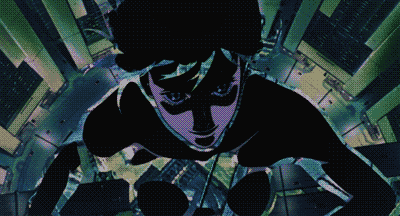
east versus west
So, when I went over the primer to the rise of Cyberpunk earlier, I left something out (on purpose!). During the 80s, there was another prime ingredient to the mix of the nascent genre’s formation: the rise of Japan as a technological leader in the global market. Before World War 2, and indeed, during it, American’s conceptualization of the future, was, well, American. They viewed themselves as the originator of innovation within the world and the blueprint from which the rest of the world should be based. However, this all changed in the post-war era as Japan began to participate in the market, leaving behind their isolationist ways-- suddenly, Japan was what the vision of the future looked like in American imagination-- the Tokyo urban sprawl.
The imagery of Japan is ubiquitous in western Cyberpunk, whether hardcore or or softcore or simply an incidental portrayal of futurism. Disney’s Big Hero 6 features San Fransokyo, San Franciso and Tokyo jammed together complete with neon signs in Japanese letters. During the 90s, Marvel launched Rampage 2099 and Spider-man 2099, both set in glittering neon cityscapes. The series Firefly featured a strange universe in which everyone seems to speak Chinese pidgins (but there’s no Chinese people in the show, funnily). MTV had Aeon Flux, a U.S. take on anime. Even movies like Total Recall borrowed the bright neon flavor. Video games such as Deus Ex and Cyberpunk 2077 feature these influences heavily, with less-bold-but-still-there influence being seen in games like Remember Me and Detroit: Become Human.
There’s an interesting cultural exchange going on between the east and west when it comes to Cyberpunk, as the 90s were rife with cyberpunk fiction in both places-- The U.S. saw The Matrix (which was inspired by Ghost in the Shell, as admitted by the Wachowskis in a phrasing that I find really annoying as an animator: “We want to make that but for real”.), while Japan had the seminal Ghost in the Shell and Akira. It’s interesting to note the stark contrast between western and eastern Cyberpunk-- eastern Cyberpunk misses entirely western Cyberpunk’s detective fiction roots, for one. For two, eastern Cyberpunk tends to concern itself more with philosophical questions about the nature of the soul in relation to technology and deep-seated cultural fears about weapons of mass destruction and government.
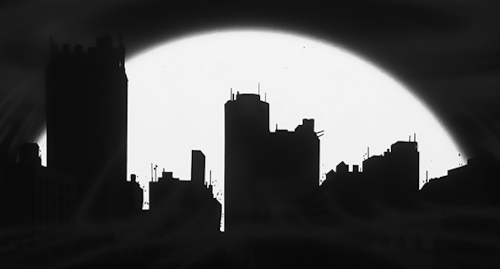
Neuromancer is deeply entrenched in eastern aesthetics-- many Japanese brands are brought up explicitly by name within the model (Mitsubishi, Sony, etc.). Gibson cites the “Kowloon Walled City” of Hong Kong as something that haunted him after he was told about it, and the idea of Coffin Hotels owes quite a lot to it. Gibson is quoted as saying:
“Modern Japan simply was cyberpunk. The Japanese themselves knew it and delighted in it. I remember my first glimpse of Shibuya, when one of the young Tokyo journalists who had taken me there, his face drenched with the light of a thousand media-suns - all that towering, animated crawl of commercial information - said, ‘You see? You see? It is Blade Runner town.' And it was. It so evidently was.“
One of Neuromancer’s primary settings is The Night City, a supposedly gaijin district of Tokyo on the bay-- this...sort of explains why there don’t seem to be a lot of Asian people in Asia, but the issue still stands. This isn’t a game-breakingly “I wouldn’t recommend this book” bad case, but it is something that I felt I should point out. Neuromancer is a foundational work to the genre, which means that not only are its successes carried over, but many of its flaws as well. Now, I don’t want this cricitism to sound like I think William Gibson is a raging bigot or anything-- I really don’t! I follow him on twitter and he’s a perfectly likable guy, actually. Problems aside, I really enjoy his work.
conclusions
Going into the future, I don’t think Cyberpunk is going away anytime soon, and certainly much of it owes its roots to Neuromancer. With shows like Altered Carbon and games like Cyberpunk 2077 on the horizon, I’m interested to see the ways in which our current economic political climate may effect what our vision of a technological dystopia may look like. Cyberpunk is easily one of the most interesting genres of fiction, and if you haven’t looked into it deeply, I highly recommend checking it out.
2 notes
·
View notes
Note
hey, i just saw your tag on the "haunting and possession belong to women" post and i was wondering if you had any recommended site to read about the trope? its really interesting to me, id love to read more about it!!
i actually remember reading a really interesting article aboutit a few years ago but i cant find it lol....
if you can find any sourcespls send them to me cos id love to do some more reading on this but it seemsgoogle doesnt like me today
ill summarise what i canremember, as well as pull some information on real life exorcisms (which is ofcourse important in examining fictional exorcisms which are inspired by them,and are also really interesting and enlightening in this case). ill alsoprecurse by saying that im gonna write a very western history because thatswhat im most familiar with, however there is something to be said about howacross the entire world almost every culture that has possession and hauntingmythology will have that mythology heavily rotate around women or at leastfeature women in a central causation or effect. but yes, this is a western viewand history:
women have historically had avery strict expectation of behaviour. a woman exhibiting any form ofindependent thought - e.g. insisting on rights such as property ownership,money ownership (yes this was an actual issue lmfao), voting rights, the rightto education; expressing any form of the existence of their sexuality; engagingin “male” hobbies, arts, and careers - was almost always diagnosed or atleast considered to have some kind of hysteria, to be crazy.
the trope of the possessedgirl in particular is synonymous to this. particularly in western storiesof “possession” (which are often told from a christian perspective), girlswho are possessed by a spirit exhibit traits described historicallyas “hysteria” and are presented as demonic. a girl will say vile things,insult men and the bible, she will be blatant about sexuality, and she will bedeemed as “possessed”. these are the same traits that society, inparticular western society, would use to diagnose women with hysteria or insanity.feminists were thought to be absolutely insane, sometimes possessed. often inchristian and religious lenses, the symptoms of mental illness (or what isperceived as a mental illness) are perceived as possession. almost allpossession narratives have a possessed girl, not a possessed boy, and almost all have a deeply religioustheme (not just because biblical demons are involved!). the behaviours ofpossessed girls also coincide with the image of women and girls as needing tobe kept “pure” - the standards of which reach a level of inhuman sterilitywhich, when pointed out by a woman falling out of these standards, are deemedas “horrific”.
theres also a subset of thisabout how exorcism became a major part of western culture again with the magiccraze of the 19th century and early 20th century, and that this increasedfascination and terror associated with religious punishments and demonicentities, along with the rise of the feminist movement and female independenceat this time, but thats a HUGE subset of history. like the magic craze involvesso many people and crazy aspects, its definitely more of a special interestkinda thing. but if you like reading about weird men doing rituals and jackingoff onto fruit, then 19th and early 20th century magic is fascinating. anywaythats a major part of why exorcism and possession is even such a common tropenowadays
here are some research paths for the possessed girl trope:
studying real lifepossessions - the easiest to find info on would be anneliese michel. massivewarning for abuse, neglect, horrific injury, etc.
how feminism was seen by menin the 19th and early to mid-20th centuries would be another good path
a major onewould be looking up the diagnosis and treatment of hysteria in the 19th century
looking into religious textson exorcisms
AFTER that, consider andresearch tropes of possessions in horror films, particularly ones featuringgirls being possessed
next:
the haunted woman is slightlysimilar - as in, some details cross over with the possessed girl. but thehaunted woman is a later horror trope, emerging with the rise of horror pulpand horror cinema in the 1930s, 50s, and most importantly in the 1970s. inthe 1970s, feminism reached a new wave after the post modernist thoughtemergence of the late 1960s, the decline of the presence of Christianity in thecultural focus, and a whole other amount of things.
withthe rise of second-wave feminist thought, particularly in the arts world andespecially in the film world, we began to see a rise in discussions of abuse,misogyny, and violence committed against women. the fact that women feared fortheir lives a lot more of the time than men did was now a commonly discussedtopic amongst not just scholars but the general populace as well.
someother factors for this discussion:
- therise of magic again in the 70s and 80s
- thecontinued perception of the woman as a symbol of purity
- theprevalence and importance of Stephen king’s writing and horror style in the 70sin particular. works such as the shining and carrie had a massive impact on the future role of horror – itpretty much solidified the female horror protagonist as a thing.
sonow we aren’t demonising women for being human beings – it is now far moreinteresting and popular in our horror to have a female protagonist bear thegrunt of ghosts, insanity, etc – as a representation of the ordeal ofwomanhood. women are haunted, not just by ghosts but by society’s pitfalls.they are lonely, hurt, burdened, but they survive.
there’salso another aspect – it’s the scaremongering. women in the 70s began to havemuch more autonomy than they ever had. this left them often unprotected andalone. the haunted woman often lives alone, and has no male lover in their lifeactively defending them. and now they are being run down the halls by a demonicentity with a vengeance. wouldn’t it be great if they had a big strong man protectingthem??? yeah.
this tropeis much more general and more flexible. there are far more interpretations onthis one, but its best to consider the context of the haunted woman trope. itsmodern interpretation was pretty much formed and solidified in the 70s and 80s,and updated a little to fit new production codes and expectations of gore,injury, fear post-9.11 (that’s an entire aspect of film history that is just….somuch…..)
somepaths:
-secondwave feminism
-theconstruction of purity in 70s and 80s horror, particularly in slasher flicks
-theshift of the western conscience away from Christian prominence
-the socialchanges of the late 1960s and 1970s
-the production codes of Hollywood (thisone is more subtle but i cannot stress enough how much this thing shaped what ourperception of a film is)
theother thing is to study the history of the film industry, not just film. for over a century it has been possiblythe most popularly viewed art form in the western world, and it is so importantwhen studying tropes like this to understand the industry workings that shape them.
i wish i could find the article cos it was rly good, but itwas quite a few years back. if you have any kind of access to a universitylibrary it might be good to look up some papers – there are miles upon miles ofstudies of the depictions of women in horror. also Men, Women, and Chain Saws: Gender in the Modern Horror Film byCarol J. Clover seems to be a good read, though ive only read a few chapters.
3 notes
·
View notes